 |
The Hissem-Montague Family  |
 |
The Hissem-Montague Family  |

Elizabeth was the youngest daughter of Gyles Heysham and Elizabeth Thornton. She was born in about 1667 in Lancaster.
On 9 February 1695 Elizabeth Heesham married Edmd. Thornton, of Oxcliffe near Lancaster, gent., at St. Mary's church, in Lancaster - from "English Marriages, 1538-1973." Elizabeth's mother was the daughter of Robert Thornton of Oxcliffe, so Edmund was probably a cousin. I think he was the son of (18) Thomas Thornton (c1635), Robert Thornton's eldest son. Thomas and his mother were co-executor's of Robert's will.
Elizabeth Heysham's brother, Robert, had twice married Thorntons. The first was the daughter and co-heir of an Edmund Thornton and the second the daughter of a Thomas Thornton, both drapers of London, as was Robert. If this is right then Robert's second wife may have been the sister of Edmund Thornton, his sister's husband. It was fairly common, after all, for sets of siblings to marry.
| The Thornton Family
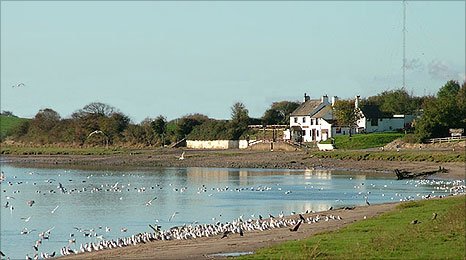 Oxcliffe The village sits on a small bluff on the Lune river where it takes a bend to the south. It is a township of scattered houses, from two to three miles west of Lancaster. Oxcliffe was held in the reign of Edward I under the Earls of Lancaster. There is today an E.E. Thornton & Son dairy in the village, on Moss road. At right it the Golden Ball pub on the shore of the Lune estuary in Oxcliffe. Across the river is a view of Lancaster castle, below. 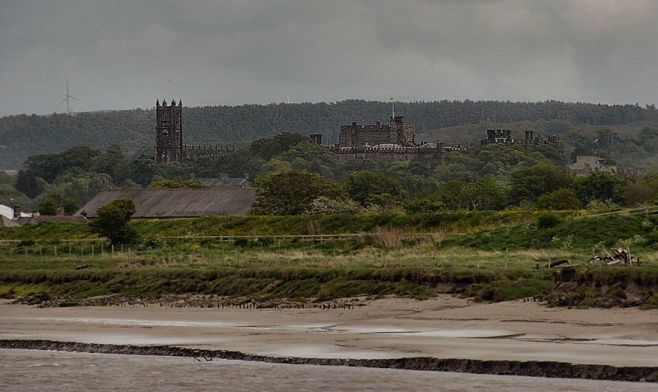 |
"Elizabeth w. of Edmd. Thornton of Ostcliffe" died and was buried on 06 May 1709 - from "Lancaster Parish Register, 1691-1748." When Elizabeth died her sons would have been from 4 to 12 years old. That's awfully young to lose your mother. The following are memorials for Elizabeth and other, presumably related, Thornton's of Oxcliffe in the church of St. Mary's, Lancaster.
"Here lyeth the Body of John Thornton of Oxcliff who Died February the 18th 1671 Aged 38 years; And also Robert son of John Thornton who Died June ye 6th 1672 aged 11 years; And also Elizabeth the Wife of Edmond Thornton of Oxcliff who Died May ye 3. 1709 in ye 40th Year of her age." - from "Remains, Historical and Literary Connected with the Palantine Counties"Edmund Thornton must have been closely related to John Thornton of Oxcliff, being most likely his nephew. There is also an Edmund Thornton of Oxcliffe who had his will administered in 1731. Not our man, but perhaps another nephew.
Edmund Thornton of Oxlistre, Lancs. then married Elizabeth Rollins [Rawlins], the daughter of William Rollins, innkeeper, on 4 June 1710 at the St. Peter church, Liverpool. That's less than a month after his first wife's burial.
"Edmd Thornton gen : Oxcliff" died and was buried on 04 August 1713 - from "Lancaster Parish Register, 1691-1748." When Edmund died his sons would have been from 8 to 16 years old. The boys got hit the worst way with both of their parents' deaths. So young to lose a mother, then to lose a father just when they hit an age where his guidance was needed. I suspect they were subsequently raised by their uncles, William Heysham, who died in 1716, and Robert, who died in 1723. I also assume that their step-mother, Elizabeth Rawlins, moved on, using her marriage settlement to smooth her way.
The will of Elizabeth's brother, Robert Heysham, of 1722 Robert makes note of ". . . John, Giles, and Robert Thornton the three children of my brother in law Edmund Thornton and Elizabeth his wife." Edmund and Elizabeth's children were,
(20) John Thornton (1697)
(20) Giles Thornton Heysham (1699)
(20) Robert Thornton (1700)
"John s. of Edmond Thornton of Oxcliffe" was baptized on 09 Sep 1697 at St. Mary, Lancaster - from Lancaster Parish Register. He outlived his mother and father, who died in 1709 and 1713, respectively, but himself died before he was very old, some time between 1724 and 1736.
John married Elizabeth, the daughter of Robert Haydock of Pheasant Ford, gent., on 7 October 1720 - from the "Miscellanea Genealogica et Heraldica" of 1884. Elizabeth Haydocke [sic], the daughter of Robt. Haydocke, was christened on 2 April 1695 in Burnley, Lancashire. Pheasant Ford is near Burnley. The Haydocks were a "family of great antiquity" - ain't we all! The village is 22 miles southeast of Lancaster.
| Haydocks of Burnley & Pheasant Ford
The Haydocks were a Burnley farming family. The name Pheasant Ford was originally Feysandforth, Heasandford, Hesandforth, and/or Heysandford, meaning high-sand ford or enclosure by the sandy ford. Also known as Easingford. "Dr. Whitaker states that correctly it is Hesandford. This estate belonged to Stansfield, constable of Pontefract Castle, during the "De Lacy" times, and in Plantagenet times granted to one Haydock, and consisted of land lying between the Brun and the field known as Saxiefield." - from "Transactions of the Lancashire and Cheshire Antiquarian"Simon Haydock acquired the estate by marriage to Joan, the daughter and heir of Giles Stansfield, in 1532. Evan Haydock the son of Simon died in 1596 holding the manor of Heysandforth, and messuages, water-mill, &c., in Burnley and Briercliffe of the queen as of her duchy of Lancaster in socage by 1d. rent. Simon his son and heir was forty years of age. Simon Haydock was returned as a freeholder in 1600, and died in 1607, leaving a son and heir Evan, ten years old. Evan Haydock was a convicted recusant in 1626, paying double to the subsidy. He died in 1634 holding the capital messuage called Heysandforth, with other messuages in Burnley and Briercliffe, of the king as duke in socage by 1d. rent. Simon, his son and heir, was seven years of age. The family subsequently conformed, and retained Heysandforth for some time. - from "British History Online" (18) Simon Haydock (1627)He married Mary Townley, the daughter of Robert Townley of Royle, a local estate. (19) Robert Haydock (1655)(18) Simon Haydock (1627) He married Ann Ormerod. He died on 8 September 1698 and was buried at St. Peter church, Burnley. His widow, Ann, made her brother, Oliver Ormerod, tutor and guardian of her children John, Mary, Elizabeth and Ann Haydock on 6 August 1701. The latter event probably occurred at the time Ann married Alexander Kershaw, gent., of Towne House, Rochdale. (20) John Haydock (1686)(18) Simon Haydock (1627) (19) Robert Haydock (1655) Upon his death in 1745 the Pheasant Ford manor was sold to a Mr. Hargreaves. (20) Elizabeth Haydock (1695)(18) Simon Haydock (1627) (19) Robert Haydock (1655) She married John Thornton. |
John Thornton was mentioned in the will of his cousin, Elizabeth Heysham, the daughter of William Heysham of Barbados, which was proved on 5 June 1721.
"To my cousin John Thornton I give one hundred pounds
To my cousin Giles Thornton his Brother the life [Issue?] of One hundred pounds
Item I give and bequeth to my Cousin Robert Thornton their younger Brother one hundred pounds in Money
. . .
Item I give to my Cousin John Thornton and his Wife ten pounds each for Mourning."
John was also mentioned in the will of his Uncle Robert Heysham, proved on 15 March 1723. John would have been 26 years old at the time.
"Item, I give and bequeth unto John, Giles and Robert Thornton the three children of my brother in law Edmund Thornton and Elizabeth his wife both deceased the sume of twenty pounds apiece for Mourning."
He was mentioned again later in the same will.
"Item, as for and concerning my Real Estate both Free hold and Copyhold I give devise and bequeth unto my said Nephew John Thornton All that Messauge or Tenement called Castlehill house and a Field called Kellett's Croft and the Barn there with the Appurtenances Situate and being in the Town and parish of Lancaster formerly my late wife's Father's Estate [Jane's father was Thomas Thornton], now in the Occupation of my said Brother Robert Carter, or his Assignes To hold the said Croft and Barne with the Appurtenances from and immediately after my decease to my said Newphew John Thornton his heirs and Assignes for ever which premisses being part of the Estate settled on my said late wife my Will is that my said son Robert and his heirs shall confirme this my Bequest to the said John Thornton and his heirs And in default thereof my Will is that there be paid to my said Nephew John Thornton his heirs and Assignes the sume of five hundred pounds."That is, Robert Heysham's son should confirm this bequest of the house, but if he doesn't then John Thornton should be given £500 from Robert's estate. Was a house valued at £500 a lavish one for this period? I don't know whether John got the house or the cash.
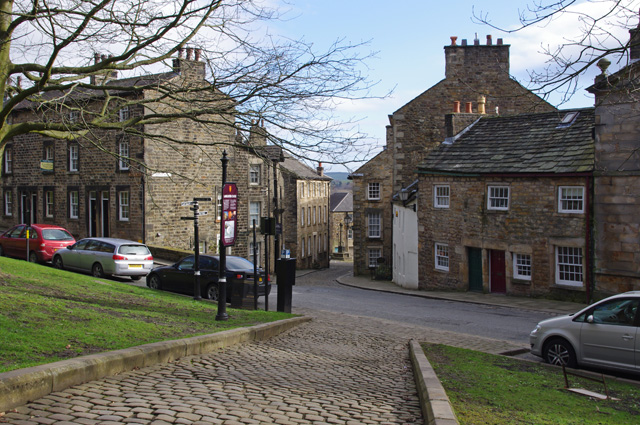 Presumably Castlehill house was a home on the hill in Lancaster which was surmounted by the great castle. Castle Hill road is a Georgian cobbled street situated between the Judges Lodgings and Lancaster Castle. Today there are 31 properties on the hill of which 18 are residential, and 7 of those are apartment buildings. A scene from Castlehill road is to the right. The castle is behind and above the photographer.
Presumably Castlehill house was a home on the hill in Lancaster which was surmounted by the great castle. Castle Hill road is a Georgian cobbled street situated between the Judges Lodgings and Lancaster Castle. Today there are 31 properties on the hill of which 18 are residential, and 7 of those are apartment buildings. A scene from Castlehill road is to the right. The castle is behind and above the photographer.

The photograph to the left, also of Castlehill road, but to the right of the previous photo, was the approximate location of Number 3 Castlehill road, the home of (18) Thomas Thornton (c1635) in 1684. Thomas was the father of Jane Thornton, Robert Heysham's wife. He was also the father, I believe, of Edmund Thornton, John's father. Thomas Thornton died in the fall of 1684. The house, on the left side of the road, just around the corner from the castle, looks to be situated in a prestigious location, suitable for a wealthy merchant like Thomas. Another reference calls this the "last house on Castle Park." Castle Park is the road on the south side of the Castle.
Robert Carter was John's uncle, who had married Anne Heysham. He did well by his connection with Robert and William Heysham, becoming mayor of Lancaster in 1699, 1707 and 1717. That is, he lived at Number 3 Castlehill road while mayor.
Kellett's Croft was,
"A very valuable close of land, called Kellet Croft, situate in front of the Lancaster and Carlisle Railway Station, at Lancaster . . ." - from the "Lancaster Gazette" of 12 July 1856 as displayed at "Genes Reunited"In 1822 this was referred to as
"All that close and land, situate at Castle-hill, in Lancaster, called Kellet Croft, with the Coach-house, Stabling, and Buildings thereon, containing 6a. 1r. 3op. statute measure, or thereabouts . . ." - from the "Lancaster Gazette" of 28 September 1822This location would be on the west side of Lancaster, just below Castle Hill. The property was bounded on the south by Meeting House lane, on the north by West Road, to the west by Fairfield road, and to the east by the Railway station. There is evidence that in Roman times this was a burial field. In the 1720's this would have been farm land. Note that in 1684 Meeting House lane was known as Kiln lane and the map of that time called it the "Lane into the fields."
In 1724 there was a dispute over the administration of the will of John's grandmother, Elizabeth Heysham.
"1724/3 John Thornton, gent. c. Robert Carter, gent., of Lancaster, executor of Elizabeth Heysham, widow, of Lancaster, dec.Robert Carter was not good with money, losing his iron trade due to high-living and dying poor despite receiving a number of government positions through his rich brothers-in-law. John was probably upset enough about the disbursement of funds from his mother's will and the disappearance of valued keepsakes to "ask to see the books."
ARCH.CT.RICHMOND, Carter appellant [1723]
Failure to exhibit inventory of goods of Elizabeth Heysham" - from "Borthwick Texts and Calendars"
John was also mentioned in the 1736 will of his younger brother, Giles Thornton, but was identifed as deceased by that time. According to Angela Heysham, John died in 1720, but this must be a mistake. John could not have died before 1724, when he was 27 years old.
John's wife, Elizabeth, was still living in 1736. Apparently John had inherited the Oxcliffe estate of his father, Edmund Thornton of Oxcliffe, which had devolved to Elizabeth. John's brother, Giles, expected to receive the estate upon Elizabeth's death, so she must have had no children. Note that Kellet's Croft, a property John Thornton had inherited from Robert Heysham, was, in 1738, "now in the possession of G.T.H. [Giles Thornton Heysham]."
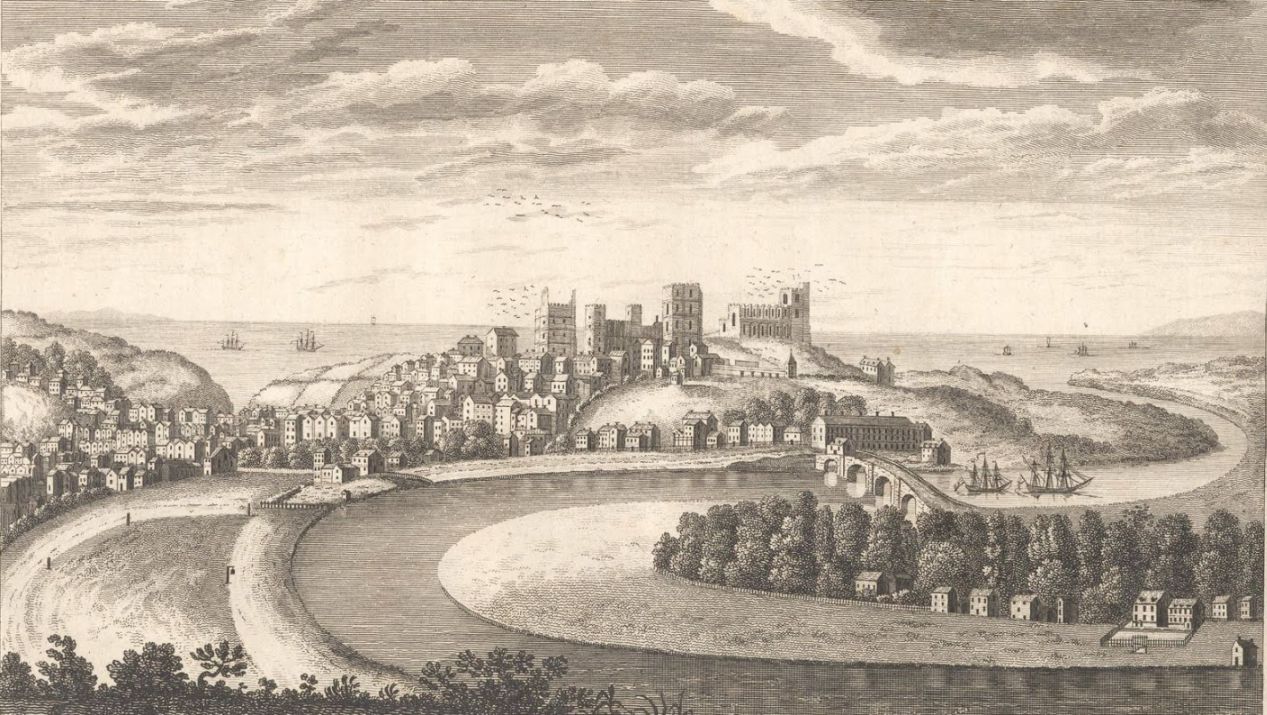
Giles Thornton of St. Botolph's, Aldgate. He was baptized in September 1699 - from the "Miscellanea Genealogica et Heraldica". The son of Edmund Thornton and Elizabeth Heysham, which I infer through his inheritance as a "cousin" of Robert Heysham. His mother, Elizabeth, died when he was 9. When his father, Edmund, died Giles would have been only 13 and his brother, Robert, 8. I suspect Giles and Robert were subsequently raised by their uncles, Robert Heysham, who died in 1723, and William Heysham, who died in 1716.
As an adult he was living in St. Botolph's, Aldgate, London. I suppose his residence there had something to do with his uncles' success as London merchants and Members of Parliament. He may have been given a position in the firm, perhaps as a clerk in the compting house, or a government office. Giles' cousin, Robert Heysham, lived on Billiter Square, off Fenchurch avenue, just three blocks away. His cousin, William Heysham, lived downriver in Greenwich, but also had a townhouse in Bloomsbury. Note that William had married into the Perry family in 1719, making Micajah Perry, an important tobacco merchant and Lord Mayor of London in 1738, his brother-in-law.
St. Botolph's, Aldgate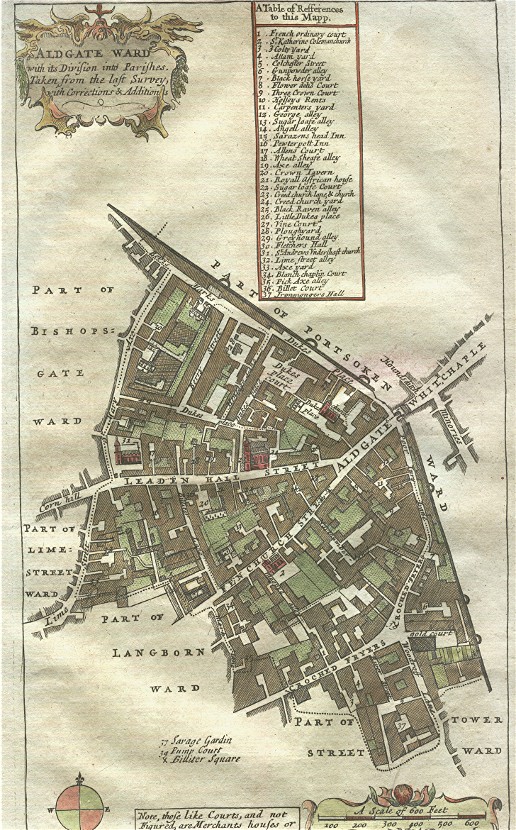
The parish of St. Botolph Without Aldgate was part in the City of London and part in the County of Middlesex, the East Smithfield Liberty. It extends from Aldgate High Street to the junction of Fenchurch Street and Leadenhall Street and gets its name as one of the eight gates to the walled City of London. Below is a print of St. Botolph's church and "Old Houses on the North West Corner of the Minories and Aldgate," dated 1810. The Minories is a street at right angles to Aldgate road, just before the latter splits into Leaden Hall and Fenchurch streets. In the print, the observer is on the Minories looking toward St. Botolph's church, which faces onto Aldgate road. By the way, the Minories refers to a nunnery that used to stand where the old mint, now Barclay's, is today. 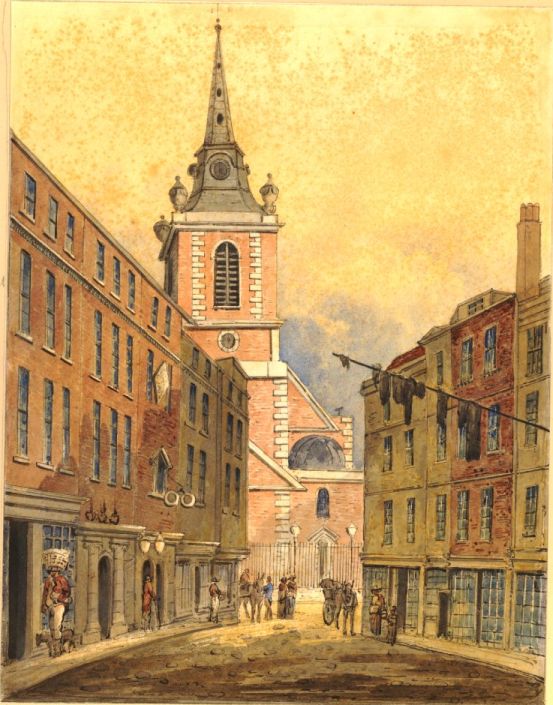
|
 The grant of arms William Heysham received in 1723 would have applied to Giles as a descendent of Gyles Heysham, via the female line.
The grant of arms William Heysham received in 1723 would have applied to Giles as a descendent of Gyles Heysham, via the female line.
On 7 December 1726 Giles' cousin, William Heysham, was the plaintiff in a trial for forgery against William Rhodes held at the Old Bailey. Giles was a witness, though when he deposed that William was out of town when a contested power of attorney was supposedly drawn up, written evidence was entered contradicting this. Did Giles perjure himself or was he simply mistaken?
Giles married Anne Beckerton in about 1726 in St. Dionis, London. A daughter, Elizabeth, was born in 1727, and a son, Robert, in 1729. Both were baptized in St. Dionis Backchurch, on Fenchurch street, in London, see below.
In 1732 a son, Giles, was born in St Botolph Without Aldgate, London, but he soon died.
Giles' cousin, William Heysham, had died in 1727, but his wife, Sarah Perry Heysham, undoubtedly inherited his estate. Giles' other cousin, Robert Heysham Jr., who had no family, died in 1734, at the age of 22. Robert's will, dated 6 July 1734, gave Stagenhoe, Hertfordshire, with other estates, which included those at Little Munden and Weston, to Giles Thornton of St. Botolph's, Aldgate, for life, with the remainder to his son, Robert [I believe that to be (21) Robert Thornton Heysham, below], for life, remainder to the first and other sons of the last named Robert successively intail male, remainder to Robert Thornton the elder, Giles Thornton's brother, upon his taking the additional name of Heysham.
Note that by 1734, when Robert Heysham Jr. died, the surviving descendents of (18) Giles Hyshame (1635) were,
- Anne's daughter, Margaret Carter (1687), who married Foster Cunliffe, a wealthy Liverpool merchant, and received a £1000 portion from her uncles.
- Geyles' daughter, Elizabeth (1691). who married William Robinson, the heir to the Lytton fortune and Knebworth house.
- Hester's daughter, Jane Barker (1703), who married Matthew Hall, a "woollen draper in ye Strand," in 1721. Their daugther, Susan Hall (1722), would marry Fitz-William Barrington, the son of Sir John Barrington, Baronet, and great-grandson of Sir William Lytton, of Knebworth. So many connections . . .
- Robert Heysham's children had all d.s.p.
- William Heysham's children had all d.s.p.
- Elizabeth's surviving sons, Giles and Robert Thornton, John having died by this time, who inherited Robert Heysham's fortune.
Giles Thornton Heysham inherited the Stagenhoe manor, in the parish of St. Paul's Walden, in 1734 on the condition of his taking the additional name of Heysham.
| Stagenhoe Park
There are two great 18th century mansions in the village, St. Paul's Walden Bury, home to the Bowes Lyon family since 1725 and birthplace of the late Queen Mother, Lady Elizabeth Bowes Lyon, and Stagenhoe Park. The Stagehoe estate was owned by the Pilkington family during the 15th century. The old manor house was built in the 17th century by Sir John Hale. He was a younger son of William Hale, Esq., whose father, Richard, had made the family fortune in London as a grocer and bought an estate in King's Walden. "This manor came to Sir John Hale, his youngest son, who died in 1672, leaving issue an only daughter, Rose, wife of Sir John Austen, of Bexley, Co. Kent, Bart."Rose married Sir John Austen, the eldest son of Sir Robert Austen, baronet, of Hall Place, in 1661. They inherited the estate upon Sir John Hale's death in 1672. Austen sold the estate when he fell into debt. Note that John Austen's London residence was in Bloomsbury Square. William Heysham would later live in Bloomsbury Square. Could this be the same place, procured by William at the same time Robert bought the Stagenhoe estate? "Their eldest son, Sir Robert Austen, Bart. who succeeded in the possession of the manor, sold it about the year 1704 to Robert Heysham, Alderman of London [The state was sold by Sir Robert Hale to Robert Heysham, a London draper, for £18,284 in 1703], who died in 1722, leaving an only son Robert. This Robert the younger died unmarried in 1734, in the twenty-second year of his age, bequething this and other estates to his kinsman, Giles Thornton, of St. Botolph's, Aldgate, on condition of his taking the additional name of Heysham. "The old manor house was consumed by fire on 29 November 1737 "occasioned by the carelessness of some workmen employed thereon in leaving some shavings in a room in which was a fire." The present house, in the Georgian style, was built by Giles Thornton Heysham in 1740. Originally of two storey's, it was later extended with a third floor. "On the death of Giles Thornton-Heysham, in 1767, the manor came to his eldest son, Robert Thornton-Heysham, who, by Hannah, his wife, daughter of Jonathan Jepps, of this parish, had issue three sons, of whom Robert Thornton-Heysham, the eldest, succeeded to the manor in 1781. He sold it to Captain the Honble. Arthur Duncombe [later Admiral, RN, and Civil Lord of the Admiralty], who again sold it, in 1843, to Henry Rogers, of Boston, Co. Lincoln, Esquire, who died on the 12th January, 1866, whereupon it came to his son Henry, who shortly afterwards sold it to James [Sinclair], the fourteenth Earl of Caithness, . . ." - from the "History of Hertfordshire" by John Edwin Cussans.James Sinclair (1821-1881), made 14th Earl of Caithness in 1856, and his wife, Marie de Pomar, were the owners of record in 1871/2. James was succeeded by his son, George, 15th Earl from 1881 to 1889, who was succeeded by his cousin, James Alexander Sinclair. John Sutherland Sinclair, who became 17th Earl of Caithness in 1891 when his father, James Alexander, died, wrote a lecture while living at Stagenhoe Park in 1875, apparently while a guest of his uncle. By the way, before he became Earl John lived in North Dakota where he ranched 3040 acres near Lakota. Sir Arthur Sullivan, of Gilbert & Sullivan fame, rented the home as a summer retreat between 1884 and 1886 and wrote one of his "serious" operas, "Golden Legend," there. He tried to buy the estate when it was put up for sale 7 years later, in 1893, but was outbid. The estate was sold to William B. Hawkins. During World War II Stagenhoe Park was used as a maternity hospital and afterwards it was a boys prep school. The philanthropist Sue Ryder then bought the estate in 1969 and established it as a nursing home. Today it comprises only 8 acres, but I believe it was originally of 567 acres, including a farm and adjacent cottages. Below are some photos of the mansion under repair. |
I can't be certain where this fits, but in 1735 Alexander Pope wrote a poem, "A Sermon Against Adultery," with the following closing lines,
"Me, naked me, to posts, to pumps they draw,
To shame eternal, or eternal law.
Oh Love! be deep tranquility my luck!
No mistress H-ysh-m near, no lady B-ck!
For, to be taken, is the devil in hell;
This Truth, let L-l, J-ys, O-w tell."
Another son named Giles, perhaps in honor of the earlier one that died in 1732, was born at Stagenhoe in 1736 in Saint Pauls, Walden, Hertford, England. Other children followed.
Giles also inherited Robert Heysham's properties of Little Munden and Weston.
| Little Munden
"Michael Woodcock was lord of this manor in the twenty-first year of the reign of Elizabeth, and by him it was sold to Sir Peter Vanlore, of Benington, Knt., although he had previously settled it upon his son Michael Woodcock, junior, and his heirs male, on the his marriage to Dorothy, daughter of William Woodhall. In 1614 Sir Peter Vanlore settled the manor upon his daughter Ann, on her marriage to Sir Charles, son of Sir Julius Caesar. Sir Charles Caesar had possession of the manor for several years; but the title being defective in consequence of the entail by Michael Woodcock, Sir Peter Vanlore applied to the Court of Chancery to be relieved against Woodcock and Woodhall, where-upon the latter repaid the purchase-money to Sir Peter, and by an Act of Parliament passed in 1623-4, the manor was conveyed to Edmund Woodhall. This Edmund Woodhall was Registrar of the Prerogative Court of Canterbury, and at his death, in 1638, he left issue by Margaret, his wife, daughter of Anthony Law, of London, two sons and four daughters. Edmund, his eldest son, succeeded him in the manor. He had issue Edmund and John, who successively inherited the manor, but both dying unmarried, it came to their sisters, Elizabeth and Mary. The former also died unmarried, whereupon Mary became sole heir. She was married to Edmund Thornton, of London, by whom she had two daughters, Mary and Jane. Robert Heysham, of London, married Mary, and on her death he married her sister Jane. By the latter he left issue an only son Robert, who died unmarried in 1734, in the twenty-second year of his age, bequeathing his manors of Little Munden and Stagenhoe, in the parish of St. Paul's Walden, and other estates, to his kinsman, Giles Thornton, of St. Botolph's, Aldgate, and his heirs in tail male, on condition of his assuming the additional name of Heysham. On the death of Giles Thornton-Heysham, in December, 1767, the manor came to his eldest son, Robert Thornton-Heysham, who died at Yarmouth, Co. Norfolk, in September, 1781; and to him succeeded his eldest son, also named Robert Thornton-Heysham, who, in 1816, sold this manor [Little Munden] to Nathaniel-Snell Chauncy, Esquire, second son of Charles Snell, of London, . . ." - from the "History of Hertfordshire" by John Edwin Cussans The manor house, a 16th century construction known as Lordship farm, shown to the left, still exists today, now a bed and breakfast. It is situated about halfway between Dane End and Green End. |
| Weston and Weston Argentien Manors
Weston is a village in the north of Hertfordshire. In the 13th century Sir Richard de Argentein [Argent], a crusader, held a manor near the village, which thus became Weston Argentein. At about the same time "the Hertfordshire manor of Weston" was held by the Bigod family, earls of Norfolk. Both estates passed through many hands after this, eventually together after 1596. ". . . Sir Henry Puckeringe, alias Newton, Bart., . . . who, in 1664, conveyed it to John and Bernard Hale, Esquires. On the marriage of Rose, only daughter of the said John Hale, with John, only son of Sir Robert Austen, of Bexley, Co. Kent, Bart. Sir John and Bernard Hale [conveyed?] this manor in trust to the use of the said John Austen and Rose, and their heirs. John Austen, who succeeded to the Baronetcy in 1666, survived his wife, and on his death i 1698, the manor came to his son, Sir Robert Austen, Bart., who, in September, 1703, conveyed it, together with the manor of Stagenhoe, in the parish of St. Paul's Walden, to Robert Heysham, Alderman of London, who died in February, 1722, leaving an only son, Robert, who succeeded him. This Robert the younger died unmarried in 1734, in the twenty-second year of his age, bequeathing this and other estates to his kinsman, Giles Thornton, of St. Botolph's, Aldgate, on condition of his taking the additional name of Heysham. On the death of Giles Thornton-Heysham, in December, 1767, the manor came to his eldest son, Robert Thornton-Heysham, who, by Hannah, his wife, daughter of Jonathan Jepps, of St. Paul's Walden, Esq., had issue three sons, of whom Robert Thornton Heysham, the eldest, succeeded to the manor in August, 1781, being then but twelve years of age. By Indenture dated 12th November, 1852, he conveyed the manor to Samuel Adams, of Ware, Esquire, who, on the 29th September following, conveyed it to Robert Pryor, of High Elms, Watford, Esquire, the present possessor." - from the "History of Hertfordshire" by John Edwin Cussans |
There is a court case in 1737, Heysham and Bowyer v. Trubey, in which it was held that a bankrupt had no interest and that his assignees only could oppose a will. So what do we think this means? I can only suspect that someone contested the will of Robert Heysham Jr., but what interest Trubey had I do not know.
The old Stagenhoe manor house was consumed by fire starting at "about 12 at night" on 29 November 1737 "occasioned by the carelessness of some workmen employed thereon in leaving some shavings in a room in which was a fire." The present house, in the Georgian style, was built by Giles Thornton Heysham in 1740.
A daughter, Sarah, was born in 1737.
From the UK Archives are the records of Houghton, Craven and Co., Solicitors of Preston, Lancashire:
24 September 1738 - "Release for £140:If Charles Richard Thornton was Robert's cousin, then the "John Thornton late of Preston, esq" could not have been Robert's brother, John, who died between 1722 and 1736. This John must have been Robert's uncle, and a brother of Edmund Thornton of Oxcliffe. The next citation seems to underwrite this.
(i) Giles Thornton Heysham of Stagenhoe in the parish of St. Paul's Walden, co. Hertford, esq., cousin and heir of Charles Richard Thornton, late of Preston, gent., decd., who was the only son and heir of John Thornton late of Preston, esq., decd., Anne his wife and Robert Thornton of Stagenhoe, gent., his brother,
(ii) Charles Gibson of Preston, gent.,
(iii) John Walshman of Preston, innkeeper
-- 2 closes called the Marfield or Narfield and further field, 6ac., in Preston, on the north side of a lane leading to a place called the two yates formerly in the possession of Agnes Patten, widow, William P., her son and John Melling, late in the possession of John Thornton
-- also Release for £600:
-- a dwellinghouse with a dyehouse and stable in Preston and near a place called the Schoolhouse, 1 close at the back of the messuage called the Millfield, 1ac., in the tenure of John Sturzaker, the above two closes and 1 close in Fishwick called the Fishwick Field formerly 2 closes called the Intack and Kellet wife Croft, 2ac.1r., the inheritance of John Bostock, now in the possession of G.T.H. [Giles Thornton Heysham], also a pew in the Gallery on the South side of the parish Church of Preston adjoining E. to a pillar that separates the same from another pew belonging to the Rev. Samuel Peploe, clerk, Vicar of Preston, and adjoining W. another pew late belonging to Robert Chaddock of Preston, esq., decd.
-- Witn. Thomas Starkie, Robert Bridge, Ralph Assheton. Seals."
"Gray's Inn Admission Register," 1 December 1691 - "John Thornton, second son of John T., of Oxcliffe, parish of Lancaster, gent."
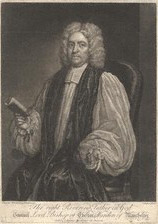 That would explain the family relationship; Giles and Charles Richard were both sons of Thorntons of Oxcliffe. However I think their family originally came from Hull, in Yorkshire. Samuel Peploe (1667-1752), left, whose pew was referenced above, was the vicar of Preston, Lancashire in 1700. He was later the Bishop of Chester.
That would explain the family relationship; Giles and Charles Richard were both sons of Thorntons of Oxcliffe. However I think their family originally came from Hull, in Yorkshire. Samuel Peploe (1667-1752), left, whose pew was referenced above, was the vicar of Preston, Lancashire in 1700. He was later the Bishop of Chester.
In November 1739 "Giles Thornton Heysham, of Stagginhoe, Esq." was on of three "Gentlemen out of the Several Counties, for his Majesty to prick down one to serve the Office of Sheriff for the Year ensuing" for Hertfordshire - from "The Political State of Great Britain" of 1739. The others were Benedict Ithell of Preston and Samuel Vanderplank of Little Weyondley. I show, however, that the Sheriff in 1740 was Willam Shaw. Benedict Ithel was Sheriff in 1752 and Giles Heysham in 1755. Vanderplank was never selected.
The Stagenhoe mansion was rebuilt over three years in the Palladium style and the Heysham's returned to it in 1740. A son, Edmund, was born in 1740.
On 27 January 1753 the following was signed,
"Lease for a year at peppercorn rent: for 5/-: Giles Thornton Heysham of Stagenhoe, co.Hertford, esq., Fitzwilliam Barrington of Lilley, co. Hertford, esq., & Elizabeth Barker of Lilley, gentlewoman, to John Loxham of Kirkham, gent. -- Wesham Hall alias Wesham House, & closes as 81 & cottages as 80 called Lawsons, Southworths, & Greenalghs -- Witn: William Townsend, John Pierce. Heraldic seals"Wesham House is in Preston, Lancashire. Since the Haydocks, the family of Giles' sister-in-law, above, were from Preston, I'll assume that's where this property came from. Fitzwilliam Barrington (1708-1792) was the eighth Baronet, the son of Sir John Barrington. He married Susan Hall, the grand-daughter of Hester Heysham (1661). See a connection to the Viscount Barrington family in the marriage of Robert Thornton Heysham and Francis Price, below. Elizabeth Barker, of Lilley, Herts, a gentlewoman, is not Elizabeth, the daughter of Hester Heysham and Hugh Barker, who died unmarried in 1723.
1755, George II. "Sheriffs Appointed for the Present Year . . . Hertfordshire, G. T. Heysham, esq. . . ." - from "The chronological historian; or A record of public events illustrative of the history of Great..." by William Toone. The following is from the list of Sheriffs.
"HertfordshireWilliam Robinson Lytton of Knebworth was sheriff in 1710 and John Robinson Lytton was in 1758.
. . .
31 January 1754 Fitz William Barrington of Lilley, esq.
29 Jan. 1755 Giles Thornton Heysham of Paul's Walden, esq." - from "Lists and Indexes" of 1897
Gyles qualified to be a Deputy Lieutenant for the county of Hertfordshire. I don't know if he was selected for the position.
"MICHAELMAS SESSIONS, 1758.
William Young, esquire, mayor, and George Pembroke, esquire, took the oaths of allegiance, abjuration and supremacy, and signed the declaration. Ibid./9.
John Ashel, Bucknal Gyles, Thornton Heysham and Thomas Gape, esquire, did the like, in order to qualify themselves as deputy-lieutenants for the county of Hertford. Ibid." - from "Hertford County Records"
A Giles Thornton Heysham, esq., of Hertfordshire had a subscription to the Gentleman's Magazine.
A listing of Parks in Hertfordshire was taken in 1725 with Robert Heysham listed as the owner of Stagenhoe, St. Pauls Walden. In 1766 Giles Thornton Heysham was listed as the owner of Stagenhoe, an estate of 250 acres. In a listing of parks in 1799-1812, Robert Thornton Heysham was listed as the owner of Stagenhoe, but the property had shrunk to 100 acres. In 1821 it had recovered to 140 acres - from "Parks in Hertfordshire Since 1500" by Hugh Prince.
Giles died of smallpox on 14 December 1767, per "Musgrave's Obituaries," and was buried at Stagenhoe on 20 December 1767.
"The state was sold by Sir Robert Hale to Robert Heysham, a London draper, for £18,284 in 1703. In 1737, about 12 at night on 29 November a fire broke out at Stagenhoe and in a few hours burnt down this fine seat. Losses amounted to £10,000. It was occasioned by workmen running of lead for weights in some new buildings just finished. Only the cellars and lower portion of the stables and parts of the Jaden House . . . The mansion was rebuilt over three years in the Palladium style and the Heysham's returned to it in 1740. Twenty-seven years later, in 1767, Squire Giles Thornton Heysham contracted and died from smallpox (despite the availability of free inoculations at Hitchin). Giles successor was Robert Thornton Heysham who married the Pauls Walden girl, Hannah Jepp, daughter of Jonathan. As the Jepps bought property at Preston Green, it is worthwhile mentioning them : Richard Jepp of Stagenhoe bottom Farm is included in the Poor Law accounts between 1768 and 1792 . . . When the purse strings of country gentlemen began to be stretched during the French revolution and the Napoleonic Wars and in order to pay for additions to the estate, Thornton Heysham was forced to execute a mortgage of £11,000, land elsewhere was sold, Stagenhoe Bottom Farm was let out to William Bates of Harpenden and the mansion was taken by the wealthy Carbonell family who were wine importers. It proved impossible to save the estate which was finally sold to Charles Baron Feversham of Duncombe Park, York for £25,000. After mortgages had been satisfied, Heysham was left with £1,278, a sad ending for a family that had rebuilt the mansion and improved the land for more than a century." - from the "History of Preston in Hertfordshire" website
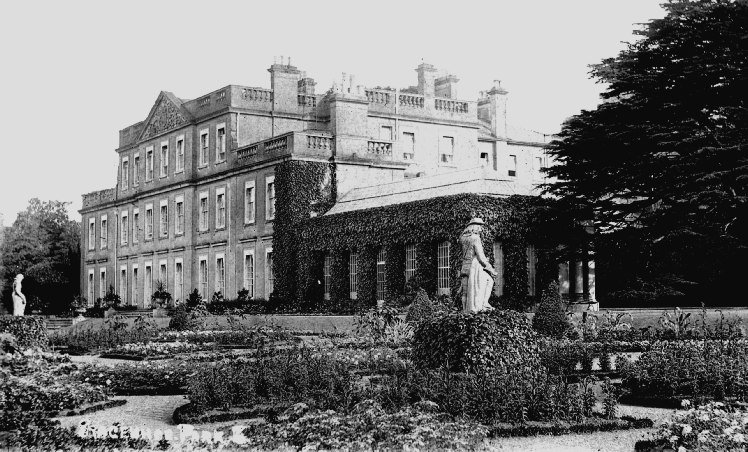
Giles' will was proved in January 1768. In the will he was named as Giles Thornton Heysham of Saint Paul's Walden, Hertfordshire.
"In the Name of God Amen,
Giles Thornton Heysham of Stagenhoe in the parish of Saint Pauls Walden in the county of Hertford Esquire being in perfect health and of sound Mind, Memory and understanding blessed be God and considering the uncertainty of human life and being desirious to settle my temporal affairs do make and ordain this my last Will and Testament in manner and form following.
Whereas I am intitled to the Reversion in fee expectant upon the Death of Mrs. Elizabeth Thornton Widow of my late Brother John Thornton deceased of and in a certain freehold Estate at Oxcliffe in the parish and County Palantine of Lancaster and Whereas I have lately purchased to me and my heirs of and from Joseph Gregoy certain freehold and Copyhold Lands situate in or near Bendish in the parish and Manor of Saint Pauls Walden in the said County of Hertford and have also lately purchased to me and my heirs of and from Thomas Hurst Esquire and Jane his Wife and Thomas Hurst their son a certain freehold Estate situate in the several parishes of Harvard, Stork, Butterbury, East Harringfield and West Harringfield or some or one of them in the County of Essex and also a small Copyhold held of the Manor of East West Harringfield aforesaid Which several Copyfholds I have surrendered to the use of my Will And whereas such purchases where so made by me for the convenience and Advantage of my other estates which I now enjoy in the said Countys of Hertford and Essex and by which means the same are and will be considerably increased in Value and,
Whereas I being Tenant for Life only of my said other Estates which I enjoy under the Will of my kinsman Robert Heysham Esquire deceased and at my coming into possession thereof I found greatest part of the Houses, Devises and Buildings belonging to several of the farms at Hoddeston, Munden, Weston, Stevenage and Harringfield in the Countys of Hertford and Essex aforesaid in a ruinous and decayed condition some of which I was necessarily obliged to rebuild and others to repair at a very great Expense which I did nevertheless which I did nevertheless [repeat in original] in full expectatin that my first Son Robert Heysham and on whose Issue Male such the said Estates whereof I am Tenant for Life as aforesaid are entailed by the said Will of the said Robert Heysham and whom I hope will reap the full Benefit of my Improvements shall reimburse such my Expenses to my dear Wife and children in manner hereinafter mentioned.
Wherefore my Will is and I do hereby Give and Bequeth unto my said Son Robert all and Singular my aforesaid Estates Lands Tenements and Hereditainments both freehold and Copyhold in the said several Countys of Lancaster Hertford and Essex with their and every of their Rights Members and Appurtenances whatsoever and all other my Lands Easements and hereditainments whatsoever and wheresoever whereof I am any ways seized in possession Reversion Remainier or expectation to hold the same unto my said Son Robert and his Heirs for ever and,
I also Give and Bequeth unto my said Son Robert his Executors and Admrs [Administrators] all my personal Estate whatsoever and wheresoever which I shall dye possessed of or interested in Under this Restriction and the said Devises of my said Real and personal Estate are so made unto my said Son Robert as aforesaid upon this express Condition that he my said Son Robert shall and do within one Calendar Month after he shall have attained his age of One and Twenty years pay or secure to be paid unto his Mother my dear Wife Ann Thornton Heysham and unto his Brother and Sisters my dear Children Giles Ann Elizabeth and Jayne the Sum of One Thousand five hundred pounds apiece which I do hereby Give and Bequeth unto them respectively for their respective portions and for their better support and Maintenance in the world together with Interest for the same in the mean time at and after the Rate of four pounds per cent per annum to be computed from the Time of my Death and in Case my said Wife or any of my said last named Children shall happen to die before my said Son Robert shall have paid or secured their respective Shares portions of Interests in manner before mentioned Then I will order and direct that the Share portion and Interest of him her or them so dying shall go and be divided unto and amongst the Survivor and Survivors of them equally, each Survivor and Survivors to take as Tenants in Common and not as joint Tenants,
But in case my said Son Robert shall as soon as he shall have attained his said Age of One and Twenty years or within one Calendar month afterwards neglect or refuse to comply with this my Will Then the Devises and Bequests hereby made unto him as aforesaid shall and I do hereby declare the same to be absolutely void And In that Case I do hereby Give devise and Bequeth all and whatsoever I have hereby given or intended to have given unto him as aforesaid unto and amongst my said dear Wife and other children or unto such and so many of them as shall be then living equally to be divided amongst them share and share alike and,
I do hereby make ordain constitute and appoint my said Wife and my dear Brother Robert Thornton Executors and Trustees of this my Will for the purposes before mentioned to whom I also this Guardianship [Cgreane] Management of the persons fortunes and Education of all my said Children during their respective Minoritys.
In witness whereof I have hereunto set my hand and seal this Eighteenth Day of September in the year of our Lord One Thousand seven hundred and thirty six
--
Giles Thornton Heysham
--
Signed Sealed published and declared by the said Giles Thornton Heysham as and for his last Will and Testament in the presence of us who in the said Testators presence and at his request have set our hands as Witnesses thereto --
Wm. Townsend, Edmd. Wilson, Willm Daniell
On the Eighth day of January in the year of our Lord One Thousand Seven hundred and sixty eight Administration with the Will [amexed] of all and Singular the Goods Chattles and Credits of Giles Thornton Heysham late of Stagenhoe in the county of Hertford Esquire deceased was granted to Robert Thornton the Natural and lawful son of the said deceased and residuary Legatee named in the said Will he having been first sworn ready to administer Ann Thornton Heysham the Wife of the said Deceased and Robert Thornton the Brother of the said Deceased and Executors named in the said will dying in the Life Time of the said Testator.
The following is perhaps a confusion with Giles Thornton Heysham.
"List of the Members of the Royston Club.I think the author was confused not only about Giles given name, but his origins. Was Robert Thornton really "of" Little Munden or was this really Robert Thornton Heysham?
. . .
Gilbert Thornton Heysham, probably the younger son of Jane, daughter of the next member.
Robert Thornton, of Little Mundane."
- from "The Gentleman's Magazine" of 1783 by Arthur Jones.
| The Royston Club
The Royston Club, "a society of staunchly tory East Anglian and Hertfordshire landowners" established for electoral purposes, met at the Red Lion Inn, a post-house. Other members included surnames familiar to this page, Sir Charles Barrington, Bart., Charles Caesar, Sir Alexander Rigby, Knt., William Hale of King's Walden, and John Robinson Lytton of Knebworth. |
The following are children of Giles and Ann Thornton Heysham,
(21) Elizabeth Thornton Heysham (1727)
(21) Robert Thornton Heysham (1729)
(21) Anne Thornton Heysham (c1730)
(21) Jane Heysham (c1730)
(21) Giles Thornton (1732), who was born on 10 July 1732 at St Botolph Without Aldgate, London and died on 20 September 1732.
(21) Giles Thornton Heysham (1736), the first child born after the "great inherititance."
(21) Sarah Heysham (1737), born after the will, above was written
(21) Edmund Heysham (1740), born after the will, above was written
"Elizth Thornton, dau. of Giles & Anne Thornton." - from the parish register of the St. Dionis Backchurch, "Christenings Since John Smith was Parish Clerk." She was born on 4 September 1727 and baptized in St. Dionis Backchurch, on Fenchurch street, London on 29 September 1727. It is interesting to note that in 1726 Robert Heysham, who was to die in 1734 and leave Elizabeth's father a fortune, lived in London at Billiter Square, just off Fenchurch avenue [not street]. That would be about three blocks from the church.
| St. Dionis [Dionyse] Backchurch
The shop so prominently shown in the print at right facing onto Fenchurch street was the bookstore of William Newman. |
"Elizabeth Thortnon Heysham, dau. of Giles Thornton, H, of Stagenhoe Coftan [Cottam?]; married" Frederick Young, Esq on 5 October 1765 at St. Pauls Walden, Hertfordshire, England. Frederick was born in June 1732 in Welwyn, the only son of Edward Young, the poet. Welwyn is a village 22 miles north of London.
"MARRIED. -- A few Days since, Frederick Young, Esq. only Son of the late celebrated Dr. Young, Author of Night Thoughts, to Miss Hessham, of Hertfordshire." - from London, Tuesday, October 22, "Some Selected Reports from Berrow's Worcester Journal""Elizabeth, Anne, and Jane, daughters of Giles Thornton Heysham. Elizabeth (d. 1774) was to become the wife of Young's son Frederick in 1765." - from "The Correspondence of Edward Young."
". . . the Doctor discovered both in words and manner the true pleasure of a father', and Boswell's gossiping barber of Stevenage asserted that Frederick 'married the daughter of a clergyman in whose house he had lived and been supported during his father's displeasure'. Actually Frederick married the daughter of a local squire, Giles Thornton Heysham, who was not only a neighbor and friend of his father but a trustee of the charity-school; so it is possible that, though the barber was mistaken about the profession of the father-in-law, the Heysham family did give him shelter. Mrs Hallows knew where to send for him to come to his father's deathbed, and it was certainly not far away. As the winter drew towards its end,. . ." - from "Edward Young: Poet of the Night Thoughts" by Harold Forster
"'L'histoire ulterieure de la famille du poete est mal connue. Le 5 octobre 1765, six mois exactement apres le deces, Frederick Young epousa, a l'eglise St Paul de Walden, dans le comte d'Hertford, Elizabeth Thornton Heysham, la fille de Giles Thornton Heysham Esq. de Staggenhoe Cottam. Elle mourut et fut enterree a Welwyn le 16 octobre 1774. Leur fille unique, nommee Elizabetli comme sa more et sa grand'mere, fut baptisee le 20 octobre 1767 et vecut aupres de son pere d'une vie calme et retiree." - from "Le poete Edward Young (1683-1765) etude sur sa vie et ses oeuvres" by W. Thomas
[translation] The subsequent history of the family of the poet is unknown. On October 5, 1765, exactly six months after the death of his father, Frederick Young was married at St Paul's Walden, County Hertford, to Elizabeth Thornton Heysham, daughter of Giles Heysham Thornton Esq., of Staggenhoe in Cottam. She died and was buried in Welwyn on October 16, 1774. Their only daughter, Elizabeth, named for her mother and grandmother, was baptized on October 20, 1767 and lived with her father in a quiet life.
| The Young Family
(18) Joseph Young (c1610) Gentleman. Of Woodhay, Berkshire. (19) Edward Young, LL.D. (1642)(18) Joseph Young (c1610) Fellow of Winchester College. In 1682 collated to the prebend of Gillingham Manor, in the church of Sarum. Appointed chaplain to King William and Queen Mary. Queen Anne was godmother to his son, Edward Jr. Made Dean of Sarum [Salisbury]. Rector of Upham parish, Hertfordshire. He married Judith. Dean Young died at Sarum in 1705, at the age of 63. (20) Edward Young, LL.D., Poet (1681)(18) Joseph Young (c1610) (19) Edward Young, LL.D. (1642)
"He was the typical eighteenth-century adventurer of letters, truculent and yet obsequious, without a trace of self-respect in the presence of the great, but arrogant and presuming with his own class. Yet Young was not without certain stately virtues; he could be penetrating, dignified, and extremely polite." - from "English literature: an illustrated record" by Richard Garnett, Edmund GosseHe was a friend of Voltaire, though mocked by Alexander Pope. He took significant losses in the collapse of the South Sea bubble, with which William Heysham was involved. Was Edward Young acquainted with William in this period? Note that his son married William's niece around this time. Edward finally took his holy orders at the age of 47 and was appointed chaplain to George II. In 1730 Young was appointed to the rectory of Welwyn, a college living, where the rest of his life was passed. on 27 May 1731 he married Elizabeth Lee, the daughter of the Earl of Lichfield and widow of Colonel Lee [Leigh], her cousin. By his wife he had one son, Frederick. He continued to write, but what he produced was inferior to his early work with the exeption of his masterpiece, "Night Thoughts," written at the age of 60. Edward died 5 April 1765. - from "The Poetical Works of Edward Young" by Edward Young, John Mitford. This death occurred some some months before his son's marriage. (21) Elizabeth Lee
(18) Joseph Young (c1610) (19) Edward Young, LL.D. (1642) (20) Edward Young, LL.D., Poet (1681) The only child of Edward and Elizabeth Young. He was born in June 1732. Esq., of Welwyn. He was named after the Prince of Wales. Educated at Winchester and Balliol, Oxford. However "he behaved so imprudently as to be forbidden the college." A later biographer of his father reproached Frederick for leading a "debauched and and reprobate life." Supposedly his father refused to see him again because of this, but on Edward's death Frederick was bequethed the bulk of Edward's fortune, "which was considerable." So considerable that his house-servant got £1000. I suppose what Frederick did was drink, gamble and wench while at school, which was not uncommon among the priveleged youth of the time. When the Earl of Litchfield died in 1776 he remembered his nephew and left Frederick £1000. Samuel Johnson had considered writing an essay on "the genius and writings of Dr. Young" and Johnson and Boswell did visit Frederick in Welwyn in June 1781 to try to gain some interesting details about his fathers' private life. However, the essay was never written. Samuel Johnson found Frederick "very unknowing" with "uncouth manners." |
The following citation indicates that Frederick Young tapped his in-laws to pay his debts.
"Occasionally we find the names of local squires, including his father-in-law and brothers-in-law Giles and Edmund Heysham, which might indicate gambling debts. But who was John Wintle, who in the first five years was paid by Frederick a total of £443? Or Mr. Jaques, who by 1775 had got altogether £776.8s. out of him? And why was Herbert Croft paid the substantial sum of 48 guineas on 28 February, 1774?" - from "Edward Young" Poet of the Night Thoughts" by Harold Forster
Elizabeth's father died in 1768 and she would have inherited her share of the estate, probably about £2000 by that time.
Elizabeth Heysham Young died on 16 October 1774 - from "The Correspondence of Edward Young" and the "Annales de Bretagne". Frederick died on 28 May 1788.
(22) Elizabeth Young (1767)Elizabeth, the only child of Frederick and Elizabeth Young, was born on 18 October 1767 in Welwyn. She married Joseph Hankins on 26 December 1781 and had a single child, Anne, who lived only a day. Elizabeth, died on 11 April 1794.
(21) Robert Thornton Heysham (1729)"Robert Thornton, son of Giles & Ann Thornton." - from the parish register of the St. Dionis Backchurch, "Christenings Since John Smith was Parish Clerk." Robert was born on 11 August 1729 and baptized on 4 September 1729 at St. Dionis Backchurch, in London, the son of Giles and Ann Thornton. Subsequently of Stagenhoe Park, Hertfordshire. In one reference named Robert Thomas Heysham, but I think that's a mistranscription for Thornton.
I don't know what Robert did in his youth; did he go to a famous school and college? Since he matured after the great inheritance I have to think so, but there are no records.
Robert's father, Giles Thornton Heysham, died on 14 December 1767 when Robert was 38 years old. He inherited all of his father's estates, including Stagenhoe.
"496 Hertfordshire.--Admission of Robert Thornton Heysham, Esq. to a Copyhold Messuage and Premises in the Manor of Paul's Walden in the County of Hertford, on Vellum, signed [ ]. - 25 May, 1768.Another similar reference notes "Admissions of Robt. T. Heysham, Esq. to Lands, &c. at Bendish, in the Manor of Paul's Walden, 1768." - from a catalogue of manuscripts by Thomas Rodd of Sotheby & Co. Bendish is a town in Herfordshire, population today: 120.
497 Hertfordshire. -- Admisssion of Robt. T. Heysham, Esq. to Lands in the Manor of Paul's Walden in the County of Hertford, upon Vellum, 5s. - 25 May, 1768." - from "The Established Church of England"
Robert married Hannah Harriet Jepp, the daughter of Jonathan and Hannan Jepp, or Jepps, of St Paul's Walden. In a listing of subscribers to the Gentleman's Magazine, September 1768, a Robert Hysham [sic], Esquire, is the husband of Miss Chipp [error for Jepp?], married 18 September 1768, address Paul's Walden, Herfordshire. Hannah was born in about 1745, according to her obituary, below.
"On the death of Giles Thornton-Heysham, in 1767, the [Stagenhoe] manor came to his eldest son, Robert Thornton-Heysham, who, by Hannah, his wife, daughter of Jonathan Jepps, of this parish, had issue three sons, of whom Robert Thornton-Heysham, the eldest, succeeded to the manor in 1781."Perhaps as a result of the smallpox outbreak that killed his father, "Robert had a Pesthouse built a short distance from Pauls Walden, in a belt of trees opposite the entrance to the Hoo. Here were taken victims of smallpox who were provided with bundles of straw. It was not easy to make the sufferers go, nor keep them; the accounts record the spending of 4s 11d on the windows that Widow Bailey broke. The diet was generous; if the inmates were to die, they went in style! The standing dish was pork that was washed down with gin and wine. The patients were nursed by Dame Eves (in between her consumption of quarts of beer). Dr Vaudeval bled the inmates and apothecary Joseph Pilgrim physicked them. When the ministrations failed, John Hill made the coffins, and William Jeeves, the shrouds. The Lord of the Manor was also the local magistrate and heard local cases in the Justices room at Stagenhoe. Sarah Agnell was examined as she was with child and Shambrook's ring, marriage fees and beer at the wedding were financed. Robert Heysham expanded the Stagenhoe estate acquiring 117 acres in Kings and St Pauls Walden." - from A History of Preston in Hertfordshire.
"On the death of Giles Thornton-Heysham, in December, 1767, the [Little Munden] manor came to his eldest son, Robert Thornton-Heysham, who died at Yarmouth, Co. Norfolk, in September, 1781; and to him succeeded his eldest son, also named Robert Thornton-Heysham . . ."
"On the death of Giles Thornton-Heysham, in December, 1767, the [Weston] manor came to his eldest son, Robert Thornton-Heysham, who, by Hannah, his wife, daughter of Jonathan Jepps, of St. Paul's Walden, Esq., had issue three sons, of whom Robert Thornton Heysham, the eldest, succeeded to the manor in August, 1781, being then but twelve years of age." - from the "History of Hertfordshire" by John Edwin Cussans
There is a coat of arms listed as borne by Robert Thornton Heysham, esq, of Stagenhoe Park, Hertfordshire, that is the same as for William Heysham of Greenwich, Kent. He would have inherited these arms along with the estates.
"[Robert] Heysham v [William] Hampson: Exhibits A-C: Hampson's accounts with Thornton Mar 1769-Dec 1773; deed between Robert Heysham of Harpenden, Herts, and William Hampson of Luton, Beds, for securing money owing to Hampson. [Robert] Heysham v [William] Hampson. Date range: 1771 - 1774." - from "Court of Chancery: Examiner's Office: Town Depositions.
The following manor is in Essex.
11 June 1770.
Manor of East West Hanningfield.
"Admission of Robert Thornton Heysham esquire (by his attorney Henry Finch), on death of his father Giles Thornton Heysham, esquire. A parcel of meadow (late parcel of Webbs and inclosed with certain lands), lying against a messuage called Kents Freehold; and Watts Crofts (3 acres) formerly Thomas Every's; in occupation of Widow Ramsey, [? in West Hanningfield]. Recites Admission, dated 6 June 1737, of Giles Thornton Heysham.
Court of Robert Edward Lord Petre Baron of Writtle.
Steward: Thomas Berney Bramston esquire
Deputy steward: Edward Gepp gentleman." - from Manor of East West Hanningfield
I also have the following subcriptions to books & magazines under his name. These are for a Robert Heysham, sometimes identified as living in Stagenhoe, Hertfordshire.
- A View of Sir I. Newton's Philosophy, 1728, PEMBERTON, Henry. London;Robert wrote and signed his will on 17 October 1775 while at St. Omer, in Flanders. This is in the Pais de Calais, near Lille. I'm not sure if this was a vacation or a term spent on the continent to save money.
"I Robert Thornton Heysham of Harpenden in the County of Hertford in the Kingdom of Great Britain But now at St. Omer in French Flanders Esquire being in perfect health of body and of sound and disposing Mind Memory and Understanding but considering the uncertainty of this life Do make and publish and declare this to be my last Will and Testament as followsDoes it sound like Robert didn't trust his son to take care of his mother, or to even act as a dutiful son? See below for evidence he may have been right to be worried. It will also become apparent that making his wife sole executrix was a mistake. James Jepp was probably Hannah's brother. Harpenden is a parish just southwest of St Paul's Walden.
I devise and direct that all my just debts be paid and satisfied and from and after payment thereof and as to all the rest residue and remainder of my Estate and Effects that I have a Right or Power to give devise or dispose of both real and personal copyhold or customary that I am seized or possessed of or in or to which I am any ways interested in whither unto either in Possession Reversion Remainder or Expectancy or in or to which any person or persons hath or have or may have in In Trust for me or for my use I give devise wave and bequeth the same and every part and parcel thereof unto my dearly beloved wife Hannah Harriot Heysham and to her heirs Executors Administrators and Assigns absolutely for ever
and I hereby constitute and appoint my said dear wife sole Executrix of this my last Will and Testament and also Guardian of my son Robert Thornton Heysham during his minority
and I hope and expect that he will behave in a Dutifull and respectfull manner to his Mother and that in consideration of the many great Improvements I have made to the several Estates that will descend to him on my decease whereby the yearly value will be considerably increased I hope and desire that he will on his attaining the age of twenty one years allow or repay his Mother all such Sum and Sums of Money as she may [insert: or be liable to pay] pay in discharge of any debt or debts I may owe or be engaged to pay at the time of my decease
and I do and hope and desire that my said Son will also allow to his said Mother and make her such a yearly addition to the Finance of the Estate and Effects I have above devised and bequethed to her as will enable her to liver genteely and comfortably and support maintain and Educate my Daughter Elizabeth Thornton Heysham and any other Child or Children I may have at the time of my decease and advance her or them in Marriage or any Trade of Business she or they may choose or be fit for
and I also hope and expect my said Son will make my said wife a further genteel Allowance for managing and taking care of his Estates during his Minority
and Lastly I do hereby revoke and make void all former or other Wills by me at any time heretofore made and do declare this only to be my last Will and Testament in Witness whereof I have hereunto set my hand and seal this seventeenth Day of October in the fifteenth year of the Reign of our Sovereign Lord George the Third by the Grace of God of Great Britain France and Ireland King Defender of the Faith and in the year of our Lord one thousand seven hundred and seventy five
[signed] R. T. Heysham (L.L) Signed Sealed published and declared by the above named Testator Robert Thornton Heysham as and by his last Will and Testament who of his request and in his presence and in the presence of each other have subsribed our Names and witnesses thereof
James Jepp, Tho. Fowler, A. Corbett
This will was proved at London on the twentieth Day of February in the Year of our Lord one thousand seven hundred and eighty two before the Right Worshipfull Peter Calvert Doctor of Laws Master Keeper or Commissary of the Prerogative Court of Canterbury constituted by the Oath of Hannah Harriot Heysham Widow the Relict of the deceased and sole Execturix named in the said will to whom administration was granted of all and singular the Goods Chattells and Credit of the said deceased -- she having been first sworn by Commission duly to administer."
Robert died at Yarmouth, in Norfolk and was buried at Paul's Walden on 15th September 1781. I suppose he was vacationing; perhaps for his health. Yarmouth has been a seaside resort since 1760.
On 15 March 1785 a lease was drawn up for the property at Harpenden.
"Counterpart LeaseIts not clear where Robert's widow and children moved. In 1788 her son, Robert, was at Oxford and said to be "of Weston Lordship." Before 1807 Robert was at Marcham Park, in Berkshire, then moved to Hinton House, in Hampshire. In 1822, when Hannah died, she was living there with her son, Robert.
Jenkyn Reading and Francis Pym to Robert Prescott of Mortimer Street.
Term 21 years. Rent £40. Messuage formerly occupied by Robert Thornton Heysham now the Rt Hon Lady Leonora Wimston. With schedule of fixtures, includes wall paper and garden seats" - from the National Archive: Title Deeds and estate papers of the Pym Family of Norton Bury / Title Deeds and Estate Papers / Harpenden
There was a court case involving Robert's will that indicates Robert Jr., who was only 14 years old, was not happy with the short leash his mother kept on him.
The next are extracts discussing the applicability of this finding to later cases.Heysham versus Heysham
At the Rolls
March 17,
1785.The plaintiff, who was an infant, filed his bill for an account of the rents and profits of real estates, to which he was entitled, and for a proper allowance to be made for his maintenance and education.
By order of 2d day of May 1783, it was referred to the Master to inquire, what was proper to be allowed for the maintenance and education of the plaintiff for the time past from the death of his father and for the time to come, and the Master was to state the same with his opinion thereon to the court.
The Master, by his report of 22d March 1784, certified that a proposal had been laid before him for the maintenance of the plaintiff, the infant, whereby it was set forth, that the plaintiff's father died on the 31st of August 1781, having by his will appointed the defendant Hannah Harriet Heysham executrix thereof, and also guardian of the plaintiff and his estate during his minority : and that he left the plaintiff his only son and heir at law, and Elizabeth Thornton Heysham an infant, his daughter, him surviving : that the plaintiff attained his age of 14 years, on the 15th of October 1783, that the plaintiff was seized in tail male of several estates in the counties of Hertford and Essex, of the clear yearly value of 1600£. or thereabouts; and the Master found that the sum of 315£ 6s 5d theretofore expended for the maintenance and education of the infant by the defendant Hannah Harriet Heysham his mother, ought to be allowed her, and that considering the circumstances and situation of the said defendant, Hannah Harriet Heysham (a), and of the said infant, the said Master conceived the sum of 250£. per annum was proper to be allowed for his maintenance and education, from the 25th day of December 1783 to that time, and for the time to come.
On the 5th of April 1784, this report was confirmed.
By an order made in the cause, dated the 18th day of June 1784, it was referred to the said Master to appoint a proper person to have the care of the maintenance and education of the infant, and that he should inquire in what manner the plaintiff had been maintained and educated, and also to consider what part of the said sum of 250£. per annum, allowed for the maintenance and education of the plaintiff, would be necessary to be applied to that purpose, and that so much of the said sum of 250£. per annum, as the Master would find necessary for the maintenance and education of the plaintiff, should be applied for that purpose accordingly; and that the residue of the said 250£. per annum should be paid to the said Hannah Harriet Heysham, until further order.
In pursuance of this order the Master, by his report of 14 November 1784, certified that he approved of Nehemiah Winter esquire to have the care of the maintenance and education of the plaintiff and that he conceived the sum of 130l. per annum, part of the said sum of 250£. per annum, to be necessary to be applied for that purpose.
By order of 17th March 1785, this report was confirmed, and it was ordered "that 130£. per annum, part of the said 250£. per annum, should be paid to the said Nehemiah Winter, for the maintenance and education of the plaintiff and that the residue thereof should be paid to the said Hannah Harriet Heysham, till further order."
Footnote: (a) It appeared by the proceedings that Hannah Harriet Heysham was insolvent, and she had on that ground been objected to as guardian.
"In Heysham v. Heysham the father of a female infant was dead, and her mother was living. The Court had passed over the mother and appointed another person to be the guardian of the infant. An order was made that 130£. should be paid to the guardian for the maintenance of the infant, and that 120£., part of the infant's income, should be paid directly to the mother." - from "The Law Journal for the Year 1832-1949"Also,
"In Heysham v. Heysham (x), where the mother was insolvent, out of 250£ maintenance allowed [a year], 130£ was paid to the guardian of the infant and the remainder to the mother till further order." - from "A Practical Treatise on the Jurisdiction of the High Court of Chancery" by John David ChambersThere was a further suit, "Hannah Harriet Heysham v Keen Corbett; Robert Thornton Heysham and Attorney-General, re will of Robert Thornton Heysham dated 17 Oct 1775: Chancery, 13 Apr 1805." Note that an A. Corbett had been a witness to the original will.
On 21 March 1822 "At Hinton-house, aged 77, the relict of Rob. Thornton Heysham, esq. of Stagenhoe Park, Herts" died - from "The Gentleman's Magazine." Hinton House was where Hannah's son, Robert Jr., lived so if there had been any animosity deriving from the court case above, it had been by then resolved.
Robert and Hannah had three children, only two of whom, Robert Jr. and Elizabeth, were alive at the time of the case of Heysham v. Heysham, above.
(22) Robert Thornton Heysham (1769)
(22) Edmund Heysham (1771), he probably died young
(22) Elizabeth Thornton Heysham (1772)
He was christened on 2 November 1769 in Saint Pauls Walden, Hertford, England, the son of Robert Thornton and Hannah Heysham, per the LDS database.
| Saint Paul's Walden
An ancient manor in Hertfordshire, called Waldene under the Saxons. Part of it was held by the crown, now known as Kings Walden, and the rest was given to the church. This part was at first known as Abbot's Walden. After the Abbey's were dissolved by King Henry VIII, the manor was given to the rector of Saint Paul's Cathedral and became known as Saint Paul's Walden. |
His father died in September 1781 when Robert was only 12 years old. When he was 14 years old he was involved in a court case against his mother in which his guardianship was, in 1784, transferred to a Nehemiah Winter, esquire. I believe Winter was one of the six Clerks in Chancery.
| Nehemiah Winter
The name was repeated in the Winter family throughout the 18th century based on the fame and fortune of Captain Winter, below. (19) Captain Nehemiah Winter (c1665)An East India Company captain and later a shareholder and director of the Company. He married Elizabeth Farr on 21 January 1696 at St. James, Dukes Place. A member of the Dissenters' Community in Stepney, that is, he was not an Anglican, and may have been a Quaker.
In 1697 Captain Winter was a part-owner and commander of the KING WILLIAM galley, a 24-gun ship, of 300 tons, with a crew of 70.
From 1719 he was a major shareholder in the East India Company with an initial amount of stock worth £2,000 which increased to £2,500 between 1723 and 1734. He retired to Finchley and when he died in 1734, his shares were divided between his children, one of whom was Captain Ralph Farr Winter who also became a East India Company captain. His children were,
"I have one small correction for you next time you update the page. You correctly list Nehemiah Winter as a son of Captain Nehemiah Winter but say he is a shipwright. In fact, Nehemiah the shipwright was from Kinsale in Ireland as demonstrated by his apprenticeship records. He appears at this point to be unrelated to the family of sea captains. The Nehemiah you want was the first of the children of this family baptised on January 13, 1697/8 at Bull Lane Independent in Stepney. He died in August 1727 returning from Buenos Aires in the King William. I thought you'd like to know. Great work on the site." - from John Paul BradfordThe will of Captain Nehemiah Winter Jr. was dated 24 April 1728. (20) Ralph Farr Winter (20) Joshua Winter, bapt. 6.1.1703, Bull Lane Independent Chapel (20) Elizabeth Winter, bapt. 17.5.1705, Gravel Independent Chapel (20) James Winter, bapt. 31.7.1707, Gravel Independent Chapel (20) Hannah Winter, bapt. 14.12.1712, Gravel Independent Chapel 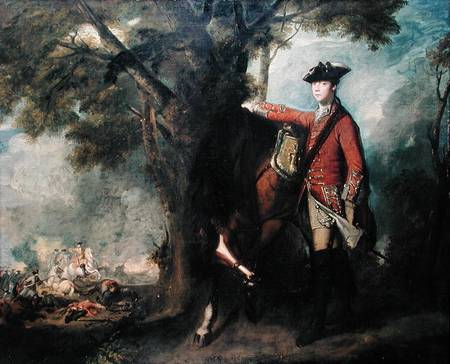 (21) Nehemiah Winter (1740)
(21) Nehemiah Winter (1740)(19) Captain Nehemiah Winter (c1665) (20) Joshua Winter (1703) ?
He was born on 14 February 1740. Interestingly, a number of children with the Winter's surname entered the Merchant Taylor's school in 1754 and 1755. I'm going to guess that, since the dates of birth work out, that they were all the sons of Joshua Winter, above.
A Nehemiah Winter was a Lieutenant in the 11th Dragoons. While a Cornet [i.e. 2nd Lieutenant] in 1759, a painting was made of him by Joshua Reynolds. He retired from the army in 1766. Nehemiah was appointed a clerk of Chancery on 6 George III, 22 April 1766. Nehemiah married a daughter of Sir Thomas Sewell, of Attershaw, Surrey. It was her second marriage. They separated. Of Gray's Inn - from a list of subscribers to a French novel, "Zelia in the Desert" of 1789. Nehemiah was noted to be "one of the six Clerks in Chancery, from whom she was separated." - from "Notes and Queries." He lived in Redlion Square - per the Poll of 1802. Red Lion square, shown below, was in Holburn, London; Gray's Inn is nearby. The area was severely damaged in World War II and only a few of the original homes still stand. Note that the Bull Inn was located on Gray's Inn lane and Nehemiah's father was baptized at the Bull Lane Independent chapel. I think that means that three generations of the family had lived in this area. 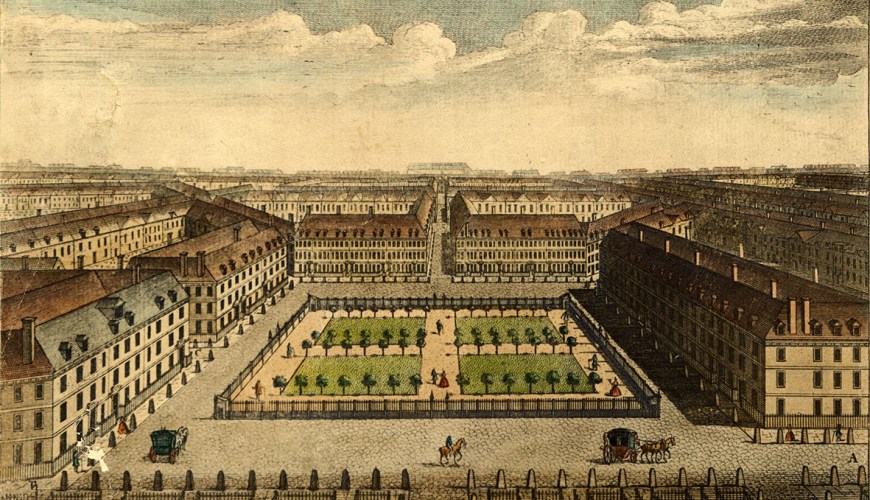 His death: "In his 74th year, Nehemiah Winter, esq, of Bishop's Stortford, Herts, senior six clerk for many years in Chancery." - from "The Gentleman's Magazine" of 1814. |
Robert's guardian sent him to Oxford College.
"Heysham, Robert, s. Robert Thornton, of Stagenhoe, Herts, arms. Magdalen Coll., matric. 12 April 1788, aged 18; of Weston Lordship, near Baldock, Herts." - from "Alumni Oxonienses: the Members of the University of Oxford, 1715-1886"What is interesting is that Robert matriculated, that is entered, Magdalen College, but there is no indicationn that he earned a degree. That is true of many of the Thornton-Heyshams, though not all; those that went into the law got degrees. Was this normal during the period? Did gentleman who because of their wealth, or soon to be inherited wealth, had no need or desire for a profession avoid the rigors of the examination required to earn a degree? If so, that seems to make Robert's sojourn at Oxford more of a social affair than an educational one. Note that Robert Jr. kept a pack of hounds while at the school. That doesn't appear very scholarly.
Robert married Sarah Hawkins, the daughter of William Hawkins.
"November[?] 1790. Lately, at South Warnborough, Hampshire, Robert Thornton Heysham, Esq., of Stagenhoe Park, Hertfordshire, to Miss Hawkins." - from "Hertfordshire 1731 to 1800" by Arthur JonesAlso,
"South Warnborough Marriages.Yet another source says,
Robert Heysham, esq., & Sarah Hawkins, lic. 10 Nov. 1790" - from "Hampshire Parish Registers"
"Sarah, daughter of William Hawkins, of Byrlands, Hertfordshire, who married Robert Thornton Heysham, of Stagenhoe Park, Herts, on 10 November 1790 at South Warnborough, Hants . . ." - from "Studia Neophilogica"I haven't been able to place Byrlands.
On 15 October 1792 Robert's attorney, James Willey, delivered seisen, i.e. possession, of the "Manor of Weston Free Lands and a cottage near Church Close, opposite Red Lion."
- In a lease dated 1 August 1799 he was referred to as "Robert Thornton Heysham, esq, of Stagenhoe Park, Lord of the Manors of Weston and Weston Argentine." The latter name refers to the de Argentine family that owned the manor in the 12th/13th centuries. Robert may have inherited these lands through his wife. In 1636 a James Hawkins, gentleman, bequethed the lands in Weston to his children, James Jr., Matilda, Anne and Mary, which he held of the manor of Weston of Henry the Earl of Kent.
The following probably fits here. It relates the activities of the Hitchin Loyal Volunteers, a home guard unit raised to defend the country during the Napoleanic Wars. Hitchin is a village in Hertfordshire.
"Hitchin and the Threatened Invasion of 1803Robert would have been 34 in 1803, about right for a militia Lieutenant who wasn't about to be whistled at. The book is a compendium of 16 vignettes about life in England, including "Portrait of an English Country Squire" and "The Story of a Country Inn."
. . . and one man were 'sent in search of deserters.' Those offenders who were apprehended were, of course, court-martialled. Private Halsey, 'when approached by Lieutenant Heysham for being out of his place, tossed his head and whistled in a contemptuous manner . . . imprisoned for two months. Private Sanders was accused of inciting forty other men of the Regiment to rescue Thomas Mayes, private soldier of the same company, then lawfully imprisoned for misbehavior." - from "Relics of an Un-common Attorney" by Reginald Leslie Hine and Richenda C. Scott, page 109
| Napolean's Threatened Invasion of 1803
Throughout the Napoleonic Wars it was England that constantly frustrated the Empereor's ambitions. Any enemy that he could engage army-to-army, that is, any on the same continent as France, he could defeat. But England lay protected by a few miles of sea, and the Royal Navy. So, when the Peace of Amiens of 1802 broke down, Napoleon immediately began to plan an invasion of the island. An army was mustered and trained at Boulogne, Bruges and Montreuil, and a flotilla of barges was built. To guard the barges in their transit across the Channel Napoleon planned a complex movement of his Atlantic and Mediterranean fleets to both concentrate his forces in the Channel and confuse and draw off the Royal Navy. Napoleon said, "Let us be masters of the Channel for six hours and we are masters of the world." The prospect of invasion threw the British into a panic. Old defenses were hastily reinforced and new fortifications were constructed along the coasts, militias were raised and trained, but it was in the dispositions of the Royal Navy that the nation chiefly relied. British Admiral Jervis said of the invasion, "I do not say they cannot come - I only say they cannot come by sea." Though Napoleon had already abandoned his invasion plans by that time, any prospects were wrecked when a combined French-Spanish fleet, enroute to the Channel, was decisively defeated by the British at Trafalgar in 1805. Napoleon, frustrated by the thin width of the Channel, took his army and moved east, where he continued to win victories against any army with which he could come to grips. |
"When the purse strings of country gentlemen began to be stretched during the French revolution and the Napoleonic Wars and in order to pay for additions to the estate, Thornton Heysham was forced to execute a mortgage of £11,000, land elsewhere was sold, Stagenhoe Bottom Farm was let out to William Bates of Harpenden and the mansion was taken by the wealthy Carbonell family who were wine importers. It proved impossible to save the estate which was finally sold to Charles Baron Feversham of Duncombe Park, York for £25,000. After mortgages had been satisfied, Heysham was left with £1,278, a sad ending for a family that had rebuilt the mansion and improved the land for more than a century." - from A History of Preston in Hertfordshire.
At some point Robert moved to Marcham Park, in Berkshire, and then, in 1810, moved to Hinton House, in Hampshire.
"Then, in 1807, Mr. Robert Thornton Heysham, who then lived at Marcham park, bought the hounds from his friend Mr. Symonds, after dining together at the Old Hummums in Covent Garden, and kept them for three seasons. Will Harrison was his huntsman; and the whip was a very long, thin man. On Mr. Heysham leaving Marcham in 1810 to reside at Hinton House in Hampshire, he resold the hounds to Mr. R. Symonds . . . " - from "Bally's Magazine of Sports and Pastimes"". . . the house appears to have been often let, since in the aquatint dated 1819 of the Hampshire Hounds meeting in the park on the south side of the house, Hinton is called "The Seat of R. Heysham, Esq." - from "A Hampshire Manor: Hinton Ampner" by Ralph Dutton. This print is below,
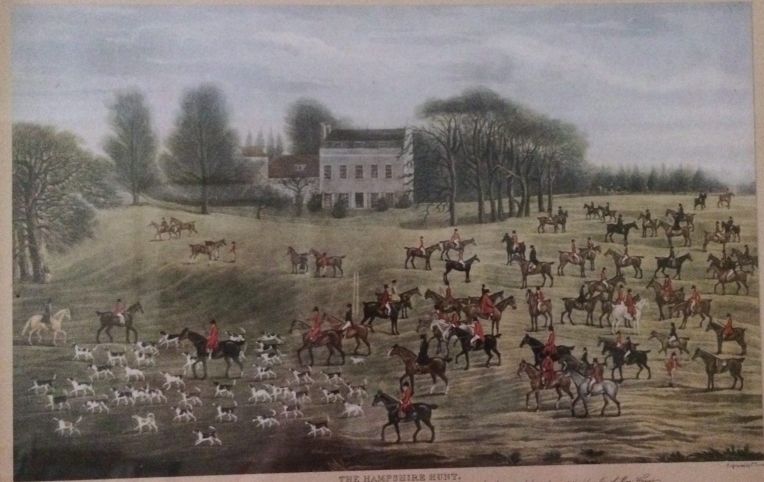
'A sketch taken from memory on the eve of the first Tuesday in December 1819 on return from hunting that day intended to represent the likenesses of men, horses and hounds who met the HH that day on the point of leaving the place of meeting Hinton House the seat of R T Heysham Esq.
It was a frosty morn and they found a fox at 26 minutes past one in Blackhouse, ran him over the Warren to Rowhay, from thence to Stoke Park, where he went to ground after a severe run of 3 house and 10 minutes."
"In 1807 Mr. Symonds and Mr. Robert Thornton Heysham dined together at the "Old Hummums," in Covent Garden (possibly the very dinner of Bull's story), and at the dinner Mr. Symonds sold the hounds to Mr. Heysham. In 1807 Mr. Symonds rented Marcham Park, probably to be able to accommodate his hunting friends. He lent it for a time to his brother. Colonel Symonds, then M.P. for Hereford, and afterwards put Mr. Heysham into it. In 1808 Mr. Heysham resold the hounds to Mr. Symonds and went to reside at Hinton House, in Hampshire, where he was still living in 1825, when the Hampshire country was visited by "Nimrod." "Nimrod" mentions Mr. Robert Heysham, Mr. William Heysham, a welter weight, and Mr. Frederick Heysham as hunting regularly with those hounds. Mr. Robert Heysham had a thin-tailed horse called " Pavilion." He sold him to Mr. North, afterwards Lord Guilford." - from "A History of the Old Berks Hunt from 1760 to 1904" by F.C. Loder-Symonds
There are a number of references to Robert, Frederick and William Nunez Heysham in Bally's Magazine, at the hunt, selling horses and other hunt-clubish stuff. All very tony, in a country way.
Note that in 1808 Robert Thornton Heysham was still shown as the owner of Stagenhoe Park, though undoubtedly renting it out.
| Marcham Park, Berkshire
|
In 1813 Mr. Robert Thornton Heysham of Hinton House, Hertfordshire was elected a member of the Hampshire Hunt during the term "when Mr. Villebois was master." - from "Sporting Reminiscences in Hampshire" by Aesop [William Nunez Heysham].
In 1816 Robert sold and conveyed the manor of Little Munden to Nathaniel Snell Chauncy, Esq. This included Green End House and Dane End House.
| The Chauncy Family & Green End House
Nathaniel, the youngest son, born at Theobalds on 29 December 1789, married Ann Oram Bannerman on 29 August 1814, the daughter of Colonel J. Alexander Bannerman, at Hackney Parish Church and on arrival at Little Munden they began to take a leading part in Hertfordshire social life. Having rich West Indian investments he entertained lavishly at Green End. In 1844 a West Indian financial crash drove him to forsake Little Munden for a smaller house in Maida Vale, London. To help redress his loss of fortune, Nathaniel sold the manor, together with an estate known as Lordship Farm, to his brother Charles, who had arrived in Dane End as a bachelor and had married Elizabeth Beale of Fitzroy Square, London, in 1817 at St. Marylebone Parish Church. Twelve years later, still in economic straits, Nathaniel committed suicide by jumping from an upstairs window of his house in Westbourne Terrace, London. Charles Snell Chauncy's only child, Eliza, died in 1854. |
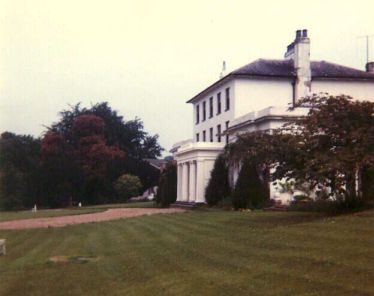 Dane End House Dane End House
This country house, located in the village of Dane End in Hertfordshire, near Munden, was listed as having been owned by the following families: Woodhall, Thornton, Heysham and Chauncy. The Thornton-Heyshams sold it in 1816 to Nathaniel Snell Chauncy. Nathaniel, in financial trouble in the mid-1840's, sold the house to his brother, Charles, who was holding it in 1855. Its rose garden was included in Rose Collections of Merit in 1850. In the recent past it was used for a time as a boarding school and now may have been converted into apartments. |
The following is from a discussion of the Hambledon Hunt, of Hampshire, a fox hunting club.
"In 1816 Mr. A. F. Nunez, of Warnford Park, became the Master, and removed the kennels from East Meon to Warnford, where he began with Will James first, and them Will Reeves as huntsmen, with whom the subscribers were not satisfied; who was followed by John Neal, a stout, big man, who hunted the hounds during the rest of the time that Mr. Nunez was Master . . . Hunting with these hounds in this period were . . . Mr. Robert Thornton Heysham of Hinton House, and his three sons--Robert, who had just left Oxford, where he kept a pack of harriers, William and Frederick . . ." - from "Baily's Magazine of Sports and Pastimes"Note that Mr. Nunez's daughter was to marry William Heysham, see below. A.F. Nunez was Master of the Hambledon Hounds for five seasons, from 1817 to 1821.
While Robert moved to Hinton House, Hampshire in 1810, oddly, his eldest daughter was wed in Saint Pauls Walden in 1819. This estate was the best "backdrop" for a wedding and they did still own it. Robert resided at Hinton House from 1810 to 1826, and was listed as a gentleman. His mother, the widow Hannah, was apparently living with him.
21 March 1822 "At Hinton-house, aged 77, the relict of Rob. Thornton Heysham, esq. of Stagenhoe Park, Herts" died - from "The Gentleman's Magazine."Since he still owned Stagenhoe and Weston, I suspect Robert was renting those out for the income (and to avoid the cost of maintaining such large establishments). I used to think the following reference applied to the original Robert Heysham, of Stagenhoe, but now I think it more properly belongs here.
"Thomas Brand, having overspent on improvements to his seat at the Hoo, went and lived abroad for a time, while his wife stayed at home and retrenched. Similarly his neighbor Robert Heysham let [rented out] his seat at Stagenhoe and went to live in France for a time, for the same reason." - from "An Open Elite?: England 1540-1880" by Laurence Stone, Jeanne C. Fawtier StoneThomas Brand of the Hoo, Baron Dacre of Gillesland, was born in 1774, the eldest son of Thomas Brand, esq., of the Hoo, and Gertrude, Baroness Dacre. He was, thus, a contemporary of Robert. When did Robert reside in France? I suppose off and on from 1810 to 1822, but this may also be a mistake, a confusion with Robert's son, another Robert, who removed to the Channel Islands in the 1830's. Note that Robert's father, Robert Sr., wrote his will in 1775 while at St. Omer, in France. Could this comment apply to him just as easily?
Robert was undoubtedly a tenant at Hinton House, renting the house, since the Duttons, and their ancestors, appear to have an unbroken record of ownership.
"At the annual Melon Feast, held at the Bell Inn, Alresford, on Tuesday, the first prize was awarded to Mr.John Merryfield, gardener to Mr.Dunn, Alresford; the 2d to Mr.Wright, gardener to Lord Craven ; and the 3d to Mr.Hedges, gardener to --- Haysham, Esq. Hinton House, near Alresford." - from "Some Selected Reports from the Salisbury and Winchester Journal," 18 July 1825Mr. Hedges shows up again, and took top honors, in 14 July 1826:
"At the annual Melon Feast, held at the Bell Inn, in New Alresford, on Tuesday last, the prizes were awarded as follow :- 1st prize to Mr.Hedges, gardener to Rt.Heysham, Esq. Hinton House."
| Hinton House
Henry Stawel Bilson-Legge, Baron Stawell, the owner of the manor at the beginning of the 19th century, died in 1820. His properties were "entailed male" to a cousin, Henry Legge, but upon his death in 1827 fell to Baron Stawell's daughter, Mary. She married John Dutton, Lord Sherborne. From approximately 1820 to 1827 the house would have been rented out. The house at that time, built in 1793, was a simple square of brick and comprised only the center section of the present-day home, pictured to the left. The grounds are extensive and are today noted for their gardens, created in the 20th century. |
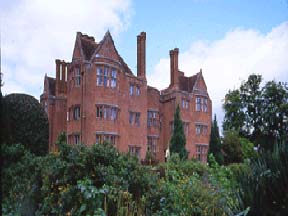 In 1828 Robert was residing at New-place, Alresford.
In 1828 Robert was residing at New-place, Alresford.
"Mr. Robert Thornton Heysham, Hinton House, afterwards, in 1828, New-place, Alresford." - from "Sporting Reminiscences in Hampshire from 1745 to 1862"Alresford is in Hampshire near the Itchen river. New-place was a 32 acre plantation near Wickham with a Queen Anne-era mansion, right. Ropley Lodge where so many later Heyshams lived is apparently close by. We also have a letter of 1828 from Robert T. Heysham of Alresford to Mr. Tilbury, London Van, to collect goods.
"Entire Letter charged 8d postage to 49 HIGH STREET, MARYLEBONE in LONDON with fine ALRESFORD Un-dated circular maileage postmark on Reverse, small spike mark on address panel, the writer requesting his van to be sent round to NEW PLACE in ALRESFORD to collect his goods which are all packed...'there is a Public House close to this place where your horses and van can be accomodated'." - from WorthPoint
In 1833 Robert and Sarah Heysham conveyed Stagenhoe manor to Richard Sparkes. - from "British History Online." By this time they had apparently decided that they would never be moving back.
In 1836 "Robert Thornton Heysham of Paulswalden" was listed under "Land Tax Commissioners Names" for the County of Hertford - from "A Collection of the Public General Statutes."
A Robert Thornton Heysham was referred to as "Lord of Weston Manor" on 10 April 1840.
In the 1841 census of St. Mary, Marylebone, Middlesex as Robert Heysham, 60 [seems young for our man who should be 72]. Living with him were his wife, n.r. [name "not recorded" I assume], 55, and children, Harriett, 39 [?], Charlotte, 34, Sarah, 25, and Frederick, 35. All of these ages seem a little off.
"In Upper Berkeley-st. aged 70, Sarah, wife of R. T. Heysham, esq." died on 29 September 1841 - from "The Gentleman's Magazine." This was in Marylebone, London, Middlesex. Upper Berkeley street defines the north side of Portman Square and is just a block away from Marble Arch. A darn fine part of town.
In a reference to his daughter Sarah's marriage in 1846 it refers to her as "youngest daughter of Robert T. Heysham, esq., late of Stagenhoe-park, and of Weston Lordship, Herts." That is, he had sold Stagenhoe, and Little Munden, but still possessed Weston manor. What does this mean? Was Robert eating through his inheritance or was he simply moving his capital from real estate to some other form of investment?
A will was signed in 1849 by Robert Thornton Heysham of No 21 Montague Street, Portman Square, Middlesex. This is in the Marylebone area in the northwest of London and is one of the finest squares in the city, close to Marble Arch and Hyde Park. The will makes clear that Robert's wife, Sarah, had predeceased him, as had his children, Arabella Elizabeth, Robert Thornton Jr., and Sarah. By the way, this will is in a script that is truly difficult to read.
"This is the last Will and Testament of Mr. Robert Thornton Heysham, late of Weston Lordship in the County Of Hertford but now of Number 21 Montague Street, Portman Square in the County of Middlesex, Esquire.A very confusing document, and a sad one. Robert complains that he is "entitled to certain manors," etc, but accepts that he has mortgaged them. He obliquely refers to an annuity he bought with the proceeds. Robert, however, rages against fate (or his poor financial management) and says that none of this was his fault (his consent was improperly procured) and he'll fix it, later; later never happened.
Whereas I am entitled to certain manors, messuages, farms, lands, tenements and hereditaments situated in the County of Hertford aforesaid subject to certain mortgages and to certain Annuities of Two hundred pounds charged thereon.
And whereas it is alleged that by Judicature [a court action?] dated on or about the [blank] day of November One thousand eight Hundred and forty three and expressed to be made between myself, of the first part, John Hawkins, of the second part [Note that Robert's wife was Sarah Hawkins, the daughter of William Hawkins. This was probably a relative.], my daughters Anna Maria Harriot Heysham, Charlotte Augusta Heysham and Sarah Heysham, and my son Frederick Heysham, of the third part, and James Gibbons the elder, of the fourth part, I granted certain Annuities and charged the same upon the said manors, messuages, farms, lands, tenements and hereditainments.
And that by Judicature dated on or about the twentieth day of October One thousand eight Hundred and forty three and expressed to be made between myself, of the first part, James Gibbons the younger, of the second part, and my late son Robert Thornton Heysham the younger, of the third part, I appointed and released unto the said James Gibbons the younger his heirs and assigns the said manors, messuages, farms, lands, tenements and hereditainments subject as therein mentioned.
To hold the same with their appurtenances unto and to the use of the said James Gibbons the younger his heirs and assigns As trusts thereinafter declared and that I by the same Judicature assigned unto the said James Gibbons the younger his executors, administrators and assigns, All and singular, the surplus rents, issues, and profits which should remain after satisfying the trusts of the thereinbefore [cited?] Judicature of [devise?] of the twenty fifth day of March One thousand eight Hundred and thirty nine subject to the thereinbefore [cited?] mortage services affecting the same and the therein mentioned four annuities of Thirty six pounds each when they should become payable To hold the same unto the said James Gibbons, his executors, administrators and assigns before the Trusts thereinafter declared [concerning?] the same and that I did by the same Judicature assign unto the said James Gibbons the younger, his executors, administrators and assigns the surplus to arise and be produced by any sale or sales under the trusts of any of the Judicatures thereinbefore recited or referred to after answering and satisfying the trusts thereby respectively declared To hold unto the said James Gibbons, his executors, administrators and assigns upon the trusts therein mentioned.
And whereas my [expectation?] of the said [cited?] Judicature was improperly procured and I intend to take proceedings to set aside the same and I am desirious of recording my instructions to [meet] the [cost] of my [seat] before I am enabled to do so and of disposing of my other property Now I therefore give, devise and bequeth the said manors, messuages, farms, lands, tenements and hereditaments subject to the said mortgages and to the said Annuity of Two Hundred pounds and all other my property, estate and effects both real and personal and of what nature or kind soever which I may die siezed or possessed of or entitled unto after the payment of all my first debts, funeral, and testamentary expenses unto and equally between my three children namely the said Anna Maria Harriot Heysham, Charlotte Augusta Heysham and Frederick Heysham, their heirs, executors, administrators, and assigns share and share alike as Friends in [cousins?] Thus I hereby appoint the said Anna Maria Harriot Heysham, Charlotte Augusta Heysham and Frederick Heysham my Executrixes and Executor and Hereby revoking all other Wills or Codicils by me at any time made So declare this to be and contain my last Will and Testament In witness whereof I have set my hand to this and the preceding sheet of paper this first day of October in the year of our Lord One thousand eight Hundred and forty nine.
[signed] Robt. T. Haysham
Witnesss
William Francis Low Solt. [solicitor]
of Wimpole Street Cavendish Sqe.
Wiiliam Dawn
16 Bridport Street Blandord Square
Clerk to the said William Francis Low."
Robert died in "Jan 1850" in the Marylebone district of London, in Middlesex - per the Civil Registration Index.
Obituary. 18 January 1850. "Aged 81, R. T. Heysham, esq. formerly of Hinton House, hear Alresford." - from "The Gentleman's Magazine."Note that William Henry was not mentioned in the will even though he lived until 1852. He was, however, in the 1851 census shown to be an "annuitant," meaning, I suppose, that his father had already taken care of him, probably upon his marriage. I would assume that Robert Thornton Jr. and the girls who married also received their portions at such time.
| Marylebone
Marylebone, or St. Mary le Bon [the Beautiful], is the fashionable West End of London, just southwest of Regents Park. Marble Arch defines it southern border. The fictional sleuth, Sherlock Holmes, lived in Marylebone, at 221B Baker street. A museum and pub named for him are also located here. Portman SquareThe will of Robert Thornton Heysham has his address as No. 21 Montague Street, Portman Square, Middlesex. Portman Square, pictured below, is in the Marylebone district. The square was built between 1674 and 1684 on the land of Henry William Portman. The garden square is a distinctively British style of urban design, used as a device for linking green spaces with residential areas. It is a particular feature of London, where there are now around six hundred squares. Montague street is only a block long. It is one block west of Portman square, behind Montague House, which is on the northwest corner of the square. Montague House was replaced by the Radisson Portman Hotel. Charles Darwin stayed in London at 16 Montague St., Portman Square. Note there is a more famous Montague street in London, next to the British Museum, in Bloomsbury. 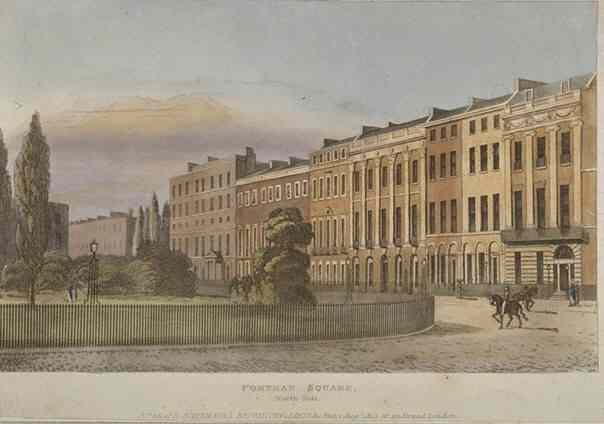
Portman Square, north side, 1813 |
| James Gibbons
Who were James Gibbons the elder & younger? A guess are the locksmiths of "James Gibbons Ltd., Wolverhapton, England." They are the right time period, of the necessary succession, and were successful enough to fund Robert Thornton Heysham's mortgages and annuities. Wolverton is near Birmingham in the West Midlands. See James Gibbons Ltd for more information about them and their company. 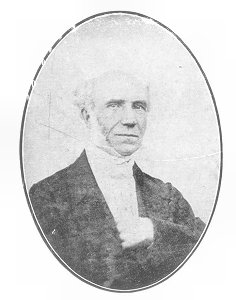
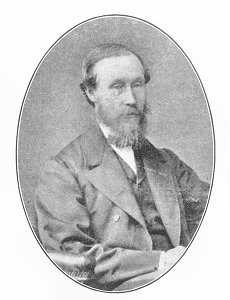
Left: James Gibbons (1790); Right: James Gibbons (1820) |
The manor of Weston, or Weston Lordship, in the family since 1703, was sold by a "Robert Thornton Heysham" to Samuel Adams in 1852 - from "British History Online." This must be the grandson, home from India, or upon his written request. Robert probably sold the estate to clear his grandfather's debts.
Robert's will has proved on 9 February 1857. How could this be since Robert had died seven years prior? I think what happened is, either, the will was probated in 1850, but that a second probate was instigated in 1857, or that this was a misreading of the will. I admit that it looks like 1857, but it probably meant 1851. A 7 and a 1 do look very much alike.
"In the Prerogative Court of CanterburyNote that by the time the will was proved Charlotte Augusta had died, I don't see her in the 1851 census, leaving only the unmarried Anna Maria and Frederick to inherit. While little seems clear to me out of this, Robert's two unmarried children did get some kind of inheritance or annuity such that Frederick, at least, never had to work a day in his life.
In the Goods of Robert Thornton Heysham Esquire deceased.
Appeared Personally William Dawn of Nr. 20 Shroton Street Blandford Square [this is in Marylebone] in the County of Middlesex Gentleman and made Oath that He is one of the subscribed Witnesses to the last Will and Testament of the said Robert Thornton Heysham late of Montague Street Portman Square in the County of Middlesex Esquire deceased bearing date the first day of October One thousand eight Hundred and forty nine and . . . [attested?] And He further made Oath that on the first day of October One thousand eight Hundred and forty nine aforesaid the said Testator duly asserted His said Will by signing His name at the foot [ordered?] thereof in manner as . . . appears thereon in the presence of this [Appearer?] and of William Francis Low the afore subscribed Witnesses thereto both of which were produced of the same time and both of whom also at the same time too attested and subscribed the said Will in the presence of the said Testator and of each other -- William Dawn. -- On the 24th day of January 1857 [or 1851] (the said William Dawn was duly sworn to the truth thereof before me --
[signed] F. T. Pratt Sec Pres -- Reginald Appach Not. Pub. [notary public]
Proved at London the 9th February 1857 [or 1851] before the worshipful Maurice Charles Merttins Swabey Doctor of Laws and Surrogate by the Oaths of Anna Maria Harriot Heysham Spinster the daughter and Frederick Heysham Esquire the son the surviving Executors to whom Administration was granted having been first sworn duly to administer.
Robert's sister, Elizabeth, lived until 1861, the wife of the Reverend John Benn.
Robert had the following children,
(23) Arabella Elizabeth Heysham (1792), who predeceased her father in 1842
(23) Anna Maria Harriett Heysham (1794), who inherited, but died an old maid
(23) Robert Thornton Heysham (1795), who predeceased his father before 1841
(23) Charlotte Augusta Heysham (1796), who inherited, but died an old maid
(23) John-William Henry Heysham (1797), not mentioned in his father's will
(23) William Henry Heysham (1798), not mentioned in his father's will
(23) Frederick Heysham (1800), who inherited, but died a bachelor
(23) Sarah Heysham (1803), who predeceased her father before 1849
She was christened on 6 June 1792 in Saint Pauls Walden, Hertford, England. Elizabeth, the eldest daughter of Robert Thornton Heysham, of Stagenhoe Park, Hertfordshire, married the Reverend Charles Fox Winnington on 10 April 1819 in Saint Pauls Walden, Hertford, England. He was the fifth and youngest son of Sir Edward Winnington, of Stanford Court, the second Baronet, and the Honorable Anne Foley, the youngest daughter of Thomas Lord Foley. Charles was the Rector at Stanford-on-Teme, Worcestershire and Vicar of Clifton-0n-Teme. He took the degree of B.A. at Christ church, Oxford and was presented to both his livings by his brother; to Clifton in 1817, and to Stanford in 1822 - from "The Gentleman's Magazine" by Sylvanus Urban. He d.s.p. in June 1841, aged 49. She died in February 1842.
| The Winnington Family
(17) Colonel Francis Winnington (c1600) temp Charles I.  (18) Sir Francis Winnington (1635)
(18) Sir Francis Winnington (1635)(17) Colonel Francis Winnington (c1600) A lawyer of the Middle Temple. Solicitor General for England, 1674-1679, left. (19) Francis Winnington of Broadway (c1665)(17) Colonel Francis Winnington (c1600) (18) Sir Francis Winnington (1635) The second son. His elder brother, Salwey, held Stanford Court and was a Member of Parliament. Francis married Anne, the daughter of Thomas Jackson of London. (20) Edward Winnington of Broadway (c1695)(17) Colonel Francis Winnington (c1600) (18) Sir Francis Winnington (1635) (19) Francis Winnington of Broadway (c1665) He married Sophia Boote of Wantage. (21) Sir Edward Winnington, Bart. (1728)(17) Colonel Francis Winnington (c1600) (18) Sir Francis Winnington (1635) (19) Francis Winnington of Broadway (c1665) (20) Edward Winnington of Broadway (c1695) Created first Baronet of Stanford Court in 1755. Member of Parliament for Bewdley, Worcestershire. He married Mary, the daughter of John Ingram of Ticknell. (22) Sir Edward Winnington, Bart. (1749)(17) Colonel Francis Winnington (c1600) (18) Sir Francis Winnington (1635) (19) Francis Winnington of Broadway (c1665) (20) Edward Winnington of Broadway (c1695) (21) Sir Edward Winnington, Bart. (1728) He was born on 14 November 1749. Second Baronet. He married Anne, the daughter of Thomas Foley, first Baron Foley, and Grace Granville, on 12 September 1776. Member of Parliament and Storekeeper of the Ordnance 1762-1765. He died on 9 January 1805 at the age of 55. His children were Thomas Edward, Edward, Charles Fox, Sophia, Elizabeth, Harriet, Francis, Henry Jeffries, Mary Anne, and Annabella. (23) Sir Thomas Edward Winnington, Bart. (1780)(17) Colonel Francis Winnington (c1600) (18) Sir Francis Winnington (1635) (19) Francis Winnington of Broadway (c1665) (20) Edward Winnington of Broadway (c1695) (21) Sir Edward Winnington, Bart. (1728) (22) Sir Edward Winnington, Bart. (1749) He was born in 1789 and died on 24 September 1839. Third Baronet and Member of Parliament. The fifth Baronent married the grand-daughter of the Duke of Marlborough, a Churchill. The sixth Baronet, Sir Francis Winnington, died in 2003 without a male heir and the baronetcy passed to a nephew, Anthony Edward Winnington. (23) Charles Fox Winnington (c1785)(17) Colonel Francis Winnington (c1600) (18) Sir Francis Winnington (1635) (19) Francis Winnington of Broadway (c1665) (20) Edward Winnington of Broadway (c1695) (21) Sir Edward Winnington, Bart. (1728) (22) Sir Edward Winnington, Bart. (1749) The Rector of Stanford. He married Elizabeth, the daughter of Robert Thornton Heysham of Stagenhoe Park, on 16 April 1819. He d.s.p. in June 1841. She died in February 1842. |
She apparently went by the name Harriett. She was christened on 21 January 1794 in Saint Pauls Walden, Hertford, England. In the 1841 census of St. Mary, Marylebone, Middlesex as Harriett Heysham, 39 [?]. She was a single woman, living at home with her parents. Mentioned in her father's will of 1849, and still living at the time it was proved in 1857 [or 1851]. Apparently she never married.
In the 1861 census of Paddington, Middlesex as Harriett Heysham [Keysham in Ancestry.com], 61 and unmarried, of Hertfordshire, England. Her occupation was listed as "Independent" and she kept one servant.
(23) Robert Thornton Heysham (1795)He was born at Stagenhoe Park and christened on 23 March 1795 [I have another document that indicates 23 November 1800] in Saint Pauls Walden, Hertfordshire, England, the son of Robert Thornton and Sarah [Hawkins] Heysham.
Like his father and brothers, he went to Oxford.
"Heysham, Robert Thornton, s. Robert Thornton, of Walden, St. Paul's, Herts, arm. Brasknose [Brasenose] Coll., matric. 7 Feb., 1812, aged 17." - from "Alumni Oxonienses: the Members of the University of Oxford, 1715-1886"I see no indication of a degree.
In 1816 his father sold the Little Munden estate and moved to Southampton in about 1820. Robert would have been about 21 years old at the time of the sale and 'probably' accompanied his family on the move.
Circa 1816. Robert had "just left Oxford, where he kept a pack of harriers," which refers to hounds since the citation was about hunting. - from "Bailys Magazine."
Robert married Frances Price on 12 August 1824 in Haslemere, Surrey, England. The marriage licence was recorded 6 August 1824. She was born on 4 May 1796 and died in 1871, the daughter of Colonel Barrington Price and Lady Maria Jane Bowes-Lyon, who was the eldest daughter of John Bowes-Lyon, the 9th Earl of Strathmore. This is the family of the old Queen Mother. Frances Price was the niece of the Right Reverand the Honorable Shute Barrington, the Bishop of Durham. The Bishop's will:
June 1826. "He gives 4000l. to be laid out in the stocks, in trust for all the children of Barrington Price (except the before named and Frances wife of Wm. Heysham [sic], Esq.) to be divided in equal shares and paid on their coming of age, accumulating in the mean time . . . To Frances Heysham 500l. only, he having already given 500l. to her father for her use on her marriage." - from "The Gentleman's Magazine"Note that the Bowes-Lyon family lived at St. Paul's Walden Bury, which was nearby Stagenhoe. See the Bowes family page for more information about this family's descent.
| The Viscount Barrington Family
(17) Sir Francis Barrington The first Baronet Barrington, was uncle by marriage to Oliver Cromwell, the Lord Protector of England. Their seat was Barrington Hall, in Hertfordshire. His sons were Sir Thomas, his heir, Robert, an MP, Francis, who settled in Jamaica, and John, a gentleman of Oliver's bedchamber and MP who retired to Germany. (18) Sir Thomas Barrington(17) Sir Francis Barrington His second wife was Joan, the daughter of Sir Rowland Lytton of Knebworth House [small world]. By his first wife, Joan Gobert, he had sons Sir John, his heir, Oliver, and Sir Gobert, of Tofts. (19) Sir Gobert Barrington(17) Sir Francis Barrington (18) Sir Thomas Barrington His surviving sons were Thomas, his heir, and Francis. (20) Francis Barrington(17) Sir Francis Barrington (18) Sir Thomas Barrington (19) Sir Gobert Barrington His brother, Thomas, "injured his fortune" in the Civil War and requested Francis, who was a rich merchant of Tunis, to purchase it, meaning I suppose his estate. Francis married the daughter of Samuel Shute, an Alderman of London, in 1681. A proviso of the marriage was that if Francis d.s.p., which he did, his brother-in-law, John Shute, would inherit. The Shute-Barrington's(20) John Shute-Barrington (19) Samuel Shute Of Hertfordshire, was the son of Benjamin [Samuel?] Shute, a merchant. He inherited the estate of Francis Barrington, of Tofts, and assumed his name by an act of Parliament. He also inherited an estate in Becket and considerable property in Berkshire from a John Wildman. A member of Parliament, on the accession of George I John was raised to the peerage as the 1st Viscount Barrington. John Swift called him "the shrewdest head in England." The elder Pitt had no use for him. 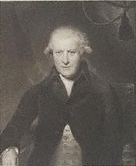 (21) William Wildman Shute Barrington
(21) William Wildman Shute Barrington(19) Samuel Shute (20) John Shute-Barrington The 2nd Viscount, left. Lord of the Admiralty, Master of the Wardrobe, Secretary of War, Chancellor of the Exchequer. (21) Major General the Honorable John Barrington(19) Samuel Shute (20) John Shute-Barrington Major General and governor of Berwick. He served several campaigns in Flanders and commanded the force that took Guadaloupe in 1758. His sons assumed the title after his elder brother died dsp. (22) William Wildman Barrington(19) Samuel Shute (20) John Shute-Barrington (21) Major General the Honorable John Barrington The third Viscount. (22) Richard Barrington(19) Samuel Shute (20) John Shute-Barrington (21) Major General the Honorable John Barrington The fourth Viscount. (22) George Barrington(19) Samuel Shute (20) John Shute-Barrington (21) Major General the Honorable John Barrington The fifth Viscount, Prebendary of Durham and Rector of Sedgfield [you can tell they never expected him to be Viscount]. His son and heir was William Keppel Barrington, sixth and last Viscount. 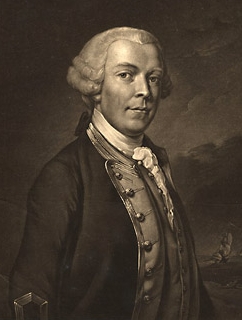 (21) The Honorable Daines Barrington
(21) The Honorable Daines Barrington(19) Samuel Shute (20) John Shute-Barrington Marshall of the High Court of Admiralty, Secretary of Greenwich hospital, and Judge of Chester. 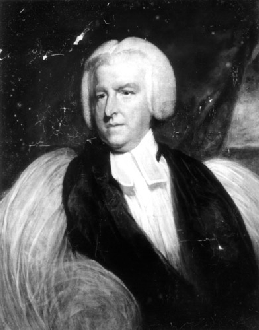 (21) Admiral the Honorable Samuel Barrington
(21) Admiral the Honorable Samuel Barrington(19) Samuel Shute (20) John Shute-Barrington Admiral of the Blue in 1787 and of the White in 1794, right. (21) The Right Reverand the Honorable Shute Barrington(19) Samuel Shute (20) John Shute-Barrington Bishop of Durham, left. (21) Sarah Barrington (c1715)(19) Samuel Shute (20) John Shute-Barrington She married Robert, the son of Uvedale Tompkins Price, of Foxley estate, Hertfordshire in June 1746. She died on 17 March 1759. |
| The Price Family
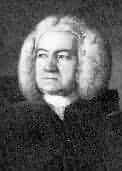 (21) Robert Price (1717)
(21) Robert Price (1717)(19) Robert Price (1655) (20) Uvedale Tompkins Price (1685) Esq., of Foxley estate, Hertfordshire, left. A Baron of the Exchequer and, later, a Judge of the Court of Common Pleas, he was also a collector, musician and gentleman artist. He married Sarah Barrington, the daughter of the first Viscount Barrington, in June 1746. He may have also married Catherine Wroughton. He made extensive improvements to his estate at Foxley, always emphasizing the natural qualities of the existing landscape. Sarah died on 17 March 1759. Robert died in 1761. 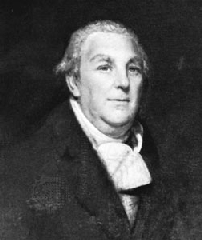 (22) Sir Uvedale Price (1747)
(22) Sir Uvedale Price (1747)(19) Robert Price (1655) (20) Uvedale Tompkins Price (1685) (21) Robert Price (1717) Eldest son of Robert Price was Sir Uvedale Price (1747-1829), right, the Baronet of Foxley, and a famous early landscape architect and theorist of the "Picturesque" movement. He had a son and heir, called not surprisingly, Robert. There's a pattern here. (22) Colonel Barrington Price (1757)(19) Robert Price (1655) (20) Uvedale Tompkins Price (1685) (21) Robert Price (1717) A seventh son. Barrington married Lady Maria Jane Bowes-Lyon, the eldest daughter of John Bowes-Lyon, the 9th Earl of Strathmore, on 11 May 1789. Their daughter was Francis Price. Maria died in 1806. Her brother, George Bowes-Lyon, died the same year dsp and his widow, Mary Thornhill, married Barrington Price in 1811. Clerk of the Peace for Durham county. He died on 5 April 1839 at Sparsholt House, aged 82. His children included Samuel [RN Captain], George, Maria [who married Cholmeley Edward John Dering, prebendary of St. Paul's, chaplain to Queen Victoria], Ann [who married John Lyon], Francis [who married Robert Heysham]. (23) Captain Barrington Price(19) Robert Price (1655) (20) Uvedale Tompkins Price (1685) (21) Robert Price (1717) (22) Barrington Price A Captain Barrington Price, an aide-de-camp to Sir Thomas Picton, was mortally wounded at the Battle of Waterloo in 1815, ridden over by a charge of French cuirassiers. He died a few months later. (24) Barrington Price (1841) & George Barrington Price(19) Robert Price (1655) (20) Uvedale Tompkins Price (1685) (21) Robert Price (1717) (22) Barrington Price (23) Captain Barrington Price A later Barrington Price, perhaps a son of the above, settled in British Columbia. He ran a store at an old Hudson Bay trading post, then built the Grist Mill, which has been restored by the Canadian governmentt as an historic site. This Barrington eventually returned to Portsmouth and lived with his brother, Captain George Barrington Price, of the Royal Scots Greys. (23) Francis Price(19) Robert Price (1655) (20) Uvedale Tompkins Price (1685) (21) Robert Price (1717) (22) Barrington Price She married Robert Thornton Heysham on 12 August 1824 in Haslemere, Surrey, England. |
The next two items are from the UK Archive, the Correspondence of Thomas Tilbury, of Edward Tilbury and Company, Marylebone High Street, who maintained storerooms for warehousing:
- "Heysham, Mr. R.J. [I'm assuming the J is a transcription error] of Brighton. His waggon will be in town next Tuesday to collect remainder of his furniture. Advance notice given so that waggon may be loaded as quickly as possible. Mr. Heysham wants his man to get as far as possible on return journey to Brighton on Tuesday. - date: 12 July 1829"That last line sounds like the comment of a inpecunious man - "the check is in the mail." Robert apparently maintained two homes, one in the fashionable Marylebone district in London, see his father's house, above, and the other his country place, in Brighton, between which he commuted.
- "Heysham, Mr. R.J. of Brighton, regrets he has just returned to find two letters asking for payment of an account he thought paid. Inclement weather prevented him visiting London and he encloses a draft for the amount dated six days ahead to avoid loss. P.S. says that he has observed that the limit for a draft is £20. 17/6 will therefore be sent at the first opportunity. - date: 17 Feb. 1830."
The next reference may be for Robert. The square named is in Brighton.
"Haysham, R. Esq. 33, Brunswick-square, Hove" - from "The Watering Places of Great Britain" of 1831The book also says of the area that the ". . . beauty of the range is much increased by the line being relieved by two handsome squares (Regency and Bedford), and by its terminating in Brunswick-square, which, with its noble terrace, vies with its eastern rival, Kemp Town. This grand continuation of the town is situated in the parish of Hove . . ."
| Brunswick Square
|
Robert seems to have moved around a lot. He had children born in London, Brighton, Hampshire (3 of them) [I may be overstating the case; Brighton is in Hampshire.], and on the island of Guernsey. Their three boys went to secondary school on the island of Guernsey, from at least 1833 to 1844. Did Robert have a government posting there or was he just trying to conserve the family resources?
Robert and his family moved to the Channel Islands in about 1834. His son, Russell Henry, was born in Hampshire in 1834, while his eldest son, Robert Jr., entered the Elizabeth College, at St Peters Port, in the 1834 term, at the age of 8. I assume the term began in the fall. Interestingly, his two other sons, Barrington and Charles, did not enter the school until the 1844 term, when they were 13 and 12 years old, respectively. Why the delay? Robert's daughters, Maria and Rosa, were born on the island in 1836 and 1837.
This was just a year after Robert's father sold Stagenhoe. Was this move out of England an attempt to husband their resources? I have to think that the family fortunes were suffering, at least to a degree. Two of Robert's sons, Robert Jr. and Barrington, joined the army of the East India Company, while the third, Charles Augustus, joined the Royal Navy. These are all normally the professions of sons not inheriting. Was there little left to inherit by that point? If the family were living just off their dividends, or annuities, their condition may have been some what straightened.
| The Channel Islands
The Channel Islands lie within the English Channel and the Gulf of St Malo within sight of the French coast. There are six main isles - Jersey, Guernsey, Alderney, Sark, Herm and Jethou - and numerous islets and rocks such as Les Minquiers, Les Ecrehou. Guernsey was once a part of Normandy, as were the other Channel Islands. This changed in the early 13th century. In the 15th century Guernsey, Sark and Alderney were placed under the control of a Governor, a role which later became the Lieutenant Governor, a post that still exists to this day. The island's Royal Court is presided over by The Bailiff, who is also president of Guernsey's legislative body, the States of Deliberation. Both positions are Royal appointments. If one of the Thornton-Heyshams were on the island in a political position, they would have owed their position to one of the below: Governors of Guernsey:1797 - 14 Nov 1807, Charles Grey, Earl Grey of Howick (b. 1729 - d. 1807) 1807 - 26 Oct 1827, George Augustus Herbert Pembroke (b. 1759 - d. 1827), Earl of Pembroke 1827 - 1834, Sir William Keppell, (d. 1834), the last Governor Lieutenant Governors: 1796 - 1802, Sir Hew Whitefoord Dalrymple (b. 1750 - d. 1830) 1803 - 1816, Sir John Doyle (b. 1750 - d. 1834) 1816 - 1821, Henry Bailey 1821 - 1828, Sir John Colborne, Baron Seaton (b. 1778 - d. 1863) 1828 - 1837, John Dawes Ross 1837 - 1842, Sir James Dawes Douglas (b. 1785 - d. 1862) Feb 1842 - Dec 1847, William Francis Patrick Napier (b. 1785 - d. 1860) Bailiffs: 1800 - 1810, Robert Porrett Le Marchant (b. c.1739 - d. 18..) 1810 - 1821, Sir Peter de Havilland (b. 1747 - d. 1821) 1821 - 1843, Daniel de Lisle Brock (b. 1762 - d. 1842) 1843 - 1845, Jean Guille (b. 1788 - d. 1845) |
Did Robert die before 1841? In the 1841 census of St. Peter Port, Guernsey, the Channel Islands, his wife was reported as Francis Heissham, 35, of Independent means, residing at Haute Ville. Living with her were Francis [this would be Frances Mary], 13, Caroline, 15, Robert, 14, Georgina, 11, Barrington, 10, Charles, 8, Russell, 7, Maria, 5, and Rosa, 4. Maria and Rosa were born in Guernsey while everyone else was from England. Ann Bennet, Matilda Suanders, Jane Knowles, and Eliza Le Gruet were F.S. [female servants], Sophia Bonifield was the Governess, and John Hughes was an M.S. [male servant]. While the family may have moved to Guernsey to save money, they weren't suffering greately. By the way, Hauteville House was the residence of Victor Hugo for 15 years, starting in 1855, pictured below. Clearly the family was not hard up for cash.
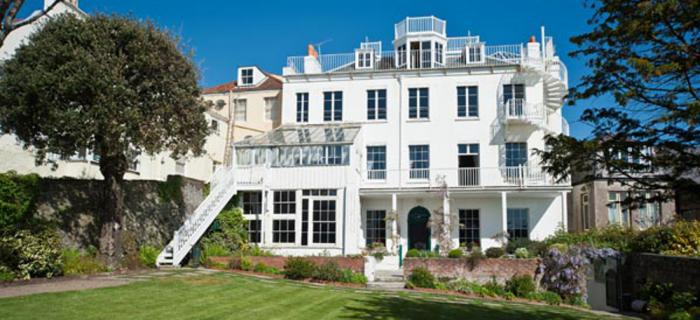
By the way, the Hauteville House was occupied for many years by Victor Hugo, starting in 1855. It is now the home of a French Consul and a museum of Hugo. It is available for tours.
Robert Jr. left Elizabeth College in 1841, aged 15, to join the HEIC school at Addiscombe. Charles left in 1845, at 13, to join the Royal Navy, and Barrington left in 1846, at 15, also going to Addiscombe. I assume Robert Sr. and family lived on the island at least through that time.
Robert died before October 1849, when his father's will reported him as his "late son." Robert's daughter, Caroline Arabella, was also noted in 1851 to be the daughter of the "late R.T. Heysham, esq., of Bath." Does the latter mean that after 1846 he had moved to Bath? Or, was he vacationing at Bath at the time of his death? Or, was that an English address, held while he actually lived on the Channel Islands?
In the 1851 census of Devonport, Stoke Damerel parish, Devonshire was Robert's widow, Frances Heysham, 56 years old, of Srivenham, Berkshire. Her occupation was listed as Landed Proprietor & Fund Hold. I assume that means she inherited some property and had deposits "in the five percents", as they used to say. Her address in 1851 was 3 Park Place, Devonport, Devonshire, England. Residing with her were four servants, a lady's maid, cook, house maid and parlour maid. So, though the family fortunes may have sunk somewhat, they were by no means "broke." With her were also her children, Caroline A., 25, of St. James, London, Frances M., 23, of Somerset, Bath, Barrington F., a 20 year old Ensign E.I. [East India] Company Service, of Farringdon, and Maria J. B., 15, of St. Peter, Isle of Guernsey.
Note that Frances' son, Charles, was a Midshipman in the Royal Navy at this time. Living in Devonshire, near the great naval base of Plymouth, may have kept Frances near her son. However, I can't confirm where Charles was assigned prior to 1852, when he was on the AGAMEMNON, out of Portsmouth, which is further to the east.
| Stoke Damerel, Devonshire
Stoke Damerel is a parish in the Devonport borough, in the county of Devon. The major town is Devonport, a garrison, seaport and market town, just 2 miles north of the great naval base at Plymouth. It was, before 1824, known as Plymouth Dock. The first dockyard was built on the banks of the Hamoaze, the lower reaches of the River Tamar, in the late seventeenth and early eighteenth centuries. Workers for the dockyard came from neighbouring towns and villages for originally there were no houses for the workers. Eventually houses were built parallel with the north dockyard wall at a place called North Corner and then Cornwall Street. By 1712 there were 318 men employed and by 1733 Plymouth Dock, as the new town was called, had 3000 people. Plymouth Dock was a working-class town. Within fifty years it grew from nothing to having nearly half as many people as its older neighbour, Plymouth. The parish church, Stoke Damerel, was three-quarters of a mile from the town surrounded by fields. The major expansion of the dockyard came in the late eighteenth and early nineteenth centuries as a direct result of war with France. Other notable buildings were erected throughout the area. At Stonehouse Creek a Naval hospital was built with landing steps down to the water's edge so that the sick and wounded seaman could be landed directly from boats. Later a Military hospital was built on the opposite shore of the creek. New barracks were built for the Royal Marines at Stonehouse. Government House, but since 1934 known as Admiralty House, was built at Mount Wise. |
In the 1861 census of West Teignmouth, Devonshire as Frances Heysham [Harpham in Ancestry.com], a 64 year old Fund Holder, of Strivenham, Berkshire. Living with her was her daughter, Maria, 25, unmarried, of Guernsey. Frances had 5 servants living in the house. Teignmouth is about 25 miles northeast of her previous home in Stoke Damerel, just north of Torquay.
Frances Heysham died in January-March 1871 in Newton Abbot, Devonshire at the age of 75. Newton Abbot is just upriver from Teignmouth.
17 February 1871. "Administration of the effects of Frances Heysham late of Hillford House West Teignmouth in the County of Devon Widow who died 16 January 1871 at Hillford House was granted at the Principal Registry to Barrington Frederick Heysham of Teignmouth in the said County a Major in Her Majesty's Madras Staff Corps the Son and one of the Next of Kin." - from the National Probate CalendarHillford house, Bilton Hill, West Teignmouth was at this time a boarding school. In 1871 it was known as Thorn Park School. The 1871 census listed 3 resident assistant masters, 3 governesses, 7 pupils and 42 pupils. Was Frances a governess of the school? Of course Francis was deceased by this time.
From the tomb of a servant (Ann Bennett was a lady's maid for Frances Heysham in the 1851 and 1861 census, above.):
Northam, Devonshire, England monument inscriptions:
Yj 12: (Upright - Thick Cross With Square, Stepped Base), (Gap Of 1 Then This Stone), Ihs (On The Cross)
In Loving Memory Of
Anne Bennett,
For Over 60 Years The
Faithful And Devoted
Servant And Friend In The Family
Of The Late
Robert Thornton Heysham, Esq.
Died At Quarry House, March 25th
1885 Aged 85
(On The North Face Of Base)
"He That Is Faithful In That Which
Is Least, Is Faithful Also In Much."
Luke Xvi C. 10 Verse.
Robert and Frances had the following children:
(24) Caroline Arabella Heysham (1825)
(24) Robert Thornton Heysham (1826)
(24) Frances Mary Heysham (1827)
(24) Georgina Heysham (1830)
(24) Lieutenant General Barrington Frederick Heysham (1831)
(24) Charles Augustus John Heysham (1832)
(24) Russell Henry Heysham (1834)
(24) Maria Jane Bowes Heysham (1836)
(24) Rosa Heysham (1837)
The eldest daughter of Robert Thornton. She was born in 1825 in St James, Middlesex. In the LDS database she is shown as christened on 14 May 1825 in Saint James, Westminster, London, England.
In the 1841 census of St. Peter Port, Guernsey, the Channel Islands, as Caroline Heissham, 15, of England. She was living with her mother, Francis.
In the 1851 census of Stoke Damerel, Devonshire as Caroline A. Heysham, 25, of St. James, London. She was living at home at 3 Park Place, Devonport.
Caroline married Fleetwood Patten [sic] Drury, Captain H.E.I.C.S. [Honorable East India Company Service], at Stoke, Devonshire on 12 July 1851.
"Drury, Lieut. Fleetwood P. Madras Army, to Caroline A., d. of the late Robert T. Heysham, at Stoke Demerel Church, Devon, July 12" - from "Allen's Indian Mail"Her widowed mother, Frances, had settled in Devonshire after her father's death. In the announcement of the wedding Caroline's father was referred to as "the late R. T. Heysham, esq., of Bath."
Fleetwood was born on 15 January 1824, the son of Captain Henry Drury, Royal Navy.
| The Drury Family
(23) Captain Henry Drury He married Alice McGee. In 1811 Henry Drury was part of the expedition that captured the island of Java, as the acting captain of the AKBAR (ex-CORNWALLIS). She was a 44-gun frigate, a 4th rate, built in 1800 in Bombay for the East India Company. The ship was purchased by the Royal Navy in 1801. Henry's third daughter, Louisa, married Henry Lockyard Gleig, esq., 2nd Bengal Infantry, the son of the Reverend George Robert Gleig, M.A., Chaplain General. Henry had died by 1852. (24) Fleetwood Pellew Drury (1824)(23) Captain Henry Drury Fleetwood Drury's interesting first & middle names were undoubtedly from 'Fleetwood Pellew,' who was the son of the famous Captain Edward Pellew of the Royal Navy. He was a Navy Captain in his own right, but his harsh measures caused a mutiny and ruined his career. Before this time, however, Fleetwood Pellew had been the captain of the frigate PHAETON during the same Java expedition in which Henry Drury served. Fleetwood Drury was in the Madras Army. Fleetwood Pellew Drury - East India Company's Army, Cadet Papers, 1840-41. He was appointed to the 20th Madras Native Infantry in 1841. "Officers of the Twentieth Regiment Madras Native Infantry, Stationed at Palghat; arrived 1850.Fleetwood was in the Madras Service Army List, 20th NI, 1771-1846, and individually for each of the years 1847-1858. He was also in the Roll of subscribers to the Madras Military Fund [a pension fund], 1824-1866. The 20th Madras Native Infantry was involved in putting down the Mutiny. One of their officers died at Delhi in 1857. |
Caroline's younger brother, Barrington, was in the Madras Army. Did Caroline and Fleetwood meet through him, or did Barrington get his assignment through Fleetwood?
Caroline was probably living in India at the time of the 1861 census. Caroline and Fleetwood had two daughters, Rosa Fanny Barrington Drury and Alice Marion Drury. Fleetwood Drury died in 1866.
"Fleetwood Pellew, Major 20th Regt. Madras Inf., b. Jan. 1824, m. 1857, Caroline Arabella, dau. of Robert Thornton Heysham, and d. in India 1866, leaving issue." - from "Burke's Genealogical and Heraldic History of the Landed Gentry"
In the 1871 census of England as Caroline A. Drury, a 45 year old widow and annuitant, of East India. She and her two daughters, Rosa F., 17, and Alice M., 15, also of East India, were living with her brother, Barrington, and his wife in Paddington parish, in the borough of Marylebone, in London. Could this be the old Marylebone home in which Caroline's father and brother died? Interestingly, old Mrs. Anne Bennett, the servant of Barrington's mother, above, was serving Barrington's family at this time.
In the 1881 census of Bideford district, Devon as Caroline A. Drury, a 54 year old, of independent means, of St. James, London. Living with her was her daughter, Alice M., 25, of East Indies [sic], Carmonore [?]. Her brother, Charles Augustus John, also lived in this district. I assume Rosa married, but I haven't found that reference yet.
Their children were,
(25) Rosa Fanny Barrington Drury, married H. A. Burrowes of Dangan Castle, Meath, and had a son.
(25) Alice Marion Drury
Robert Thornton IV was the eldest son of Robert Thornton Heysham III, of Stagenhoe Park. "1826. Births. May. 21. At Redbourne [Redburn] House, Herts, the wife of Robert Thornton Heysham, jun, esq. a son and heir." - from "The Gentleman's Magazine." He was born on 21 May 1826 at Brighton, but not baptized until 30 July 1828 at St. Nicholas, Brighto. What happened to Hinton House? Redbourn[e] is in the region of Harpenden, Hertfordshire.
In 1834 Robert entered Elizabeth College, a secondary school on the island of Guernsey. Note that Robert's youngest sister, Maria, was born in Peters Port, the capital of Guernsey, and his two younger brothers also attended the College at a later date. Did Robert's father have a post there?
| Elizabeth College
The school was founded in 1563 with a grant from Elizabeth I, who gave the school her name. The school had its ups and downs and nearly went out of business a number of times, but was rechartered in 1824. The school's main building was built between 1826 and 1829. 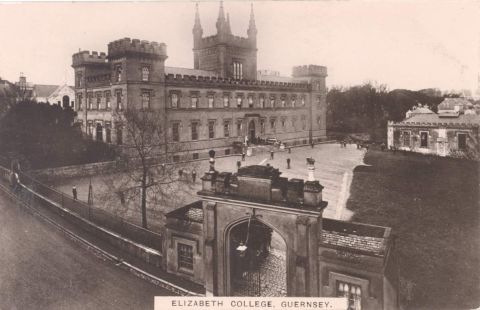 |
| St. Peter Port, Guernsey
Guernsey is the second largest of the Channel Islands, and the most Western. It is 30 miles from France and 125 miles south of England. Guernsey is about nine miles long by five miles wide, comprising just 24 square miles in area. St Peter Port, on the island's east coast, is the capital and chief city of Guernsey. It was, during a period of revolutionary turbulence in France, the home of the novelist, Victor Hugo. He once described the Channel Islands as "little pieces of France fallen into the sea and scooped up by Britain." Describing St Peter Port, he wrote, "A gothic church, streets ancient, narrow, uneven, odd amusing, intersected by steps, clambering up and tumbling down, the houses piled on top of one another so that they all have a view of the sea. And a little harbour where the vessels are stacked together, where the yard-arms of the schooners ever risk smashing into the windows that overlook the quay." 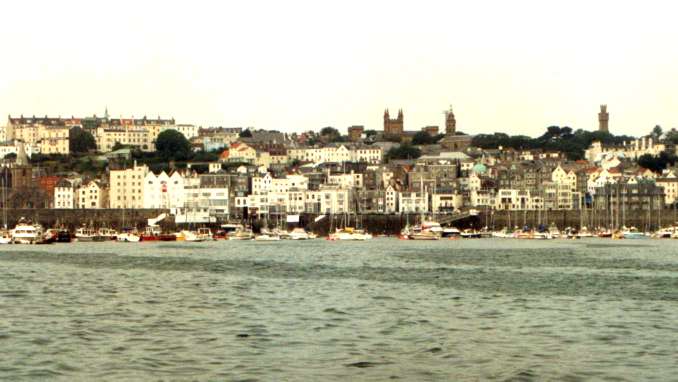 |
In the 1841 census of St. Peter Port, Guernsey, the Channel Islands, as Robert Heissham, 14, of England. He was living with his mother, Francis. Robert left Elizabeth college in 1841 - from "Elizabeth College Register, 1824-1873: With a Record of Some Earlier Students. A Chapter of..." by Charles James Durand, Edward Charles Ozanne, Elizabeth college, Guernsey, Kentish Brock, Guernsey Elizabeth College.
Robert attended the East India Company military school at Addiscombe - Cadet Papers: Robert Thornton Heysham 1841-1842. He would have been 15-16 years old at this time. The reason for the short stay at this school was probably related to the recent loss of an entire 16,000 man HEIC army in the mountains of Afghanistan. So great was the need after this military disaster that the Company was ready to take almost anyone into their army and hastened the training of those already in the pipeline.
After graduating from the school Robert was posted to Bengal in India. "Heysham, Robert Thornton" - from "The India Office and Burma Office List." His parents would have been victimized by the outfitters that preyed on the new recruits. They sold the new uniforms and equipment that Robert would have needed, but pushed more gear on the men than they really required, and much of that of poor quality. The same thing occurred in the Royal Navy, which you can read about in the novels of Patrick O'Brian.
At this same time Richard Burton, the great explorer and linguist of the Victorian era, also joined the Company. He did not attend Addiscombe, but was given a direct commission (at the cost of £500). Note that while he had attended Oxford, he did not finish his degree (he was expelled), so a University education was not a requirement for service. Many of the comments to follow were taken from Burton's travels and observations as a young Ensign.
| Bengal Presidency
The East India Company divided their areas of control in India into three 'Presidencies,' Madras, Bombay and Bengal. The Presidency of Bengal included the modern-day states of West Bengal (including Calcutta), Assam, Bihar and Orissa. At times it extended to Punjab and most of Northern India. The Company established its first settlement in Bengal in 1642 and extended its occupation by conquering the native princes and expelling the Dutch and French. Muslim control of Bengal ended with the defeat of Siraj-ud-Daula by British forces under Robert Clive at the Battle of Plassey in 1757. The population, which speaks mainly Bengali, is ethnically homogeneous, but is almost equally divided between Muslims and Hindus. When India was partitioned in 1947, the province was divided along the line approximately separating the two main concentrations of the religious communities. |
The voyage to India took about four months, rounding Africa at the Cape of Good Hope. The new Ensigns, known as "Griffs," short for Griffons, a military slang of the day, would have smelled the port of Calcutta before they could see it. The smell was a combination of the pervasive aroma of curry and the sour stink of untreated sewage. The shock of coming upon an Asian slum is profound, as I can testify. Robert would have met squalor unlike anything he had seen before, even in the worst parts of London. It was, however, exciting as well; exotic, and erotic, in ways he had never experienced.
I have a reference to Robert's arrival in India in a book for which no preview is available. In the Google search it reads as,
January 1843.Fort William, below.
:Military Appointments, Promotions, Changes, &c.
. . .
Nov. 1.--Admitted to the service, as cadets of art. and inf., and prom. to 2d lieut. and ensign from dates assigned to them
Artillery.--Mr. G.S. Dundas, date of arrival at Fort William, 28th Oct. 1842.
Infantry.--Messrs H. Baring, E.J. White, W. Irwin, R.T. Heysham, and T.H. Chamberlain, date of arr. Fort William, 8th Oct. 1842."
- from "The Asiatic Journal" of 1818.

Robert's first disappointment would have been that the disaster in Afghanistan had already been avenged by an army under Lord Ellenborough. The prospect of immediate action taken care of, Robert would have spent some time in Calcutta, perhaps 4 to 6 weeks, before he was assigned to his regiment. In Robert's case that was an an Ensign in the Second Bengal Regiment of Native Infantry (BNI).
1842. "RT Heysham (do.) to 2nd (do.)" - from "The Asiatic Journal and Monthly Register for British and Foreign India"Until he arrived at his regiment he would be assigned a munshi, a native teacher to polish the language skills he had supposedly gained at Addiscombe. He would have had a lot of time in addition to explore the city and this new way of life.
1843, Calcutta. "Aug. 2. Examinations.--The undermentioned officers have been pronounced by committees, which assembled at Agra, Neemuch, and Khyouk Phyoo, to have acquired colloquial proficiency in the vernacular language.
Ensigns R. T. Heysam and M.A.F. Thomson, 2nd grenadiers; . . ." - from "The Indian Mail"
Note that the BNI were classified as The Second Bengal Regiment of Native Infantry were classified as Grenadiers, that is, assault troops.
Upon getting his regimental assignment, Robert headed upriver to his new post, probably in the northwest territories, near the frontier at Punjab. The cantonment at Ambala in Haryana is a good guess. This camp was new, founded to replace the cantoment at Karnal which had been abandoned in 1841 due to an outbreak of malaria. Robert would have traveled as a true mensahib, laden with trunks and accompanied by as many servants as he could afford.
| Second Bengal Native Infantry
The 2nd BNI was formed in 1764 and disbanded in 1859. Just before Robert Thornton arrived, the regiment had taken part in the First Afghan War, 1839 to 1842, earning 65 "Kandahar" medals for their bravery in action around Kandahar under the overall command of Major General W. Nott in May 1842. On 10 August 1842 they marched from Kandahar to Ghazni and Kabul. Up to this point the war had gone well for the British. All that was to change. While Afghanistan had been easy to take, it was impossible to hold. In the face of fierce attacks by the populace inside Kabul, fueled in part by the weak response the commanders' permitted, the British were forced to retreat and suffered extermination in the moutain passes.
The 2nd was one of the few regiments in the Bengal Army that did not mutiny in 1857, though they were pre-emptively disarmed. They were nonetheless disaffected. Sepoys of the unit told their Colonel [James Travers?] that there were unmistakable signs that the company was bent on destroying the religion of the natives. They pointed to contamination of salt, ghee [a kind of butter] and sugar of its sepoys with the bones of pigs and cows. Hindu soldiers interpreted the reddish colour of the salt from the dye of the sack as cow's blood. The entire army was reorganized in the aftermath of the debacle of the mutiny and this regiment was disbanded in 1859. |
Upon checking into his regiment Robert would have been introduced to its officers at the Regimental Mess. This dining hall/officer's club would have been a welcome relief. A long cool hall, fanned by punkahs, its tables set with clean linen and polished silver, a servant behind the chair of each officer, it was quite a contrast to the noisy, squalid Indian cities beyond the cantonment's walls. The officers themselves were cocky and confident. Richard Burton said of his messmates "there was not a subaltern in the 18th regiment who did no consider himself capable of governing a million Hindus."
As a bachelor Robert would have been set-up in a small bungalow of his own and he would have had a large staff of servants. I don't know anything about Robert's proclivities, but it was usual for the hawaldar, the regimental sergeant, to find the new officers a bubu, termed a "black wife." White women, especially single ones, were scarce outside the large cities, even as late as 1843. When the regiment moved these women were normally left behind. Much of the native language a man learned came from conversations with his "black wife" and it was for this reason that they often learned only the feminine version of words, to the great amusement of the locals.
Life in the cantonment started early, the men rising before dawn to get as much accomplished in the cool of the day as possible. The 2nd BNI had to be relentlessly drilled, both in the march and in rifle drill, to achieve the level of training that allowed the small Company armies to overawe the native levees. During the torrential rains of the monsoon season little training could be accomplished.
| The Conquest of India
A recurring theme in the conquest of India is the defeat of huge local armies by small British forces. Why this happened is the result of many factors, but mainly training and psychology. British forces, even when they included large numbers of sepoys, were homogeneous groups, similarly trained and officered, under a unified command. They operated as a tight, cohesive unit, highly flexible in the face of changing conditions on the field, and the rapidity of their fire significantly magnified the impact of their numbers. Indian forces, while they often had a core of professional soldiers, were a rabble of the private armies of minor potentates, local levee's, semi-bandits, and hangers-on mainly interested in looting. Their aims were divergent and their "investment" in the outcome of the battle was often weak. When the course of battle tended against the Indian armies, these behind-the-front-line troops were prone to panic, a panic that quickly spread to the rest of the force. |
The regiment Robert joined in 1842 would essentially have been a new unit, its terrible losses made good with green troops that would need much training.
January 1843. "Register.--Calcutta
. . .
Postings to Ensign:--Ensigns A.M. Turnbull to 13th N.I. at Bandah; F.W.A. Hamilton (not arrived) to 12th do.; E.J. White (do.) to 2nd Eur. regt.; W. Irwin (do.) to 49th N.I.; R.T. Heyshan [sic] (do.) to 2nd ditto; . . ." - from the "Asiatic Journal"
In the aftermath of the disaster in Afghanistan, and the loss of British prestige, there was widespread unrest throughout northern India. In December 1843 Robert was in the the regiment when it took part in a heavy action against rebels near the village of Maharajpoor. He was awarded a medal for his participation.
Despite the need for continual drill, the officers had much free time. They filled this during the day with hunting, pig-sticking, and polo. During the evenings they would play whist or billiards at the club. A more exotic pleasure were performances of the nautch, an erotic dance performed by native women.
A diligent officer might spend time learning more of the language, culture and religion of the people he was meant to rule. There were government examinations in languages that, if passed, could result in an increase in pay and assignment as the regimental interpreter. A man had to be careful, though, not to go jungli, that is, go native. If he did he would be ostracized by his messmates.
The regiment arrived at their new station at Agra, in north central India, in March 1843. They were under the command of Colonel T. Wilson, C.B., and Lieutenant Colonel C. Hamilton, C.B. Agra is the location of the Taj Mahal and the Red Fort. It was the capital of the Moghul Empire.
I believe Robert was a Freemason.
"Agra, Dec. 6. [1844] -- A dinner was given at the Metcalfe Testimonial by the Brethren of Lodge Star of Hope to Capt. J. Ramsay, A.C.G. and J.W. of the Lodge, on his approaching departure from this station. Brethren present.-- . . ., Lieuts. Boswell, Lister, Cureton, Thompson, Heysham, &c." - from "The Freemason's Quarterly Review; New Series--March 31, 1845"While this isn't entirely clear, Robert's younger brother, Barrington, was still an Ensign at this time and other Heysham's in the HEIC, Edmund and William, had died in 1820 and 1825 respectively.
R. T. Heysham, who had joined the regiment in 1842, was promoted from Ensign Lieutenant on 24 January 1845. Contrarily, I have a document showing his promotion being in 1844. Perhaps the 1845 date was when he actually pinned on his new bars. Robert was the junior Lieutenant, but there were 5 Ensigns junior to him. - from "The East-India Register and Army List for 1845" by F. Clark.
In 1845 the 2nd BNI joined in the Sutlej Campaign as part of the 1st Brigade, 2nd Infantry Division under Major General Walter Gilbert, during the First Sikh War, December 1845 - March 1846. In overall command was Major General Sir Hugh Gough. This war was fought between the Kingdom of Punjab and the HEIC. It was caused by disorder inside Punjab following the death of Ranjit Singh, the rise in power of a fanatical Sikh military, the Khalsa, Company fears for their territory bordering the kingdom, and Company desire to expand its influence. It resulted in the partial subjugation of the Sikh Kingdom.
The war began when the Sikh crossed the Sutlej river into Company territory on 11 December 1845 at the village of Sobraon between the British frontier garrison at Ferozepore, some twenty miles downstream to the south west, and Ludhiana eighty miles to the east. It appeared that the Sikhs' intention was to isolate the garrison at Ferozepore and capture the fort and magazine there before reinforcements could arrive from Ambala.
The British commander-in-chief, Sir Hugh Gough, accompanied by the Governor General, Sir John Hardinge, assembled troops from Ambala and Ludhiana and moved forward to relieve the garrison at Ferozepore and attack the Sikhs. The force took the name of the "Army of the Sutlej." Note that the Bengal troops were generally noted to have a low morale and that the British command was careful to insulate them from Sikh promises of higher pay if they deserted.
The British and Sikh armies first met at an untidy encounter battle at Mukdi [Mudki].
Mukdi, 18 December 1845. "Late in the day, after a full day's march, the British Army consisting of approximately 12,000 men whilst in the process of forming camp were attacked by a strong probing Sikh force consisting of approximately 10,000 irregular cavalry and 2,500 infantry. With dusk approaching, there followed a short but fierce battle. The British were to suffer high casualties amongst its officers whereas the Sikh's were to lose a large proportion of its artillery, with Sikh gunners often fighting to the death in defence of their guns."The 2nd BNI received battle honors for the Battle of Mukdi.
Gilbert's infantry division, which included the 2nd BNI, was on the left during the attack. It was reduced in size with the 45th BNI being detached to guard the baggage. The infantry assault drove the Sikhs from their positions after savage hand to hand fighting.
"As darkness fell, the Sikh Army withdrew in general good order once the superior number of the British infantry and the gallant charge of the British 3rd Light Dragoons began to tell."
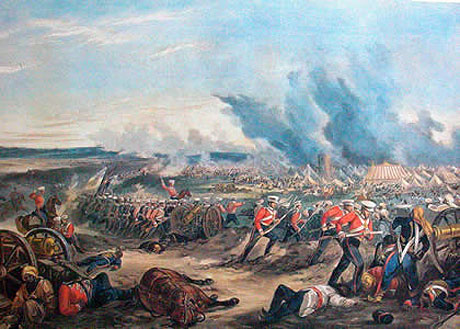
The next day the British came upon the large Sikh entrenchments at Ferozeshah. To the right, the 31st Foot attacking the Sikh fortifications on the morning of the second day of the Battle of Ferozeshah.
Ferozeshah, 21-22 December 1845. "Following Mukdi, the British Army proceeded northwestwards with a view to joining forces with the besieged British garrison of Ferozepore. The Sikh Army did not prevent the meeting of the two forces around its main defensive position centred around the village of Ferozeshah in the early morning of 21 December 1845. Around 4.00pm in the afternoon, the British proceeded to attack the Sikh Army entrenched in the village. The majority of fighting took place in darkness and continued throughout the night with the British succeeded in capturing and securing parts of the Sikh encampment despite fearing Sikh counter-attacks. The British position was precarious. During one stage of the battle, orders were given by the Governor General, Lord Hardinge, who was present throughout the campaign, to destroy all state papers left at Mukdi should the Army be defeated. The next morning, the British attacked and were able to dislodge the remainder of the Sikh Army from the village. By this time, the British Army were exhausted having fought without respite for in excess of 16 hours. By midday, sizeable Sikh reinforcement appeared to the east of the village under command of the Sikh Commander-in-Chief, Tej Singh. The Sikh attack that followed was uncoordinated and lacked direction, which otherwise would have led to victory against the exhausted and depleted British. By 4.00pm in the afternoon, the Sikh Army was ordered by its Commander-in-Chief to withdraw. As at Mukdi, both sides suffered heavy casualties. The two Armies proceeded to disengage, the next notable engagement being some five weeks later."Operations ceased while both armies recovered, but with the Sikh's remaining on the Company side of the border.
The 2nd BNI received battle honors for the Battle of Ferozeshah.
I don't believe the 2nd BNI fought at Aliwal.
Aliwal, 28 January 1846. "The direction of offensive operations by the Sikh Army moved eastwards towards the end of January 1846 with a strong Sikh concentration appearing in the area around Ludhiana. A British force under the able leadership of Sir Harry Smith moved to deal with the threat that the Sikhs now presented to the British supply lines. The Battle of Aliwal witnessed a Sikh force consisting of approximately 7,000 cavalry and 17,000 infantry, half of which were regular troops, in a defensive formation with a river to its rear. Sir Henry Smith was able to direct well co-ordinated attacks using cavalry, artillery and infantry in such a manner resulting in the most decisive outcome for the British during that stage of the war. By late afternoon, the Sikh Army withdrew out of range having been dislodged from the two villages, which formed its main line of defence."
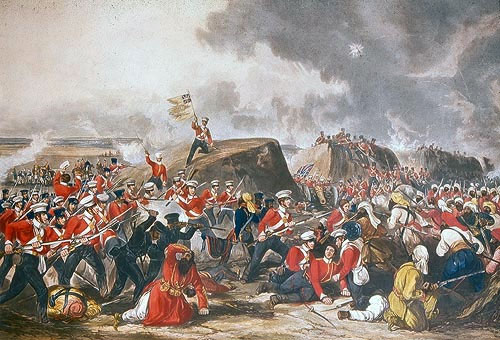 A reinforced Company army then attacked the main Sikh bridgehead across the Sutlej river. Below, the 31st Foot storming the Sikh lines at the Battle of Sobraon. I don't believe the 2nd BNI fought at Sobraon.
A reinforced Company army then attacked the main Sikh bridgehead across the Sutlej river. Below, the 31st Foot storming the Sikh lines at the Battle of Sobraon. I don't believe the 2nd BNI fought at Sobraon.
Sobraon, 10 February 1846. "Following the arrival of heavy artillery from Delhi and the rejoining of forces engaged at Aliwal, the British proceeded towards the Sikh fortified position at Sobraon. Despite being the Commander-in-Chief of the Sikh Army, Tej Singh proceeded to secure the destruction of the Sikh Army by placing his forces behind fortifications with its rear to a wide fast-flowing river, severely inhibiting the Army's manoeuvrability and affording no means of effective withdrawal. Following a punishing two hour bombardment by the British siege artillery, the lines of British infantry began their assault. Initially, the Sikhs were able to repulse the attacks, however having deployed further men, the British was able to exploit the weak east wing of the Sikh defences. As with the previous engagements, the fighting was bitter, with close hand to hand fighting; the Sikhs preferring to rely on their tulwars whilst the British pressed forward with their bayonets. The ferocity of the battle was evidenced by the veteran Sir Henry Smith who described it as "A brutal bulldog fight". Tej Singh fled across the single and feeble bridge of boats which afforded the sole means of withdrawal. Shortly after his flight, the bridge broke. With the British Army driving forward, thousands of Sikhs were to be killed either fighting to the end alongside the resilient Sikh commander, Sham Singh Attariwala or otherwise drowning whilst seeking to reach the other side of the river. The Sikh Army was decimated at Sobraon and would not ever fully recover. Approximately 10,000 were killed and wounded, many being regular troops. British losses were also high, 23,003 killed and wounded, approximately one-seventh of its total strength. The Battle of Sobraon ended the First Sikh War. A peace treaty followed, the Lahore Court remained intact, Tej Singh retained a place in the Council at Lahore working under a British protectorate and the Sikh Army who had underpinned the security and independence of the Lahore Court, had been critically wounded." - from The Anglo Sikh Heritage Trail
In the Treaty of Lahore the Sikh's were forced to give up Kashmir and had to accept a British resident at their capital in Lahore, giving the Company virtual control of the Kingdom. The treaty also gave the fabulous Koh-i-Noor diamond to Queen Victoria. Robert earned a medal and clasp for his actions.
In 1846 Robert was listed as a Lieutenant of the 2nd BNI, stationed at Meerut.
"Bengal.Meerut is north of Agra, and just east of Delhi.
Second Regiment Native Infantry.
Grenadiers.
"Buxar,"--"Guzeratt,"--"Candahar, 1842,"--"Ghuznee,"--"Cabool, 1842,"--"Maharajpoor."
Station--Meerut, Arrived __ 184_
[Seas. of Appt.] 1795, [Names] Colonel T. Wilson, C.B., [Rank in the Regiment] 18Dec.[1]830, [Rank in the Army] M.G. [Major General] 28June[1]838, [Remmards] On furlough
. . .
1842, Lieutenant R.T. Heysham, 24Jan.[1]845, [blank], [blank]" - from "The India Office and Burma Office List" of 1846
Based on information found in a coin-collectors website [which I can no longer locate], Robert was for some years the Director of the Madras Mint, one of the major Mint's in the Indian sub-continent, thus serving along side Barrington, his younger brother. The Madras Mint was established in the 1643 and run by the East India company out of Fort St. George. After 1858 coinage was minted in the name of the British Empire. The mint was closed in 1867. What was Robert, of the Bengal Establishment, doing in the Madras Mint? The only thing I can come up with is that the Bengal Establishment was subordinate to Madras.
I think Robert was the Director of the Madras Mint for the period between 1846 and 1851. This makes sense if he was on detached service, perhaps accruing "time in service" and maintaining his position on the promotion ladder. I think the term I'm looking for here is that he was "seconded" to the Mint. This is primarily a British term referring to a temporary transfer, usually of a military or law enforcement officer. For example, a Colonel John Hainsworth, who was posted to India in 1922 as a Royal Engineers officer, was later "seconded" to the Public Works Department to do civilian engineering projects.
| The Madras Mint
|
In 1848 "Heysham, Lieut. R.T. 2nd N.I. passed exam, in Hindustani." - from "Allen's Indian Mail" of 1848. In the same year his brother, Barrington, arrived in Madras to begin his Indian Army service.
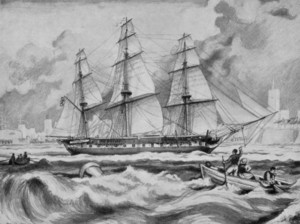 I have an odd reference in the United Services Magazine of 1848, "R. Heysham, to Vernon." The VERNON, left, was a 50-gun ship, a large frigate, which Robert may have visited or ridden. HMS VERNON was commanded by Captain John Coghlan Fitzgerald, the flagship of Rear-Admiral Samuel Hood Inglefield, and operated in the East India stations for a short period. She was in Madras in January 1848. In August she was in Bombay, but she was enroute back to England, where she was to be "paid-off." Perhaps Robert rode her from Madra to Bombay for some "military" purpose; transporting troops?
I have an odd reference in the United Services Magazine of 1848, "R. Heysham, to Vernon." The VERNON, left, was a 50-gun ship, a large frigate, which Robert may have visited or ridden. HMS VERNON was commanded by Captain John Coghlan Fitzgerald, the flagship of Rear-Admiral Samuel Hood Inglefield, and operated in the East India stations for a short period. She was in Madras in January 1848. In August she was in Bombay, but she was enroute back to England, where she was to be "paid-off." Perhaps Robert rode her from Madra to Bombay for some "military" purpose; transporting troops?
The Second Sikh War was fought between November 1848 and 1849. It resulted in the final subjugation of the Sikh empire and annexation of the Punjab. However, I don't show that the 2nd BNI took part.
Between 1837 and 1841 Robert's father died and, in 1850, his grandfather passed away as well.
Per the Bengal Service Army Lists, Robert served in the "2nd NI" [Native Infantry] from 1843 to 1858, but there is a notation, "res Dec 51." That apparently meant he had resigned the service, but why do the records show a continuation through 1858?
Robert "resigned [the HEICS] in 1851 and settled in Australia, where he died in 1868." - from "Elizabeth College Register, 1824-1873: With a Record of Some Earlier Students. A Chapter of..." by Charles James Durand, Edward Charles Ozanne, Elizabeth college, Guernsey, Kentish Brock, Guernsey Elizabeth College. He would have been 42 years old.
The manor of Weston, or Weston Lordship, which had been in the family since 1703, was sold by a "Robert Thornton Heysham" to Samuel Adams in 1852 - from "British History Online." This must be our Robert. I think he came back to England circa 1850, garnered his inheritance, and then sold the Weston estate to clear his grandfather's debts.
Robert returned to India fron London, England in August 1852.
"Passengers ArrivedThis could not have been Robert's younger brother, Barrington, because he was still an Ensign, though he did return to Madras at this time after what was, I presume, the reading of his grandfather's will back in England.
. . .
Per Walmer Castle (Aug. 20), from London.--for Madras.--
. . .
Mr. Heysham, Lieut." - from "Allen's Indian Mail" by W.M.H. Allen and Company, 1852
The following are notices reported in 1852.
"BengalNith is a river on the Scottish side of the Solway firth.
. . .
Medical.
Appointments, &c.
. . .
Heysham, Lieut. R.T. 2nd N.I. permited to resign.
. . .
Military.
Appointments, &c.
. . .
Vandergucht, Ens. B.G. 2nd N.I. to be lieut. fr. Dec. 1, 1851, v. Heysham, resigned."
. . .
Leave of Absence.
. . .
Heysham, Lieut. R.T. 2nd NI fr. Oct. 28 to Dec. 1, to Bombay, prep. to resign, the service.
. . .
Shipping
. . .
Passengers Departed
. . .
Per [steamer] Nith. Mr. R. T. Heysham." - from "Allen's Indian Mail" by W.M.H. Allen and Company, 1852
Robt R. Heysham, Gentleman, aged 27, arrived at Port Phillip Bay and Sydney, Australia on 25 May 1853 onboard the CAROLINE CHISHOLM. This ship was a barque of 366 tons, of Stockton, Australia, captained by Robert B. Trowsdale, circa 1853.
"Should this meet the eye of Mr. Robert Thornton Heysham, who arrived lately from England, he is requested to communicate . . ." - from "The Sydney Morning Herald" of 19 November 1853
There is a Heysham Way in Templestowe, Melbourne, Victoria, Australia, but since it is next to Morecambe Court I have to assume this was named for the village not the man.
I have finally found indications of where Robert spent his final days.
"Daylesford, Co. Talbot1869 was the year after Robert was reported to have died; the data was probably collected in 1868 and not published until the following year.
. . .
Heysham, R.T., accnt., Vincent s[treet]" - from "The Victoria Post Office Directory" of 1869
Was Robert really an accountant or did "accnt." mean something else? Say, living on his accounts?
The town of Daylesford, below, is in the state of Victoria, Australia, northwest of Melbourne in the foothills of the Great Dividing Range. This mountain range is Australia's most substantial and the 4th longest in the world. The lands to the southeast of it are relatively well-watered and verdant. Gold was found there in 1852 which may explain Robert's settling there. The region is also home to a large number of hot springs, which may have been as strong a pull to our aging Robert. Vincent street looks today to be the main street of this town of about 2,000 inhabitants.
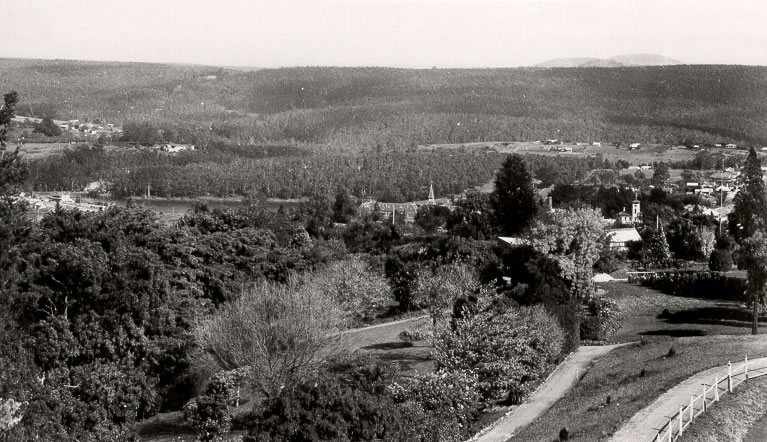
I have no further information for Robert. There is no record of a marriage or a wife. I assume Robert had no male children since his younger brother, Charles, took up the Robert Thornton family name for one of his sons, who did not survive to adulthood.
Deaths. "Heysham--At the Daylesford Hospital, on Saturday, the 31st ult, Robert Thornton Heysham, formerly of the H.E.I.C. service." - from the "Illustrated Australian News" of 20 September 1867.
(24) Frances Mary Heysham (1827)Known as Fanny. She was born on 13 November 1827 in Bath, Somerset and christened on 30 July 1828 in Saint Nicholas, Brighton, Sussex, England.
In the 1841 census of St. Peter Port, Guernsey, the Channel Islands, as Francis Heissham, 13, of England. She was living with her mother, Francis.
In the 1851 census of Stoke Damerel, Devonshire as Frances M. Heysham, 23, of Somerset, Bath. She was living at home at 3 Park Place, Devonport. Fanny Mary Heysham died in January-March 1854 at Newton Abbot, Devon, only 26 years old.
1854, Obituaries. "At Teignmonth, aged 26, Frances-Mary, second dau. of the late R. Thornton Heysham, esq. of Bath." - from "The Gentleman's Magazine"She apparently never married. (24) Georgina Heysham (1830)
In the 1841 census of St. Peter Port, Guernsey, the Channel Islands, as Georgina Heissham, 11, of England. She was living at home with her mother, Francis. She died in 1846.
"Guernsey.-Lately. Aged 16, Georgiana, third dau. of Robt. Thornton Heysham, esq." - from "The Gentleman's Magazine" of 1846(24) Lieutenant General Barrington Frederick Heysham (1831)
Barrington Frederick Heysham, the son of Robert Thornton Heysham and Frances Price, was born on 5 Febraury 1831 in Farrington, Hampshire, England. He was named for his grandfather, Colonel Barrington Price.
In the 1841 census of St. Peter Port, Guernsey, the Channel Islands, as Barrington Heissham, 10, of England. He was living with his widowed mother, Francis.
In 1844, at the age of 13, he and his brother, Charles Augustus John Heysham, were students at Elizabeth College, St. Peter Port, Guernsey, the Channel Islands. This is a secondary school, or high school, with grades 7-8-9-10-11. Both boys were listed in the College register as non-Channel Island residents. Note that in 1834 Robert Thornton Heysham also attended this school.
Barrington left the Elizabeth College in 1846.
After having received a gentleman's education in mathematics and the classics, he applied for admission to Addiscombe, the school for young men seeking to joing the East India Company army as officers. With the proper recommendations and upon passing the entrance examinations, he would have been accepted as a Cadet.
From - "Cadet Papers 1789-1859": Barrington Frederick Heysham, 1847-1848He would have been 16-17 years old. That is, about six years after his brother, Robert Thornton Heysham.
Cadet Papers denote entry into service with the East India Company Army, 1753-1861, or, from 1861-1940, with the Indian Army. While a commission in the British Army had to be bought and the pay was low, as an officer in Company service Barrington would have been able to send money home to support his widowed mother and provide dowries for his sisters.
| Addiscombe House
In 1702 'Addiscombe Place' was built to Vanbrugh's design on the site of a previous Elizabethan mansion. It stood close to the present day junction of Outram Road and Mulberry Lane in Surrey. Sir John Vanbrugh (1664-1726) architect and dramatist, was a prime exponent of the English Baroque whose best-known design is 'Blenheim Palace.' Its magnificent effect relies on vast columns and massive masonry, an effect echoed at Addiscombe on a smaller scale. The house was reputedly very finely detailed internally, with intricate plasterwork, fine staircases and fireplaces.
'Addiscombe Place' and its estate of 82 acres were purchased in 1809 by the East India Company to form a military college to train their cadets. Buildings were added to accommodate the dining and lecture halls, chapel, armoury, model-room, library, classrooms, chapel, and studies for the professors and masters. The cadets were admitted aged 14-18 and studied mathematics, fortification, drawing & surveying, the theory of artillery, French, Latin, Hindustani, philosophy, chemistry and geology. They also had a Dancing Master provided to insure the cadets entered the world as gentlemen. A Cadet's Typical Day"Our mode of life had a great deal of regularity. At 6am the bugle call of reveille forced us from our beds and we had to be on parade at 6.30 when we were marched into chapel for prayers. Immediately after we went into study and remained till 8.00 when we partook of breakfast. This was soon over and we were allowed leisure till 9.00 when came study again. At 11.00 we had a few minutes breathing time and again went to study till 1pm when we marched to the dining-hall for dinner. After this we were allowed till 2.00 for football or any other recreation, when again followed study. At 4pm we were free, except twice a week when drill was the order of the day. From 4.00 to 6.00 we were allowed to do as we pleased. At 6.00 came tea and after this sometimes study again, but occasionally we had 'library'. At 9pm we were marched into chapel for prayers and by 10.00 we were supposed to be in bed." There were two terms per year, February to mid June and August to mid December. The fee was £50 per term and each term closed with a public examination. Cadets were grouped by intake and were called 'Greens' in term 1, 'Browns' in 2, 'Young Cadets' in 3 and 'Old Cadets' in their last term. There were obligations according to seniority, so the rules were strictest for the Greens. Upon graduating, called passing out, the new officers would be presented with a 'passing out certificate.' In 1858, as a result of the Indian Mutiny, the government of India was transferred to the Crown. The East India Company was dissolved and the college was closed three years later in 1861. During its half-century existence 3,474 cadets had passed through the college. In 1863 the British Land Company bought the complete Estate for £33,600, demolished the buildings except the gymnasium, and sub-divided the property for development. The above was taken from an excellent site, Addiscombe, Croydon by Alan Barber. Please visit the site for more information. |
Upon graduation Barrington would have been commissioned as an Ensign. I've noted that some graduates of the Company school were commissioned as 2nd Lieutenants. Why the difference? From the 18th century Ensign was the lowest commissioned officer rank in the infantry. In 1871 the rank was abolished and replaced by Second Lieutenant. Ensigns were named for the Ensign or Colour which they carried. By the way, during the same period the lowest officer rank in the cavalry was Coronet.
Barrington proceeded to Madras, in India, via steamer.
"Cadets for the Madras Engineers, Artillery, Cavalry, and Infantry.Mr. Heysham was also shown arriving in Madras on the PLANTAGENET with two servants. There was a ship of this name on the Australian emigrant route, circa 1854. For Barrington's trip, the captain of PLANTAGENET was G. E. Bird.
. . .
For the Infantry.
To rank from the date of the sailing from Gravesend of the ship by which he proceeded, viz.--
Barrington Frederick Heysham, [steamer] Plantagenet, 3rd April." - from "Allen's Indian Mail and Register of Intelligence" of 1848
| Madras, India
Located on the south-eastern coast of India, just north of the island of Ceylon. The British The fort is now the home of the local legislature. |
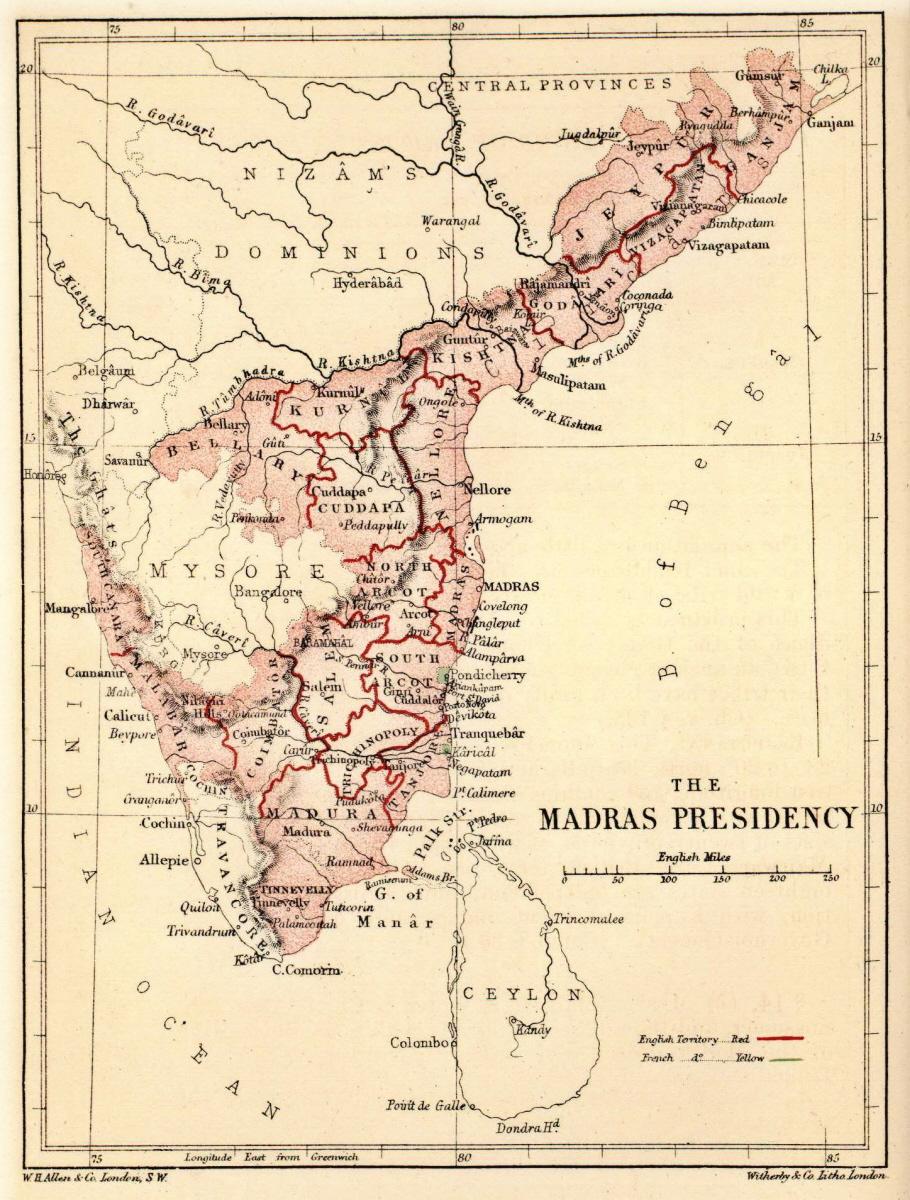
| The Madras Army
For more than 150 years the Honourable East India Company, also known as John Company, had raised its own armed forces. The three administrative areas of India, the Presidencies of Bombay, Madras and Bengal each maintained their own army with its own commander-in-chief. These armies were paid for entirely out of the Company's Indian revenues and together were larger than the British Army itself.
There were a few regiments of European infantry but the vast majority of the Company's soldiers were native troops. These sepoys, as they were called, were mostly high caste Hindus. They were organised in numbered regiments and drilled British style. The sepoy regiments were officered by Europeans, with a stiffening of European NCO's, and were treated with great affection and trust by their regimental commanders. Somewhere along the way, however, the Britsh seemed to lose touch with their Indian subjects. Some blamed the advent of steamships that so reduced the journey times from Britain to India that it was now possible for officers to go home on leave and for wives and children to come out and live with their menfolk. Before officers had spent all their time with their sepoys or with Indian mistresses; now a re-creation of English domestic bliss awaited them when their hours of duty were over. The closeness of the British and the Indians so apparent in the early days of the British presence started to fade and by 1857 it was a gulf. The oldest element of the Indian Army, the Madras regiment was raised in 1758 for the defense of Fort St. George by the East India Company and placed under the command of the great Robert Clive. In 1803, the Madras Army under Arthur Wellesely, the future Duke of Wellington, defeated the Peshwa army at the battle of Assaye and won general acclaim for their bravery. In recognition of their fierce fighting qualities they were awarded the the insignia of an Assaye Elephant which is worn to this day. By the way, Assaye was Wellington's 'favorite' battle because it was fought at long odds, involved expert generalship on his part, and resulted in total victory. |
Barrington was an Ensign in the HEICS Madras Army in 1848. While assigned to the 13th Native Infantry, he initially served in the 1st European Madras Fusiliers.
"Heysham, Ens. B.F. to do duty with 1st fusil. and to join with detach. of that corps under ch. of Capt. Babington
. . .
Heysham, Ens. B.F. doing duty with 1st fusil, removed to 13th N.I. as 5th ens.; to rank fr. April 3, 1848." - from "Allen's Indian Mail" of 1848
| Madras European Fusiliers
There were three European units in the Madras Army, the 1st Fusiliers, 2nd Light Infantry, and the 3rd Infantry. The 1st Fusiliers fought during the Second Anglo-Burmese War, 1852-1853, including at the Battle of Pegu. This was the second of three wars in which Burma was annexed. During the Sepoy Rebellion, 1857-1858, they fought at Benares, Allahabad, the Relief of Lucknow, Behar [Bithur], and Cawnpore. After the Mutiny was put down the Madras and Bombay Fusilliers of the East India Company were formed into the Dublin Fusiliers under Crown control and, in 1862, was amalgamated with the Imperial Army as the 102nd and 103rd Regiments of Foot. |
"Madras.The 18th N.I. above is in error, the 13th was meant. The ceded districts referred to an area ceded to the Company in 1800 by the Nizam of Hyderabad. It corresponded to Bellary, Cuddapa, and Kurnul in the map above.
Military Appointments, &c.
. . .
Heysham, Ens. B.F. 13th N.I. to cont. to do duty with 1st Mad. fus. until the 18th N.I. enters the limits of the ceded districts, to which point he will proceed to join." - from "Allen's Indian Mail and Register of Intelligence" of 1849.
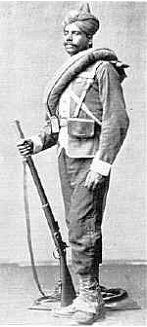 Thirteenth Regiment Madras Native Infantry Thirteenth Regiment Madras Native Infantry
While the regiment had fought at the battles of Sholinghur, Carnatic, Mysore, and Seringapatam, these had occurred years before Barrington Heysham's tour in the 1850s. However, while there were no major battles in southern India at this time, the peace was punctured by the Sepoy Mutiny, 1857-1859. Elements of the Madras Army, including the 1st Fusiliers, were engaged in the relief of Cawnpore and Lucknow, both in the Ganges valley. There is no evidence that the 13th took any part, however. Duty in the second half of the 19th century would have included dusty patrols showing the flag and pursuing bandits. Above, a sepoy of the Madras Infantry, circa 1887. |
From the "Madras Service Army Lists" - 1849-1858, Heysham, Barrington F., 13th Native Infantry. From "Officers of the Thirteenth Regiment Madras Native Infantry, Madras Army of the Honorable East India Company, Stationed at Cuddapah" as listed in the East-India Register, 1850: "Barrington Frederick Heysham, appointed to the Army in 1848, commissioned as an Ensign on 8 November, currently on furlough." Also as,
Officers of the Thirteenth Regiment Madras Native Infantry Stationed at Cuddapah; arrived February 1849.
Col Lewis Wentworth Watson
. . .
Ensigns -
Year of appointment to Army: 1848
Officer's name: Barrington Frederick Heysham
Date of commission to current regimental rank: 8 November 1848
Date to rank in the Army: 3 April 1848
on furlough
- from the East-India Register, 1850
| Cuddapah
A town and district of British India in the Madras Presidency. The town is located on the right bank of the river Pennar, about 160 miles from Madras. It was an administrative center for the collection of taxes. Now known as Kadapa. |
In 1849 Barrington's grandfather wrote his will (Barrington's father had already died, probably in 1841). Was he already ill-to-death at that point? Regardless, Barrington hopped a ship for home.
"Leave of Absence.What does "m.c." mean? During my military service we would have called it compassionate leave. I believe this refers to "Medicual Certificate," normally referring to sick leave, that is, being in quarters due to an illness, but in this case a medical condition, a death, back in England. Barrington sailed on the NORTHUMBERLAND, commanded by Captain A. Parish.
. . .
Heysham, Ens. B. F. 13th NI, to Europe, on m.c." - from "Allen's Indian Mail" of 1849
"Departure: 13 October 1849Barrington's grandfather then died in January 1850.
Ship: Northumberland
Captain: A. Parish
Passenger: Ensign B.F. Heysham Occupation: 13th Regt. N.I.
Origin: Madras
Desitination: London
Port1: The Cape"
- from the "Madras Almanac" of 1850
In the 1851 census of Stoke Damerel, Devonshire as Barrington F. Heysham, a 20 year old Ensign in the East India Company Service, unmarried. He was residing at 3 Park Place, Devonport. He was home on leave [furlough]. This was probably related to the death of his grandfather and the reading of the various wills. Barrington's brother, Robert Thornton, resigned the service at about the time.
Barrington took part in an amateur theatrical while home.
"Plymouth.--(From a Correspondent.)--On Monday the 10th inst., the gentleman amateurs of the neighborhood sustained the principal parts of the well known drama, Don Caesar de Bazan . . . after which, the amateurs again presented themselves in the farce, You can't Marry your Grandmother. Lieutenant Warren, R.N., as Algernon Bloomly, and Lieutenant Heysham, 13th M.N.I., as Ready, displayed self possession rarely to be met with in amateurs; and kept the house in a ceaseless roar of merriment." - from "The Musical World" of 1851
| Don Cesar de Bazan
A drama, based on the Guy Blas of Victor Hugo, in five acts, "mingled with song," written in 1844. Mistaken identities, a woman's virtue threatened, a secret wedding, and so forth. You Can't Marry Your GrandmotherA farce by Thomas Haynes Bayly, first performed in London on 1 March 1838. A grandfather with a charming ward, a mock wedding between them, and a grandson who finds his true love with the ward, who replies, "you can't marry your grandmother!" |
In 1852 Barrington returned to Madras, India aboard the WALMER CASTLE, commanded by Captain W.B. Pryce.
"Passengers ArrivedLieut. Heysham must be Barrington's older brother, Robert Thornton Heysham.
. . .
Per Walmer Castle (Aug. 20), from London.--for Madras.--
. . .
Mr. Heysham, Lieut.
. . .
Permitted to Return to Their Duty.
Military.
Madras Estab.--
. . .
Ens. B.F. Heysham, 13th N.I.
. . .
" - from "Allen's Indian Mail" by W.M.H. Allen and Company, 1852
"To be Lieutenants.
. . .
Lieutenant Barrington Frederick Heysham, of the 13th Native Infantry. Dated 15th April, 1853." - from "Bulletins and Other State Intelligence" of 1863
Barrington married Charlotte M. Nicholls in 1853 in Madras - from the Madras Marriage Index.
Groom: HeyshamShe may have been one of those young women who took a tour of India in hopes of finding a husband. The ships that carried these hopeful women to the colonies were known as the "fishing fleet." Alternately Barrington may have met her while home on leave in 1851 - that may, in fact, have been the reason for his returning home. She was born in London, Middlesex, England. Her father may have been Lieutenant Colonel Cecil Nicholls, of the Madras Staff Corp., 1873. From 1849 to 1858 Barrington was on the Madras Service Army List, still in the 13th Native Infantry.
First names: B Fe
Bride: Nicholls
First names: Charlotte Mary
Place: Trichinopoly
Year: 1853
Month: Jun
Day: 20
Register Entry: At St John's Church Trichinopoly on Monday the 20th June by the Revd G.E. Morris BA, Chaplain, B. Fe. . ." - from the "Bombay Times and Journal of Commerce" of 2 July 1853
Barrington took and passed his examination in Hindustani.
"Heysham, Lieut. B. F. 13th N.I. exam. in Hindustani; cred-. prog." - from "Allen's Indian Mail" of 1854His pay was probably affected by this and were his prospects for promotion.
How did the Sepoy Mutiny affect Barrington? The rebellion found few adherents among the native population in Madras. This does not mean that the people of the south were docile, but they did not identify with the Hindustanis of the Gangetic plains who were at the center of the mutiny. Administration of Madras by the East India Company had produced peace and security. There were cases of individual mutiny in the Madras Cavalry, but these were isolated incidents having more to do with the high proportion of Hindustani Muslims in their ranks. As a regiment no unit of the Madras Army was disbanded or disarmed.
Within the British community, however, the mutiny would have engendered widespread panic. As news of the atrocities in the north spread, Barrington's wife would have begun to distrust her own servants and to wonder if she was going to be murdered in her sleep.
The Madras Army was, instead, employed in putting down the rebellion. The 1st Fusiliers were engaged in the relief of Cawnpore and Lucknow, in the Ganges valley, but it is not clear if Barrington was still in this unit at the time, or whether he had transferred to the 13th Madras N.I. The latter took no part in putting down the rebellion.
On 19 September 1859 Mrs. Heysham arrived in Madras onboard the CLARENCE, commanded by L.W. Vaile. She had left London on 1 July - from the "Madras Almanac" of 1860.
Barrington Frederick Heysham made Captain on 15 September 1861. - from "Elizabeth College Register, 1824-1873: With a Record of Some Earlier Students. A Chapter of..." by Charles James Durand, Edward Charles Ozanne, Elizabeth college, Guernsey, Kentish Brock, Guernsey Elizabeth College. Also,
"To be Captain.The following is a more complete listing of Barrington's advancements while attached the the 13th N.I.
. . .
Lieutenant Barrington Frederick Heysham,
Dated 15th September 1861." - from "Bulletins and Other State Intelligence" of 1863
"Barrington Frederick Heysham
Ensign 8/11/1848 Q.M. and Int. 27/4/1857
Lieutenant 5/3/1853 Transferred 25/11/1867
Captain 29/5/1865
" - from "Historical Records of the XIII Madras Infantry" by Robert Pilkington Jackson
From the Madras Army Records - Heysham, Barrington Frederick was in the Madras Staff Corps from 1862-1863, 1869-1871, and 1877-1878. That is, he was no longer with the 13th Native Infantry as a front-line commander of troops. He was, to the contrary, in charge of support operations behind the lines. From records of a report submitted to the Commisary General, Madras (that is, the chief Supply officer), we discover that Barrington was on active duty from 1848 to 1880. In 1900, the date of the report, he was a Lieutenant Colonel. He retired as a Major General.
The British counsel to Abyssinia, Charles Duncan Cameron, was imprisoned in the fortress of Magdala by the African Emperor. The British government, unable to win his release, responded by declaring war in July 1867. Sir Robert Napier led a force made up of units from the Indian army. Barrington Heysham went along with the commissariat.
"Resolution of the Bombay GovernmentIn the same document "Major B. F. Heysham" was employed as follows:
Bombay Castle, 30th September 1867.The following establishement is approved for the Commissariat Department of the Abyssinian expedition:
. . .
Deputy Assistant Commissaries-General, 1st class, Captain Clarke, Captain Heysham (Madras Staff Corps), Major Thacker and Captain Phelps." - from "Accounts and Papers of the House of Commons"
"Attached to Zoolla depot. Charge of Bunder, landing and shipping stores. Visited ports in the Red Sea, on Special duty."Zoolla is a village on Annesley Bay, in Ethiopia. It was selected as the army's base of operations since it had good water. However the shelving nature of the beach required the building of piers to support British shipping. Bunder was probably Bandar Abbas, the capital; charge meant "in charge," not a military action. Barrington's port visits was probably to arrange for fresh provisions; fruits, vegatables, and livestock.
Scientific experts were also brought on the expedition, much as Napoleon did on his conquest of Egypt, who made geological and zoological observations.
"The true Gazelle of the Abyssinian coast-land appears to differ in no essential character from that of Northern Africa . . . The figures of G. dorcas are from specimens shot by myself near Zulla, that of G. arabica from a head for which I am indebted to Captain Heysham of the Commissariat, who obtained it at Mochas." - from "Observations on the Geology and Zoology of Abyssinia: made during the progress of the British Expedition to that Country in 1867-68" by William Thomas BlanfordMocha is in Yemen, and gives it's name to the coffee, so perhaps Barrington did his hunting there? The British army was comprised 16,000 combatants, an equal number of servants, and forty-five elephants. They landed in Africa on 3 January 1868 and began their march inland. They fought one pitched battle, in which European rifles quickly routed the Ethiopian army, and a two-hour siege of Magdala, which afterwards surrendered. The counsel was released and the army returned to India.
Captain B. F. Heysham was promoted to Major on 3 April 1868. - from "United Service Magazine"
In the 1871 census of England, Barrington, aged 40, and Charlotte, aged 36, are living in Paddington parish, in the borough of Marylebone, in London. He was shown as a Major in HMS Madras Staff. Living with them are Caroline A. Drury, Barrington's widowed sister, along with her two daughter's, Rosa and Alice. There is also a Lady's maid listed, Anne Bennet, aged 69, of Wiltshire. I assume this is the same maid that was part of Barrington's mother's household. This was probably a short stay in England after which Barrington returned to India.
On 16 June 1871 Major and Mrs. Heysham sailed on the COLUMBIAN, a steamship of the P&O line, commanded by Captain N. Stewart, from Southampton, England to Madras - from the Times of India.
There is a Major Barrington Frederick Heysham, a Madras Staff Corps Officer in Hart's Army List of 1873. After the mutiny the army of the East India Company was absorbed into the British Army as the Indian Army.
In 1874 he was made Lieutenant Colonel, and in 1879 Brevet-Colonel. Quarter-Master and Interpreter to his regiment in 1857. Commissariat Department, 1857 to 1880. Abyssinian Campaign, 1867-68 (medal); deputed to visit the ports in the Red Sea to obtain supplies (highly commended for his services); Executive Commissariat Officer at Bellary during the great famine of 1876; received the special thanks of the Major-General Commanding for his exertions on that occassion; retired as Major-General in 1880; residence, Godalming - from "Elizabeth College Register, 1824-1873: With a Record of Some Earlier Students. A Chapter of... " by Charles James Durand, Edward Charles Ozanne, Elizabeth college, Guernsey, Kentish Brock, Guernsey Elizabeth College
On 9 August 1878 Colonel Heysham sailed on the AUSTRALIA, a steamship of the P&O line, commanded by Captain G.F. Cates, from Bombay to Venice and thene to Southampton.
In the United Kingdom National Register of Archives, British Library, Oriental and India Office Collection: Papers of Lieutenant Colonel Barrington Frederick Heysham, c1880: Copies of reports submitted to the Commissary General, Madras by the Acting Assistant Commissary General [Barrington] at Madras (d1900), Madras Army 1948-1880, concerning details of army transport and provisioning. Was this written after his retirement?
Barrington showed a previously unsuspected breadth of knowledge and scientific interest in elephants,
"Elephas indieus. Some notes by Capt. Heysham on the period of gestation of this species are recorded in Proc. Zool. Soc. 1865, p. 731." - from "The Zoological Record."In 1880 there is another reference to a "Colonel Heysham, of the Madras Commissariat Staff." "Accordings to Colonel Heysham the period in the two cases noted was nineteen months." The article addresses breeding in captivity and period of gestation of the Indian elephant. This is included in both the "Zoological Record" and the "Annual Report of the Board of Regents of the Smithsonian Institution." He was also found in the bibliography of "Medial Management of the Elephant," Mikota, Sargent and Ranglack, Indira Press, 1994 is "Heysham, (1880) Col. Heysham on the breeding of elephants. Proc Zool Soc Lond 23-24."
On 8 October 1880 he was promoted to Major General and retired, per the Indian Army Quarterly List. In the 1881 census as Barrington F. Heysham, Major General of Her Majesty's Indian Army, retired, living at Nightingale road Netherwood, in Godalming, Surrey. His wife Charlotte was living with him, aged 46. No children are shown and there are no indications they ever had any on their long years of service in Madras. The "Plantagenet Roll of the Blood Royal" indicates Charlotte died s.p., sine prole, without issue. Isabella M. Avery, Barrington's 33 year old sister-in-law, and Fanny C. Pinckle, Charlotte's 20 year old niece, were living with them.
In the 1891 census of Godalming, Surrey as Barrington Heysham, a 60 year old retired Major General. Living with him was Charlotte, aged 56.
| Godalming, England
Godalming is located midway between London and Portsmouth on the south coast of England, in the county of Surrey. It is situated among some of the finest countryside in southern England. Its narrow attractive streets, lined with many ancient and historic buildings, lie on well drained land above the meadows of the River Wey. Beautiful wooded hills rise steeply all around, forming a backcloth which greatly enhances the rural setting of the town. |
In the 1901 census of Hove, Sussex [this is near Brighton] as Barrington Fredk Heysham [Heysham Smith in Ancestry.com], a 70 year old retired Major General of HMS [?] Madras Staff Corps, of Farringdon. Living with him was his wife, Charlotte Mary, 61, of West Molasey, Surrey, and his sister-in-law, Isabella Marion Nicholas, 53, of Islington.
In the 1911 census of Steyning, Sussex at Barrington Heysham, aged 80. Living with him was his wife, Charlotte, 77.
From records related to the administration of service and family pension funds of the East India Company and India Office: Madras Military Fund: Roll of subscribers:
Madras Army, b 5 Feb 1831, d 30 Dec 1913
Retired 8 Oct 1880
m Charlotte Mary 20 Jun 1853 (b 26 Aug 1834, d 4 Jan 1914)"
Barrington F. Heysham died in January-March 1914 in Steyning, Sussex. Charlotte M. Heysham died at the same place and time.
"Heysham Barrington Frederick of 12 Ventnor-villas Hove Sussex died 30 December 1913 Probate London 14 February to Annie Matthews Wilson widow and Sydney Jacomb-Hood solicitor. Effects L5544 5s. 10d."
"Heysham Charlotte Mary of 12 Ventnor-villas Hove Sussex widow died 4 January 1914 Probate London 18 February to John Stanley Puckle colonial broker. Effects L2912 6s. 2d." - from the National Probate Calendar
The son of Robert Thornton & Frances Heysham. He was born on 4 October 1832 in Ropley, Hampshire, but not christened until 30 January 1834.
| Ropley
Ropley is a large parish 4 miles east of Alresford, Hampshire. The great houses are Ropley Lodge, Ropley House, and Ropley Manor, known as Ropley Cottage until 1920. |
In the 1841 census of St. Peter Port, Guernsey, the Channel Islands, as Charles Heissham, 8, of England. He was living with his mother, Francis.
He attended Elizabeth College, a secondary school on Guernsey Island, in 1844 and left in 1845 to join the Royal Navy. This was a year before his older brother, Barrington, left the school.
Charles entered the Royal Navy in 1845, right out of Elizabeth College. He was 13 years old. In the early 19th century boys as young as 12 would join as Midshipmen.
| The Royal Navy in the 19th Century
The Royal Navy's great reputation rests on their performance during the period from the Seven Years War to the end of the Napoleanic Wars, when the fleet's wooden walls alone stood against the seemingly unstoppable armies of the French Empereor. It was the legends of Pellew, Cochrane and Nelson that inspired the pens of C.S. Forester and Patrick O'Brian. Queen Victoria's Navy, the fleet of the mid-19th century, was a different force. Still aligned in opposition to a supposed French naval enemy, they spent most of their productive efforts in gunboat diplomacy in the third world. The fighting qualities of the force suffered when a 'smart' appearance became more important that smart performance. There is a story that one Captain who dumped his annual allocation of training ordnance over the side rather than fire the guns and blacken the ship's paint. It was, however, also a period of rapid technological change with the introduction of steam power, breech-loading guns and armor plate. With the single exception of the period of the American Civil War, England led the world in the introduction of all of these technologies. |
Circa 1845-1849. "CAJ Heysham to Hastings" - from "The United Services Magazine," 1849. This would have put Charles into the Far East.
| HMS HASTINGS
A 74 gun ship of the line. She was built in Calcutta, India by the East India Company as a speculation and acquired by the British government in June 1819. She was named for the Governor General of India, Lord Hastings. HASTINGS had been laid-up from 1842 to 1848 in Portsmouth. In April 1848 she re-entered service, under Captain James William Morgan, as the flagship of Rear Admiral Francis Augustus Collier, of the East Indies squadron. She operated mainly out of Hong Kong and Singapore. In January 1850 she came under the command of Captain Francis William Austen as the flagship of Rear Admiral Charles John Austen [some nepotism here?], East Indies. She was engaged in many actions from the Second Burmese War to fighting pirates in China. She returned to England in 1852. She was converted to screw propulsion in February 1855 and served as a coastal defense ship out of Liverpool. She was last in commission in 1866 and disposed in 1885. |
"Chas. Augustus John Heysham" was advanced from Midshipman to Mate on 1 December 1851 - from the "Royal Navy List" of December 1852.
| The Mate
The mate was originally the assistant to the ship's master. Master's mates of the Royal Navy were initially considered apprentices for the position of master and were usually experienced seamen. During the wars of the 1700s this changed somewhat. Midshipmen, waiting long years for promotion to lieutenant, began to take appointments as master's mates for the sake of better pay. As this practice continued, master's mate became a standard step in the training of the commissioned officer. The master's apprentice became the Second Master. In 1840, mate (the "master's" having been dropped) became a commissioned rank, and in 1861 was renamed sub-lieutenant. |
12 October 1852 Chas. Augustus John Heysham, Mate, reported onboard HMS AGAMEMNON, a 91-gun line-of-battle ship. His Captain was Sir Thomas Maitland - from the "Navy List" of December 1852. Based on the information below, Charles may have been part of the commissioning crew, that is "plank owner."
| The AGAMEMNON
Her first Captain, in the shipyard at Sheerness, was Sir Thomas Maitland. He may have taken her into the Mediterranean on her first deployment. By 1853 he had been relieved by Captain Thomas Matthew Charles Symons who commanded her during the Crimean War, which started in 1854. She was the flagship of Rear Admiral Lyons. An interesting note, the British survivors of the "Charge of the Light Brigade" were repatriated onboard AGAMEMNON. HMS AGAMEMONON was used, along with the American USS NIAGARA, in the first attempts to lay a Transatlantic cable, unsuccessfully in 1857, and successfully in 1858. The cable, however, fell silent soon after. By 1862 she was out of commission and was later sold in 1870. Sir Thomas MaitlandThe 11th Earl of Lauderdale was Thomas Maitland. He was born on 3 February 1803, the son of General William Mordaunt Maitland, who was himself a son of the 7th Earl. In 1828 he married Amelia the daughter of William Young of Rio de Janeiro, Brazil. Before AGAMEMNON he had been the Captain of IMPREGNABLE, from January 1849 to 1852. Afterwards he was the Captain of VICTORY from December 1853 to March 1854. He received the Order of the Bath (G.C.B.), was an Admiral of the Royal Navy and principal naval A.D.C. to Queen Victoria. He was a representative Peer for Scotland and a Knight of King Charles III of Spain. He became Earl in 1863 upon the death of his uncle, Anthony Maitland. He died on 1 September 1878. |
Charles left AGAMEMNON about the same time Captain Maitland did, in 1853.
"C.A.J. Heysham (1851 [his date of rank to Mate]) to Plumper;" - from "The United Service Magazine" 1852This was for duty in the anti-slavery patrol - perhaps atonement for the dealings of his great uncles, Giles, Robert, and William Heysham.
| HMS PLUMPER
In the etching to the left, HMS Plumper (right), HMS Termagant (left), and HMS Alert (background) are shown at Esquimalt. |
Charles quickly moved on, however, to the HMS PLUTO, but apparently still on anti-slavery patrol. Charles A. J. Heysham was listed as Mate of HMS PLUTO on 17 August 1853 under Command Norman B. Bedginfeld. Articles of Agreement between the Chiefs and Headmen of the Congo river and Her Majesty's goverment were negotiated by Lieutenant Commander Norman B. Bendingfeld and the officers of Her Majesty's ship, PLUTO, on 20 June 1854. C.A.J. Heysham was listed as Mate of the PLUTO, and a signatory. The Master of the brig SABRAON, John Cheesman, also signed. Charles undoubtedly met Doctor Livingston - of "Dr Livingston, I presume" fame - when the great man visited the PLUTO at St. Paul de Loanda, Angola, in 1854- from "Dr. Livingston's Cambridge Lectures" by David Livingston. The Doctor had selected Captain Bedingfeld as his naval officer on an expedition.
| HMS PLUTO
He spent more than 18 years in river navigation and negotiated many treaties with the natives for the suppression of the slave trade. He commanded the PEARL in 1858 during the Livingston expedition and the PROMETHEUS in 1861. Senior Officer of the Bights Division. |
Charles made the significant step to Lieutenant on 9 November 1854, when he would have been transferred off his old ship. The Captain of the PLUTO, Bedingfeld, had left his ship in October 1854 to return to England to recuperate from an illness.
Charles A.J. Heysham, Lieutenant, reported aboard HMS LINNET in 1855 - from the "Navy List" of December 1855. LINNET was a packet brig, of 8-guns, operating off the west coast of Africa on the anti-slavery patrol. Her Captain was Commander Henry Need. He was an amateur artist and created several excellent watercolors,
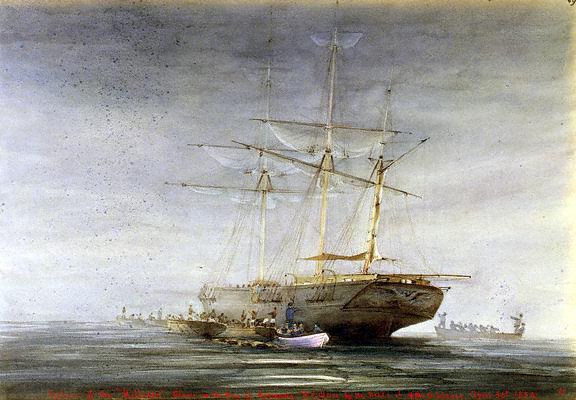
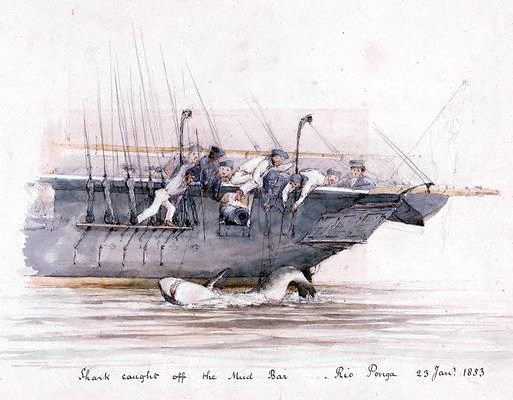
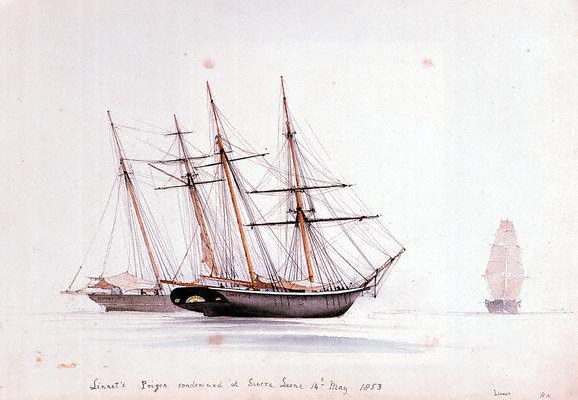
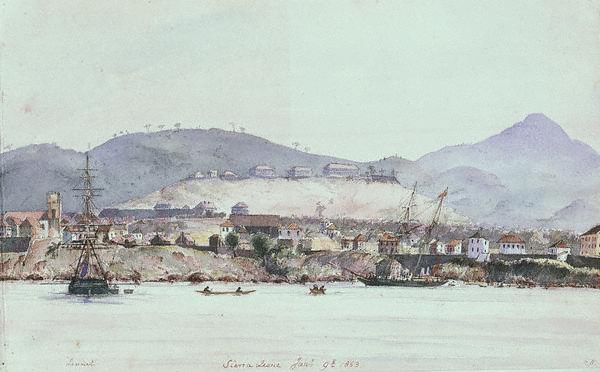
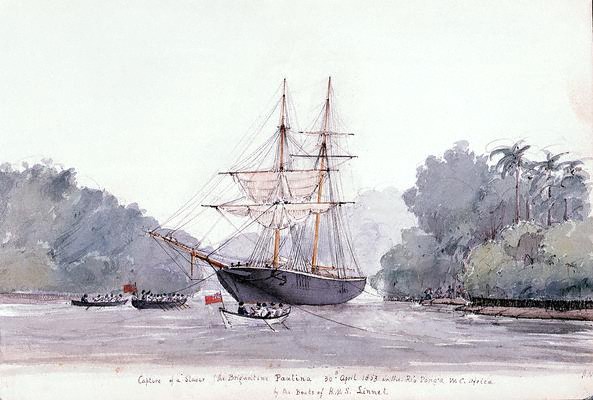
". . . Lieutenant Charles Augustus John Heysham, RN, to command a [Coast Guard] Station . . ." - from "The United Service Magazine" of 1857.
Circa 1859 Charles came back home for service in the Coast Guard. "CAJ Heysham, 1854 [date of rank to Lieutenant], to Ajax" - from "The United Service Magazine" of 1859. Considering the frequent changes in commands seen previously, and subsequently, I'm assuming we're missing a ship here. His time at this assignment may have been a holding action while a new sea-going command was available.
| HMS AJAX
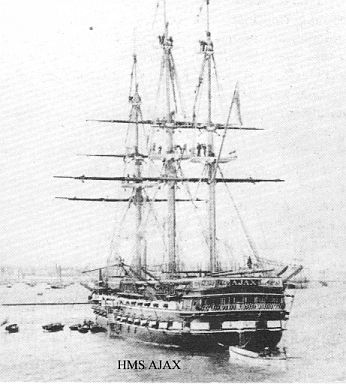 The Coast Guard Service
The Coast Guard Service
The Coast Guard of England had been, like the U.S. Coast Guard, a Revenue Service committed to stopping smuggling. In 1831 the Admiralty decided that it should become a reserve for the Royal Navy. Its roles were defined in 1856 as Defense of the Coasts, More ready manning of HM ships in war or emergency and Protection of the revenue. In the post-Napoleonic period the anti-smuggling mission of the Coast Guard was one of the few areas where an officer could shine. |
Circa 1860 Lieutenant Heysham reported onboard the sloop HMS MUTINE, commanded by William Graham, operating in the Pacific.
| HMS MUTINE
MUTINE was a wooden, screw-driven sloop of the GREYHOUND Class, launched on 30 July 1859 at the Deptford dockyards. She weighed 1291 tons and mounted 17 guns. Her first captain, from 21 October 1859 to 5 January 1864, was Commander William Graham. From the Times newspaper: 4 November 1859. "Her Majesty's screw steamsloop Mutine, Commander W. Graham, yesterday commenced receiving her stores in preparation for sea. One sergeant, one corporal, and 16 privates of the Royal Marines will embark to-day from the Woolwich division. The paddlewheel steam-sloop Prometheus, Commander Skipwith, sailed from Woolwich yesterday at 315 p.m., and proceeded to Greenhithe to adjust compasses in preparation to join the Channel fleet." 19 January 1860. "The screw line-of-battle ships in Portland harbour are the Edgar, 91, flagship of Rear-Admiral Erskine, second in command of the Channel fleet; Donegal, 101; Hero, 91; Algiers, 91; Trafalgar, 91; Aboukir, 91; and the Mars, 80. The screw frigate Diadem, 32; the screw corvette Mutine, 18; and the gunboats Flying Fish, 6; and the Partridge, 2. The paddlewheel steam frigate Prometheus, 6, and the Coastguard ship Blenheim are also at anchor. The Royal Albert, 121, is daily expected from Plymouth." 23 February 1860. "The screw steam frigate Diadem, 32, Capt. James H. Cockburn, arrived at Portland on Tuesday from Portsmouth. A portion of the Channel fleet is expected to leave that harbour in a few days for the Tagus. The vessels now in port are the Royal Albert, 121; Edgar, 91; Queen, 91; Algiers, 91: Donegal, 101; Hero, 91; Trafalgar, 91; Melpomene, 51; Mersey, 40; Diadem, 32; Blenheim, 60; Mutine, 17; Greyhound, 17; Biter, 2; and the Partridge, 2."She was put out of commission in 1870 and sold into commercial service as the CHIEFTAIN. |
The MUTINE sailed for the Pacific after February 1860 and was based out of Esquimalt, in British Columbia. She cruised the western shores of North and Central America.
Lieutenant Chas. A. J. Heysham the reported onboard BACCHANTE - from the "Navy List" of December 1862. In 1862 BACCHANTE was operating in the Pacific, out of Victoria, British Columbia. His Captain was Donald McL Mackenzie.
While onboard BACCHANTE Charles was awarded the silver medal of the Royal Humane Society for saving life. He also received from the Admiralty a letter of approbation of his "gallant conduct on that occassion" - from "Elizabeth College Register, 1824-1873: With a Record of Some Earlier Students. A Chapter of..." by Charles James Durand, Edward Charles Ozanne, Elizabeth college, Guernsey, Kentish Brock, Guernsey Elizabeth College.
"Heysham, C.A.J., Lieutenant, 2nd September, 1863 (Silver Medal), J. Bowen [sic], boy of H.M.S. "Bacchante," fell into the sea; Lieutenant Heysham jumped overboard, and supported him until a boat arrived." - from "The Royal Navy List"A more accurate rendering is:
C.A.J. Heysham, Lieutenant, R.N.Mazatlan is on the west coast of Mexico, inland from Acapulco.
On the 2d of September 1863, Lieutenant Charles A. J. Heysham, of H.M.S. under my command, jumped overboard on the passage from Mazatlan to Le Pay, and saved the life of Joseph Bower, first-class boy, who had fallen into the sea from the hammock-netings. Although the life-buoy was instantly let go and a boat lowered, the boy, from being unable to swin, must have been drowned had it not been for the gallant conduct of Lieutenant Heysham, who was afterwards assisted in keeping him up Samuel Staples, first-class boy, who also jumped overboard and assisted in rescuing him.
- from "Acts of Gallantry" by Lambton Young
| HMS BACCHANTE
|
In 1862 Lieutenant Charles A. J. Heysham was acting commander of HMS DEVASTATION, a paddle-wheel sloop, on station in British Columbia. Devastation island is named for the ship. - from "British Columbia coast names, 1592-1906" Commander John William Pike was listed as her captain in 9 May 1862. Presumably Charles took this acting command while still assigned to BACCHANTE.
| H.M.S. DEVASTATION
She was the third of four Royal Navy ships of this name, she was a wooden paddle-wheel sloop of 6 guns, 1,058 tons, and 400 hp. She was launched on 3 July 1841 and remained in service to 1866. |
On 25 July 1864 Charles was advanced in rank to Commander. Another source, Biography, claims that he did this as early as 1 October 1860. He was then assigned to HMS IRRESISTIBLE under the heading, "The following Officers are borne Additional for Coast Guard Service." - from the "Navy List" of 1865. He was in the Coast Guard service from 1865 to 1868, and from 1869-1878. IRRESTISTIBLE was in the Newhaven district and was responsible for the region from Folkestone to the Isle of Wight. Her captain was John Borlase, CB. Charles was listed as an additional officer for coast guard service.
| HMS IRRESISTIBLE
HMS IRRESISTIBLE was a two-decker of the MAJESTIC-class, launched in 1859 at the Chatham docks. She was basically a sail driven 2nd rate ship-of-the-line, augmented by a screw propeller and 400 horsepower steam engine. She carried 80-guns and had a trial speed of 10 knots. In 1864 she entered Coast Guard Service at Newhaven and in 1865 was moved to Southampton [Folkestone?]. A short-lived ship, her last deployment was in 1868 and she was broken up in 1894. While she was the second of three ships to bear the name, she is normally forgotten in the histories. |
Charles was listed as "Inspecting Officers of Divisions" at Folkstone. Folkestone was in the Newhaven District, which ran from Folkestone to Lymington Division, inclusive, and the Isle of Wight. This was the south coast of England. E.J. Lawson was the Inspecting Commander and Charles was the Vice Commander. His commanding officer was Captain John Borlase, CB. In another reference is the following.
". . . E.J. Lawson to be Inspecting Commander in the Coast-guard, vice Commander CAJ Heysham . . . Inspecting Commanders--Commander William Spratt, from Southend to Folkestone, vice Heysham, appointed to the Lord Clyde." - from "The United Services Magazine" of 1866The LORD CLYDE, newly commissioned, was at that time on a shake-down cruise with the Channel fleet.
LORD CLYDE
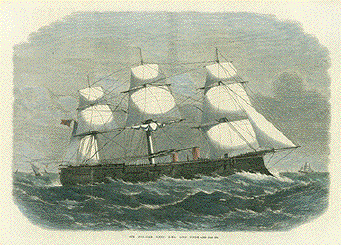
HMS LORD CLYDE, a 36-gun iron-screw ship, was built at Pembroke Dockyard. She was laid down on 29 September 1863, launched on 13 October 1864, and completed on 2 July 1866. The LORD CLYDE, and her sister the LORD WARDEN, were the last Broadside ships to be built for the Royal Navy. She served for 2 years with the Channel Fleet. Her sea-keeping characteristics were found to be very poor, rolling excessively. She was then sent to the Mediterranean and stationed at Malta. However, she had problems with her engines which had worn badly and was sent back to England for an engine refit. In 1869 she was sent into reserve at Devonport. In 1871 she was again sent to Malta where she served for 6 months. She went aground Pantellaria, but was pulled free by LORD WARDEN. She had structural damage and had to be towed back to Malta. Temporarily repaired at Malta she was again sent back to England. It had been planned to give her a major overhaul at Plymouth, but her hull was found to be baldy rotted. They tried to save the ship over a period of 3 years, but at the end she had to be sold for scrap in 1875. |
On 20 April 1867 Charles took command of his own ship, HMS FAWN.
"Fawn, sc., 17, Capt. A. J. Heysham, 1864 [date of rank for Commander], N America and West Indies." - from "The United Service Magazine"I believe Charles is called Captain here as a courtesy -- he was a Commander in command of a ship.
"In 1867, His Majesty's ship FAWN, under the command of Commander Haysham [sic], visited St. Mary's [Newfoundland] from June 7th to 10th." - History of St. Mary's 1597 - 1949 by Michael McCarthy.Charles would have been 32 years old at the time. He woud serve as FAWN's commanding officer until 11 June 1868, when she paid off at Sheerness, ending her North Atlantic tour. The Fawn Shoals, in the Turks Island passage, was named by Charles while in command of the FAWN.
The Royal Navy's main task on the Newfoundland Station [this may better be called the North American Station] was in protecting the coast and the fishing fleet. Other ships and commanders in the area included Captain Parish of HMS Sphinx in 1868, Captain Malcolm of the HMS Danae in 1871 [an ECLIPSE class sloop of 6 guns that operated on the North American and West Indies station], and, in 1874, HMS Spartan [another of the ECLIPSE class]. Other naval J.P.'s included Lieutenant Bellett, R. N., Captain Parish, R. N., Lieutenant Musgrave, R. N., Captain Russell, G. T. Pasley, R. N., and Lieutenant Henry St. Vincent Jenkins, R. N.
| HMS FAWN
The FAWN's design marked the transition from sail to steam power. She had both a steam engine with a single screw and sails. Steam engines were not completely reliable and used large quantities of coal. The sails were used both for conservation and when the engines broke down. Her 360 horse power engine could propel the ship at 9 knots. The technological push of the American Civil War, however, had left her armament far behind by 1867. Her 32-pounders were muzzle loaders that were no match for the 11-inch Dahlgren guns of the U.S. Navy, like those on the only slightly larger American sloop KEARSARGE, that could fire a massive 170-pound shot. She was on the Australian station from 1860 to 1863. The Station encompassed Australia, New Zealand and the Fiji Islands. In 1861 a detachment of her men were used to contain rioting between Chinese and European goldminers in New South Wales. Thomas H. Hood wrote "Notes of a Cruise in H. M. S. 'Fawn' in the Western Pacific in the Year 1862." The Fawn had sailed from Sydney, Australia and visited Niue, Samoa, Tutuila, Pago-Pago, Upolu, Apia, Savail, Uea, Moa, Fiji, Kunaie, Norfolk Island, and Pitcairn Island. The book "provides interesting information on the peoples, geography, conditions, customs, etc. The appendix is on fossils in New Zealand, treatment of females in Niue, cannibalism in Fiji, Tokilau, etc." From 1864 to 1868 the FAWN was apparently operating in the northern Atlantic, on the Newfoundland Station. In an 1867 report from Judge Pinsent of Labrador to the Governor of Newfoundland, he notes that "There was no regular medical man (except the surgeon on HMS Fawn, which vessel came twice to the Labrador for short periods) on the whole coast from the Straits of Belle Isle to Hopedale last summer." |
A Court of Inquiry was ordered by Vice Admiral Sir G. R. Mundy to investigate a death onboard the ship FAVOURITE caused by the gagging of a disruptive sailor. Captain Hamilton of the SPHINX and Captain Heysham of the FAWN made the report that absolved the captain involved.
Charles was "highly commended, on paying off [of the FAWN], by the Admiralty."
In November 1868 Charles was assigned as the Executive Officer, that is the number two officer onboard, to HMS BLACK PRINCE. While this was a come-down from being the commanding officer of his own ship, BLACK PRINCE was one of the fastest, largest and most powerful ships in the world.
"68 BLACK PRINCE, 41.
S.Iron Ship. Armour-plated.
6109 Tons. 1250 H.P.
Coast Guard Service.
Greenock [20 miles west of Glasgow, on the Clyde river]
Captain . . . Alexander C. Gordon 9 Sept 68
Commander . . . Charles A.J. Heysham 27 Nov 68" - from "The Navy List" of 20 December 1868.
| HMS BLACK PRINCE
She was assigned to the Channel Fleet guarding Great Britain and the eastern Atlantic until 1866, then spent a year as flaghsip on the Irish coast. She was overhauled and rearmed in 1867-68 and afterwards became guardship on the Clyde river, at Greenock, left. In mid-1869 she and WARRIOR towed a large floating dry dock to Bermuda. While BLACK PRINCE was later broken up for scrap, WARRIOR is now an historical museum. |
On 20 November 1869 Commander Heysham was again assigned to the Coast Guard as an Inspecting Officer of Divisions, serving at Brighton.
Charles married Ellen Augusta Stirling on 17 [11?] August 1870 in Okehampton, Devon. Ellen was born in 1840 in Dawlish, Devonshire and died after 1881 in Iddlesleigh, North Devon. She was the daughter of Commander Charles Stirling of Buckridge, who was born on 7 June 1793 in Marylebone, London, and Mary Elizabeth Harrison, who was born on 2 July 1833. Commander Stirling was the son of Vice Admiral Charles Stirling. Note that by 1870 both of Ellen's parents had died. Her father in 1868 and her mother in 1863. It is probably not too much to assume there was a naval connection here. I find it odd that Charles and Elizabeth shared a middle name, Augustus and Augusta. I suspect one of them assumed this name later in life in honor of their mate.
Charles probably left the BLACK PRINCE at about this time.
| The Stirling Family
Clan Stirling of Scotland can trace their male descent back over 800 years and "they hasve seen every stone in Glasgow laid except the High Kirk." While we start with Walter Stirling, below, we can trace his fathes back, in reverse order, (16) John, (15) Robert, (14) William, (13) William, (12) William, (11) William, (10) John, (9) John, (8) Alexander, (7) ??, (6) William, and (5) Thoradlus. The Clan Stirling site is at Stirling. (17) Walter Stirling (1567)He was born in 1567 in Glasgow and died in 1656. (18) John Stirling (1613)He was born in 1613 in Glasfow, Scotland and died in 1647. (19) John Stirling (1640)He was born in 1640 in Glasgow, Scotland and died in 1709. (20) Walter Stirling (1686)He was born in 1686 in Sherva, Fife, Scotland and died in 1732. (21) Commodore Sir Walter Stirling (1718)See Biography for the story of his life. (22) Vice Admiral Charles Stirling (1760)See Biography for the story of his life. He appears in the novel "Master and Commander" as Captain of the POMPEE, 74 (as indeed he was), a member of Jack Aubrey's court martial. He suffered a court-martial for misuse of government property while commander-in-chief of the West Indies Station which left him ashore, but with his rank intact. He died in 1833. (23) Commander Charles Stirling (1793)He was born on 4 Jun 1793 in Marylebone, London. He married Mary Elizabeth Harrison on 2 July 1833. She was born in 1815 in Heathbank, Cheadle, Cheshire and died on 10 December 1863 at Buckridge House, Newton Abbot, Devonshire. The Commander died on 20 June 1868, also at Buckridge House. His cousin was Admiral Sir James Stirling, see Biography for the story of James' life. (24) Commander Charles Henry Stirling (1836)He was born on 25 October 1836 at Buckridge. He married Louisa Augustus Tenison Emilie Gray. She was the daughter of the Reverend Henry Gray, vicar of Almondsbury, and Lady Emilie Caroline Pery. Lady Emilie was, in her turn, the daugther of Henry Hartstonge Pery, Lord Glentworth, and Annabella Tenison Edwards, and grand-daughter of Lord Edmund Henry Pery, the 1st Earl of Limerick. Fancy company, this. A Royal Navy officer. He was lost at sea, with his wife and two children, while returning home from the North American Station in the SS CITY OF BOSTON on 29 or 30 January 1870. The ship, having stopped at Halifax after departing from New York for Liverpool, hit an iceberg and sank with 177 lives lost. (24) Ellen Augusta Stirling (1840)She married Charles Augustus John Heysham. I think its interesting that her marriage occurred after the death of her parents and her eldest brother. That being so, where was she living when she met Charles? It must have been with some relations because no "lady" would live on her own. To what extent did her family's naval background influence the marriage? |
Charles probably took his new wife to Newfoundland where he, now a Captain, was a Justice of the Peace for that island in 1871. The Royal Navy had a long tradition of administering justice for this remote region. It is important to remember that the governorship of Newfoundland had been a post in the Royal Navy from 1729 to 1825 and the governor was simultaneously the commander-in-chief of the Newfoundland Station. While the island gained a civil governor after 1825, the naval influence remained strong.
In the 1871 census . . . in Newfoundland?
"Charles Augustus John Heysham" retired as a Captain on 1 October 1873 - from the "Navy List" of 1874. I suspect his wife didn't like the Navy life.
In the 1881 census of Glenburnie, Northam, Devon as Charles A.J. Heysham, of Ropley, Hampshire. He was a Captain, Royal Navy, retired, aged 48. Living with him were his wife, Ellen A., 40, and children, Mary F., 8, Ellen M., 5, Lily B., 3, and Charles F.T., 2. Agnes L. G. Stirling, Ellen's sister, was also living with them. They had six servants.
Charles Augustus J. Heysham died in October-December 1886 in Iddlesleigh, Bideford district, Devon.
4 November 1886. "The Will of Charles Augustus John Heysham late of Bideford in the County of Devon Retired Captain R.N. who died 30 September 1886 at 6 Bridgeland-street in Bideford was proved at Exeter by Arthur Frederick Gresley Stirling of 34 James - street Buckingham Gate in the County of Middlesex Barrister-at-Law the sole Executor." - from the National Probate CalendarIn the spring of 1887 the death of his son, Edmund, was recorded in Wareham, Dorset which presupposes that Charles' widow, Ellen had moved their after his death.
In the 1891 census of Hammersmith, London was Charles' widow, Ellen A. Heysham [Haysham in Ancestry.com], aged 50. She was living with her daughters, Mary F., 18, and Ellen M. Heysham, 15. She was shown as a widow, living on her own means. She kept a single servant. Her son, Charles F.T., was away at school in nearby Surrey.
In the 1901 census of Paddington, London as Ellen Heysham, a 60 year old widow living as a boarder in what appears to be a nursing home. The house was run by Maude R. Forster, a "Sick Nurse," and her "partner" Elizabeth C. Roy. There was also a Dr. Robert B. Ferguson, listed as a visitor.
Ellen Augusta Heysham died in 1902 in Eastbourne, Sussex. Note that only Mary, Ellen (Nellie) and Lily (Lillie) were mentioned as children of Charles and Ellen in "The Blood Royal of Britain."
"Heysham Ellen Augusta of 55 Grand-parade Eastbourne widow died 9 August 1902 Probate London 30 October to Arthur Frederick Gresley Sterling esquire and Basil Wickings Smith solicitor Effects L15497 10s 5d. Resworn January 1903 L18229 2s 10d."That's a considerable estate for the era. I show their children to be,
The son of Charles Augustus John and Ellen Augusta Heysham according to the Parish records, St Peter's Church, Brighton. He was christened on 28 April 1872 in St Peter, Brighton, Sussex, England. The Civil Register shows his birth was registered in June 1872 in Brighton, East Sussex. By 1868 his namesake, his uncle Robert Thornton, had died in Australia. Since Uncle Robert did not have a son to carry on the Robert Thornton-style, the son of Charles got this role.
Young Robert died in September 1872 in Brighton.
(25) Mary Frances Ellen Heysham (1873)She was born in June 1873 in Brighton, Sussex, England. However, I also show that she was baptized on 22 April 1873 at St. Peter's, Brighton. Living with her father at the time of the 1881 census. Living with her mother and sister in London during the census of 1891, aged 18.
In the 1901 census . . .
In the 1911 census of Newton Abbot, Devonshire as Mary Frances Heysham, 38.
There was a medal given to a Mary Francis Heysham in World War I for her war work.
Mary died on 27 April 1944.
"Heysham Mary Frances of Green Shutters, Much Hadham, Hertfordshire, spinster, died 27 April 1944. Probate Llandudno 2 September to Ellen Margaret Sarel widow and Francis Mapleton Iremonger Watts solicitor. Effects L7280 4s. 3." - from the National Probate CalendarEllen Sarel was Mary's sister. (25) Ellen Margaret Heysham (1876)
Known as Nellie, she was born in June 1876 in Winchester, Hampshire, England. She was living with her father at the time of the 1881 census. She was living with her mother and older sister in London at the time of the census of 1891, aged 15.
In 1902 Ellen and sisters Mary and Lilly attended the funeral of their young brother, Charles, who died at the age of 24 after a bout of pneumonia.
"Amongst the mourners were the deceased's three sisters, the Misses Mary, Nellie and Lillie Heysham, Mrs. Barnet (cousin), . . ."I don't know how or to what degree Mrs. Barnet was a cousin, but that becomes important in the next citation because I believe this was Lucy Jane Barnett. This same Lucy adopted Ellen Heysham. Note that Ellen's father had died in 1886 and her mother did so in 1902. This is singular however because Ellen was hardly an orphan in the usual sense; she was 26 years old.
"Will dated [18 December] 1902 of L.J. [Lucy Jane] Barnett, appointing John Croft Deverell esq of Dorking, Surrey, John Richards Croft Deverell esq of 9 New Square, Lincolns Inn and the Revd Henry St John Stirling Woolcombe executors and trustees. LJB devised the Stratton Park estate to the use of Ellen Mary [sic] Heysham for life." - from the UK Archives, Bedfordshire Deeds, Stratton Park Estate, BiggleswadeThis was a will, not a probate. Lucy Barnett was still alive at this point. Stratton Park would go to Ellen only after the death of Mrs. Barnett.
Ellen married William Godfrey Molyneux Sarel on 26 June 1907.
"26 June 1907 EM Heysham was married at Biggleswade parish church to WGMS." - from the UK ArchivesBiggleswade is in Bedfordshire. In another file from the same source it makes clear that WGMS was William Godfrey Molyneux Sarel. He was born on 15 December 1875 in Dover, Kent, the son of Lieutenant General Henry Andrew Sarel, CB. The following are two more citations about this marriage.
"Sarel-Heysham.-On the 28th [sic] inst., at the Parish Church at St. Andrew's Bigggleswade, by the Rev. Sydney L. Sarel, cousin of the bride-groom, assisted by the Vicar of the Parish, the Rev. R. W. Barber, William Godfrey Molyneux Sarel, 1st Battalion Northumberland Fusilers, son of the late Lieutenant-General Sarel, C.B., 9th and 17th Lancers, and of Mrs. Sarel, Heatherhurst Grange, Surrey, to Ellen Margaret, second daughter of Captain C.A.T. [sic] Heysham, R.N., and adopted daughter of Mrs. Barnett, Stratton Park, Bedfordshire." - from "St. George's Gazette" volume 25
"Marriage of Ellen Marg Heysham to William Godfrey Molyneux Sarel. 26 June 1907" - from the National Archives
| The Sarel Family
(23) Rev. Henry Rule Sarel (c1790) Vicar of Balcombe, Sussex. Circa 1867. "The living is a rectory, yearly value £450, with residence and 69 acres of glebe land, in the gift of the Rev. T. J. Torr, and held by the Rev. Henry Rule Sarel, M.A., of Trinity College, Cambridge" - from GenukiHe married Janet Booth on 9 January 1823 at All Saints church, Rushton, Northampton. His children were Henry Andrew (1823), Janet Anne (1825), Laura Booth (1826), Charles Richard (1827), Frederick Rule (1828), and Caroline Matilda (1829)  (24) Lieutenant General Henry Andrew Sarel C.B. (1823)
(24) Lieutenant General Henry Andrew Sarel C.B. (1823)(23) Rev. Henry Rule Sarel (c1790) Lieutenant General, C.B. [Knight Companion of the Bath], B.A. [?], F.R.G.S. [Fellow of the Royal Geographic Society]. He was born on 25 December 1823 in Balcombe, Sussex. He started off in the 9th Lancers in 1847. He fought at Cawnpore and Lucknow during the Sepoy Mutiny in India. He transferred to the 17th Light Dragoons as a Captain in 1858 and fought in the China War of 1860 under Sir Hope Grant. His published the results of his independent exploration of the country as "Notes on the Yang-tze-Kiang, from Han-kow to Ping-shan" in 1861. He commanded the 17th Light Dragoons in 1869. Henry married Margaret Jane Phyllis Molyneux, the daughter of George More Molyneux, Rector of Compton, on 7 February 1867 at Compton Near Guilford, Surrey. The More-Molyneux name dates back to the marriage of Sir Thomas Molyneux and Margaret More of Loseley Park in 1704. Henry left the regiment in 1869 and ended his career as a Lieutenant General in 1883. His home at that time was Rollesby Hall, Norfolk. Assistant Adjutant-General, Dover. In 1883-1885 he was Lieutenant Governor of the island of Guernsey. He died in 1887 at Garnavilla, Cahir, county Tipperary, Ireland. His children were Clement Vincent (1868), Janet Hope (1869), Phyllis (1870), Col. George Benedict, C.S.I., Army Honours for Central Kurdistan and Northern Iraq gazetted 20 January 1921, (1871), Olive (1872), William Godfrey Molyneux (1875), and his twin, Andrew Innes Molyneux (1875). |
William G.M. Sarel was an Army officer and, as a Lieutenant, fought in the Boer War. On 6 September 1900 the London Times reported that,
"The Tagus left Southampton yesterday with drafts numbering 28 offices and 1,301 men. The officers listed were:On 28 August 1902 the London Times reported that,
. . .
Royal West Surrey Regt. - 2nd Lts. Thornton, Bueban, & Sarel"
"The Orotava left for England Aug. 22 with the following on passage home:Clearly Lt W.G.M. Sarel is our man, but was 2nd Lt Sarel? Could he have changed regiments during the war?
. . .
Northumberland Fus. - Lt. W.G.M. Sarel"
| The Boer War
The Boer War, 1899-1902, was a serious jolt for the British Army. At the outbreak of the war British tactics were appropriate for the use of single shot firearms, fired in volleys controlled by company and battalion officers; the troops fighting in close order. These tactics, little changed from the Crimea, used at Modder River, Magersfontein, Colenso and Spion Kop were incapable of winning battles against entrenched troops armed with modern magazine rifles. Eventually, painfully, the British learned, advancing by fire and manouevre, in loose formations, and making use of cover, rather than the formal advance into a storm of Mauser bullets. The Royal West Surrey RegimenttThe regiment fought throughout the war and earned battle honors at the Relief of Ladysmith. The Northumberland Fusiliers
|
| The TAGUS
The OROTAVA
|
Lucy Barnett died in 1908.
"Lucy Jane Barnett died 22 July 1908, will & codicil dated 1902 proved at Principal Registry 20 August 1908, and devised Stratton Park Estate to use of Ellen Margaret Sarel (then Heysham) during her life." - from UK Archives, Bedfordshire Deeds, Stratton Park Estate BiggleswadeThe National Archives contains another version of the above that leaves out the "during her life."
"Will of Lucy Jane Barnett 22 July 1908
Appointed John Croft Deverell, John Richards Croft Deverell and Reverend Henry St John Stirling Woollcombe, executors and trustees devises Stratton Park to Ellen Margaret Heysham (now Sarel). made 18 December 1902
Codicil appoints W M Sarel in place of the Reverend Woollcombe 12 June 1908
Proved Principal Probate Registry 29 Aug 1908."
Stratton Park & the Barnett Family
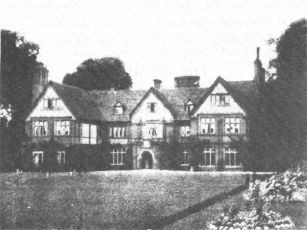
An Elizabethan manor house, Stratton Park was bought from the Cotton family in 1764 by Barnett family. Ownership passed through her son, Squire Charles Barnett, and his son, Captain Charles FitsRoy Barnett, whose wife was Lucy Jane (Gregory) Barnett. Lucy died on 22 July 1908. In 1910 Stratton Park estate with 1070 acres of land was sold by auction and converted into the Parkfield School for Boys. The building was demolished in 1958. |
Ellen Marg Sarel, beneficiary, and H W M (Henry Walter Molyneux) Sarel, trustee, owned the estate and paid principal and interest on a mortgage at least through 13 August 1910. 27 acres of the estate were sold circa 1910.
"Conveyance betweenAlso,
(1) Ellen Margaret Sarel of Primrose Hill, Hawkhurst, Kent, wife of William Godfrey Molyneux Sarel, a Captain in HM Reserve of Officers [vendor]
(2) John Croft Deverell esq of Pixham Firs, Dorking, Surrey, John Richards Croft Deverell, solicitor of 9 New Square, Lincoln's Inn, London and Henry Walter Molyneux Sarel esq of Heatherhurst Grange, Frimley Green, Surrey [Trustees of the will of LJB]
(3) Thomas Bath, farmer of Stratton Park Farm, Biggleswade [purchaser] from (1) to (3), paid via (2) for the purposes of the Settled Land Acts, for £1275, of
(a) 2 enclosures containing 27a 3r 3p in hamlet of Stratton, Biggleswade described in the 1st schedule and delineated on the attached plan and edged with pink [see below for schedules]
Recites at the date of the mortgage, Lucy Jane Barnett, widow of Stratton Park, now deceased, was seized in fee simple of Stratton Park Estate which included among other lands the lands intended to be conveyed
Recites mortgage 1903 between LJB and Louisa Maria Dawkins
Recites death of LMD and admons
Recites transfer of mortgage 1907
Recites will of LJB
Recites 26 June 1907 E M Heysham, spinster, married WGMS
Recites codicil to will of LJB
Recites executors assented to the devise
Recites transfer 1909
Recites reconveyance of 1910
Recites agreement for sale by E M Sarel for £1275
Recites the documents mentioned in the 2nd schedule relate not only to lands intended to be conveyed, but also to lands subject to limitations under the will of LJB which EMS will retain along with the said documents
Proviso restricting covenants by EMS
Acknowledgment by EMS to produce documents of title for TB
1st schedule
1st part: 27a 2r 3p enclosure of arable in hamlet of Stratton, Biggleswade no. 262 on OS plan, bounded N by Biggleswade-Dunton road, occ by TB
2nd part: 14a 0r 3p enclosure of arable in same, no. 26- on OS plan, bounded N by N by Biggleswade-Dunton road, occ by TB 2nd schedule
Recites 18-0 transfer of mortgage between WHW and JCMcG
Recites 1864 marriage settlement [see above]
Recites 1877 mortgage
Recites 1880 receipt
Recites 1883 transfer of mortgage
Recites 1883 mortgage
Recites 1888 transfer of mortgage
Recites 1888 transfer of mortgage
Recites 1890 submortgage between LJB and WHD
Recites 1896, 1897 & 1898 further charges
Recites 1903 conveyance
Recites 1903 transfer of mortgage
Recites 1903 transfer of mortgage
Recites 1903 between Viscount Bridport and LJB
Recites 1903 mortgage
Recites 1907 indenture
Recites 1909 indenture
Recites 1910 reconveyance"
"Reconveyance betweenThere was also a "consideration" of £1,150 made on 5 April 1920.
1) Henry Walter Molyneux Sarel esq of Heatherhurst Grange, Frimley Green, Surrey, Albert Hamilton Godfrey, solicitor of 23 Queen Anne's Gate, London, Rev Henry St John Stirling Wollcombe, Clerk in Holy Orders, c/o Church of England Missionary Society, Deans Yard, Westminster and John Richards Croft Deverell esq of 9 New Square, Lincolns Inn, London - the lenders
2) Ellen Margaret Sarel, wife of William Godfrey Molyneux of Primrose Hill, Hawkhurst, Kent, a capt in HM Reserve of Officers
3) John Croft Deverell esq of Pixham Firs, Dorking, Surrey, JRCD and HWMS, the trustees
(3) pay off the debt from money in their hands being capital money under the Settled Land Acts, at the request of (2) Recites Lucy Jane Barnett died 22 July 1908, will & codicil dated 1902 proved at Principal Registry 20 August 1908, and devised Stratton Park Estate to use of Ellen Margaret Sarel (then Heysham) during her life
Recites £5000 remains due to the lenders"
| Henry Walter Molyneux Sarel (1873)
Of Heatherhurst Grange, Frimley Green, Surrey. Henry Walter Molyneux Sarel used the name Walter Sarel in his professional career as an architect. It's not to believe that he was a son of Henry Andrew Sarel and Margaret Molyneux. |
William went on retired pay and in 1909 was gazetted Captain in the 5th (City of London) Bn., The Rifle Brigade, stationed in the city.
"SAREL, Mrs., of Stratton Park, Bedforshire. Ellen Margaret, 2nd dau. of Capt. Charles Augustus John Heysham, R.N., of Bideford, Devonshire, who d. 1887, by Ellen Augusta, who d. 1902, dau. of the late Charles Stirling. Esq., of Buckeridge, Teignmouih, Devnnshire; m. 1907 William Godfrey Molyneux Sarel, Esq., Lieut. ret., late 5th Northumberland Fusiliers, and Capt. 5th Batt. Rifle Brigade. Mrs. Sarel s. [succeeds?] her cousin, Mrs. Lucy Jane Barnett, widow of Capt Charles Fitz-Roy Barnett, 54th Regt., 1908 - Stratton Park, Biggleswade, Bedfordshire, Primrose Hill, Havihurst, Kent." - from "Walford's County Families of the United Kingdom" of 1912, by Edward WalfordWilliam served in the battalion through the First World War. He then retired as a Major. In 1927 W. Sarel, Esq. was a member of the Noblemen and Gentlemen's Catch Club. Founded in 1761, this was a musical society dedicated to the performance of mass-singing.
William died on 5 April 1950 in Whitechapel, London. He had been a noted cricketeer, playing for Surrey (1904-1909), Trinidad, Kent (1912-1914), Marylebone (1914) and Sussex (1919-1921). For those who want to know, his batting style was 'Right Hand Bat' and bowling style was 'Right Arm Off Break,' whatever that means. He played in 35 "first class" matches. His twin, Andrew Innes Molyneux, was also a noted cricketeer in the West Indies. He, however, died on 2 August 1903 in St. John's, Newfoundland.
I recently received the following email,
"Hi Steve(25) Lilly Barrington Heysham (1878)I came across your site while doing my own research and was very impressed by what you have achieved. Very thorough and readable too!
The Sarels turned up in my own research looking into the history of a house I lived in as a child, now long demolished. Mrs Sarel, the widow of Lt Gen HA Sarel lived at Monks Grove, Chertsey in the 1890's. I am not sure exactly when the tenancy starts, but it would be after the previous tenant, Martha St Aubyn, died in 1893.
In 1896 Henry Walter Molyneux Sarel gives Monks Grove as his address. He appears in the quotes that you give from the archives as the HWM Sarel who later became a trustee of Stratton Park.
Walter Sarel (as he was known) became a well known arts and crafts architect and garden designer, working with Gertrude Jekyll. Do you know what relationship he was to Lt Gen and Mrs Sarel? He's not a son - possibly a nephew? Mrs Sarel was living at Monks Grove in 1898 when her daughter Phyllis Molneux married. However she had gone by 1901, the time of the next census." - Sarah Axon
She was born in March 1878 in Iddlesleigh, Okehampton parish, North Devon. Known as Lillie. Living with her father in 1881 in Iddlesleigh. Note her middle name which is probably in honor of her ancestors amongst the Viscounts Barrington, as well as for her uncle. I do not see her in the 1891 census with her mother and two older sisters.
In the 1901 census of St. Margaret, London, Middlesex as Lillie Barrington Heysham [Keysham in Ancestry.com], 23, a single woman, of Iddlesleigh, Devon. She was living at 66 Victoria street, parenthetically noted as 2 Princess mansions. She was listed as the daughter of the head of the family, but the previous page has that that as Edward George Lovelake. His wife was Kate, of Byfleet, Surrey. This is clearly a different household, numbered 176, while Lillie's was 177. What gives?
| Princess Mansions
Designed by Enoch Bassett Keeling. His style was modern Gothic, often called irredemably weird and grotesque, but today admired for its originality. The building is now demolished. The Royal Meteorological Society had their headquarters there for a time. |
She married Vivian Brudenell Warren, the son of Augustus Edmund Warren and Emily Susannah Smith, on 20 December 1906. "Charles Vivian Warren was born on 28 September 1907. He was the son of Vivian Brudenell Warren and Lillie Barrington Heysham." - from thepeerage.com.
Lillie died on 18 November 1937.
(25) Charles Frederick Thornton Heysham (1878)He was named Charles, for his father; Frederick, for his uncle; and T., probably for Thornton. He was born on 7 March 1879, per his tombstone, in Iddlesleigh, Okehampton, North Devon. He was living with his father in Iddlesleigh at the time of the 1881 census.
In 1891 census as Charles F. T. Heysham, a 12 year old scholar, a boarder living in Waterford Lodge, Richmond, Surrey. William Mathias, a clerk in Holy Orders & Tutor, was the Head. The Reverend William Mathias was, per Charles' obituary, his uncle. Agnes, William's wife, was probabley the sister of Helen Augusta (Stirling) Heysham, Charles' mother. Richmond, while historically part of Surrey, is now part of the London borough of Richmond upon Thames and is a much sought after residential location, and among the most wealthy areas in the United Kingdom. Waterford Lodge was on Queen's Road, which cuts through Richmond Park, the remainder of a royal deer park. The family living next to Reverend Mathias weres the Rixon's, living in Chisholm Lodge. Other documents indicate Chisholm Lodge was located at Richmond Hill, which is at the point where the Queen's Road enters Richmond Park.

Charles may have been attending the Queen's School, at Kew, a Church of England primary school in the London Borough of Richmond, England. Note, however, that this school was at the opposite end of Richmond from where Waterford Lodge was located.
| Queen's School Kew
|
In approximately 1900 Charles went to war.
"After a number of defeats by the Boers in late 1899, the British Government decided that it needed an army that was as light and mobile as the enemy. Enter a new force that was raised for that particular purpose, the Imperial Yeomanry. Each IY unit would comprise 125 men, who had to demonstrate that they were able to shoot and ride. Lord Alwyne Compton, a former officer of the 10th Hussars and a Bedfordshire M.P., agreed to raise a unit. Such was the enthusiasm for adventure and an opportunity to serve the colours, that the unit, to be known as the 28th company, was complete within days of opening the recruiting registers. I have listed below the men who in January 1900 formed 'Compton's Horse', as the first draft of the 28th were known . . .C.F. Heysham was listed as a Private, regimental number: 14928. The British populace, shamed by a series of unexpected defeats at the hands of the Boers in 1899, volunteered for service in great numbers.
Heysham, Charles Frederick (1879-1902)" - from "The Bedfordshire Yeomanry" by David Doorne
| The Boer War (11 October 1899 - 31 May 1902)
The war, caused by British encroachments on two independent Boer states, the Transvall and the Orange Free State, was expected to be a walk-over. However, the under-prepared and over-confident British were surprised by the aggressiveness and tenacity of the Boer fighters and even more so by the modern weapons they possessed (bought from the Germans). In the end is was over-powering numbers, the British fielded a 400,000 man army, that won the day. By the way, Winston Churchill was in the Boer War as a special correspondent. His heroic actions while organizing the defense of an armored train from a Boer attack, his capture and later escape from a prison camp in Pretoria, to eventually rejoining the British forces made him a legend in England. |
See also,
"Two years ago Mr. Heysham, who was only 22 years of age when he died, went out to South Africa with Compton's Horse (the 28th Company of Yeomanry). While out there he contracted enteric, and was invalided home in the spring of last year [1901]." - from his obituaryEnteric refers to enteric fever, or typhoid, an acute, highly infectious disease caused by a bacteria transmitted by contaminated food or water and characterized by high fever, headache, coughing, intestinal hemorrhaging, and rose-colored spots on the skin.
| Lord Compton's Horse
"On 13 December 1899, the decision was made to allow volunteer forces to serve in the Second Boer War. Due to the string of defeats during Black Week in December 1899, the British government realized it was going to need more troops than just the regular army, thus issuing a Royal Warrant on 24 December 1899. This warrant officially created the Imperial Yeomanry . . . The 28th (Bedfordshire) Company of the 4th Battalion, Imperial Yeomanry (also known as Compton's Horse) was raised in 1900." - from Wikipedia The 28th Company Bedfordshire Imperial Yeomanry (Lord Compton's Horse) sailed to South Africa in February 1900. 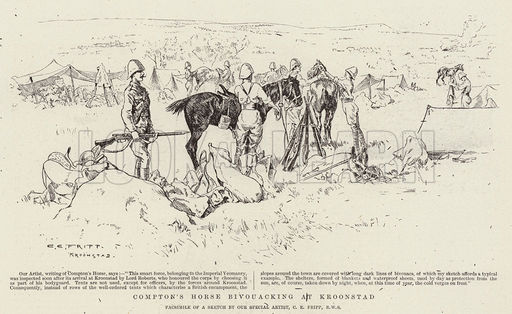
Compton's Horse bivouacking at Kroonstad. Illustration for The Graphic, 14 July 1900. Compton's Horse, named for their commander, Lord Alwyne Compton, M.P., was stationed on outlying farms, around Johannesburg, as piquets where they acted both as police for local issues and as a military patrol against Boer encursions. By September 1901 they were back in England, re-raised as the Bedfordshire Imperial Yeomanry. See also The Bedfordshire Yeomanry. |
Charles Frederick Thornton Heysham received a pension, perhaps as a result of his illness in South Africa - from the "United Kingdom, Chelsea Pensioners' Service Records, 1760-1913."
In the 1901 census of Tixall, St. John the Baptist parish, Staffordshire as Charles Heysham, a 23 year old gentleman jockey/groom, of Iddesleigh, Devon. He was a visitor at Tixall Villa, the home of Minnie Woodland, 25, a married woman. W. Woodland was the trainer of Charles' race horses.
The Uttoxeter racecourse is in Staffordshire, about 12 miles northeast of Tixall. Charles was what is known as a "gentleman jockey," an amateur who rode for the sport of it, as well as an owner and trainer. Note others of the family [William Nunez Heysham, William Sarel] who were "famous" cricketeers during this period. Playing hard at sports was the fashion in Edwardian England. The author Theodore White slammed this behavior as "game madness" in his Arthurian novel "The Once and Future King." It was if all of English society had taken to heart the Duke of Wellington's statement that the battle of Waterloo was won on the playing fields of Eton.
| The Gentleman Jockey
An upwardly mobile middle class aped the manners and interests of the aristocracy with many becoming gentleman jockeys at the end of the 19th century. Amateur jockeys continue to compete as any reader of the novels of Dick Francis can attest. |
In March 1902 Charles died in Reigate, Surrey at the age of 22 [sic]. Reigate is today a "bedroom" community of London, near Gatwick airport. Nearby is the famed Epsom Downs racecourse.
"Funeral of Mr. Charles Heysham, of ChipsteadThe world of sport, and more particularly that branch of sport known as "the turf," has lost, in the death of Mr. "Charlie" Heysham, of Chipstead, one of its all too few true amateurs. Two years ago Mr. Heysham, who was only 22 years of age when he died, went out to South Africa with Compton's Horse (the 28th Company of Yeomanry). While out there he contracted enteric, and was invalided home in the spring of last year. Being intensely fond of horse-racing, and being himself a jocky of no mean ability, he set up as an owner. For some time W. Woodland, a comrade in the same corps at the seat of war, trained his horses at Tixall, in Staffordshire, but about two months ago Mr. Heysham, anxious to be more amongst his horses, left his home at Biggleswade, Beds, and took Hooley Lodge, at Chipstead, where he ran his own stables. He had been especially prominent during the present jumping season, as he owned a number of horses which had been unusually successful in the red and white hoops and black cap. Mr. Heysham's death was painfully unexpected. He was at Plumpton races a little over a week ago, and it was there that he was first taken ill. It seems he had somehow contracted a chill, which turned to pneumonia. He was progressing favourably, when he had a relapse, and died on Monday evening. The event has occasioned sincere regret in sporting circles, in which "Charlie" was a popular figure.
The funeral took place in Chipstead churchyard on Friday afternoon, when the officiating clergy were the Rev. H. St. John Woollcombe, Head of Oxford House, Bethnal Green (cousin of deceased), and the Rev. W. Matthias, of Bath (uncle). The procession from the main road to the church was an impressive and unique sight. The coffin, of unpolished oak, and surmounted by a large brass cross, was borne by the deaceased gentleman's stable lads and Mr. Woodland. The coffin was covered with a silk pall made of deceased's racing colours--red, white, and black--and almost hidden with wreaths. The pall and wreaths were buried with the body. Folllwing the remains of the gallant young sportsman were his two favourite racers--Valhalla and La Bestia--both of whom had carried their owner to victory. Amongst the mourners were the deceased's three sisters, the Misses Mary, Nellie and Lillie Heysham, Mrs. Barnet (cousin), Mr. Everard (cousin), Mr. Stirling, London (cousin), Mr. E. Woodland (Kenley), Mr. P. Woodland, Mr. W.W. and Mrs. Woodland, Mr. Haynes (Stretton Park), the servants from deceased's home at Biggleswade, Miss and Miss Edith St. Quinton, Mr. Westcott (Balsham), and Mr. Dan Albone (representing the inhabitants of Biggleswade). Although Mr. Heysham had been only a short time in Chipstead, he had made himself very popular, and amongst the local people at the funeral were . . . Mr. Heysham was shortly to have been married to Miss May Woodland, who was amongst those present."
- from The Surrey Mirror and County Post of 31 January 1902
Charles F. Thornton Heysham, who was born in March 1879 in Okehampton, Devon, died on 20 January 1902 in Reigate, Surrey and was buried at St. Margaret churchyard, Coulsdon, in the London borough of Croyden, right.
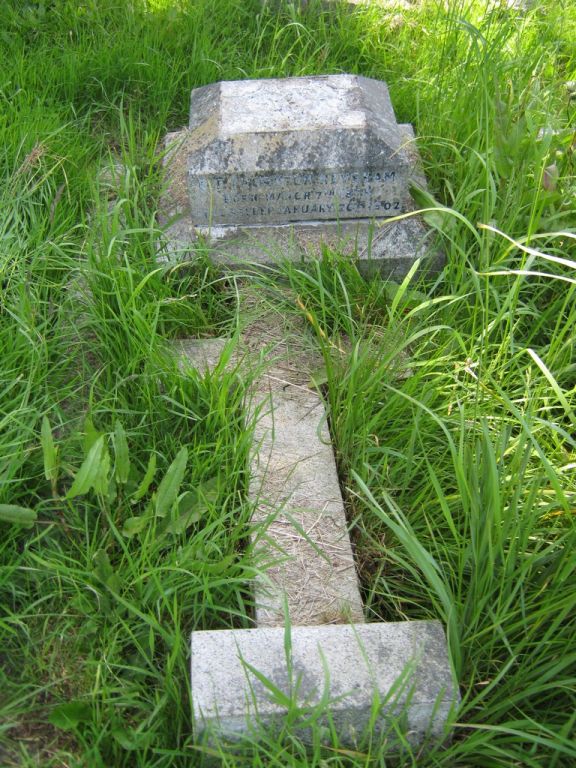
To the left is Charles' tombstone. The inscription reads,
"C. F. Thornton Heysham
Born March 7th 1879
Fell Asleep January 20th 1902"
The administration of Charles' estate:
"Heysham Charles Frederick Thornton of Hooley-lodge Chipstead Surrey esquire died 20 January 1902 Administration London 3 April to Ellen Augusta Heysham widow Effects L2167 0s 6d" - from the National Probate CalendarThe widow, Ellen Augusta Heysham, was Charles' mother. She died in August 1902 and was buried next to Charles with a similiar style tombstone.
Rosa Dorothea Heysham was born in January-March 1881 in Bideford, Devon. Probably the daughter of Charles Augustus John Heysham, who had died in Bideford in 1886. She died in the same period in 1881 in Bideford.
(25) Edmund Thornton Heysham (1882)Edmund Thornton Heysham was born in October-December 1882 in Bideford, Devon. Probably the son of Charles Augustus John Heysham, who had died in Bideford in 1886. Young Edmund died in Wareham, Dorset between April and June 1887, at the age of 4.
(25) Dora Heysham (1884)Dora Heysham was born in April-June 1884 in Bideford, Devon. Probably the daughter of Charles Augustus John Heysham, who had died in Bideford in 1886. Dora died in April-June 1886 in Bideford.
(24) Russell Henry Heysham (1834)He was born on 9 March 1834 and christened on 17 June 1834 in Ropley, Hampshire, per the LDS database, the youngest son of Robert Thornton and Frances Heysham.
In the 1841 census of St. Peter Port, Guernsey, the Channel Islands, as Russell Heissham, 7, of England. He was living with his mother, Francis.
I know little about this fourth son. He emigrated to western Australia where he earned a government job.
"List of All Persons who have obtained Certificates of Qualification for Clerkships and similar Appointments in the various Public Departments from the 21st May 1855 to 31st December 1865.The Convict Service and prison was located at Fremantle, the port city for Perth.
. . .
Heysham, Russell Henry - Colonial Convict Service - Clerk (Western Australia) - 1865, Jan. 21" - from a "Report of Her Majesty's Civil Service Commissioners"
The Convict Service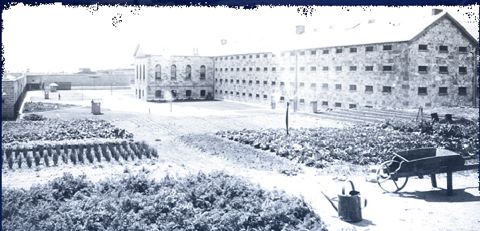
The Swan River Colony, in what is today's Perth, Australia, was established as a "free settlement," unlike the penal colonies on the east coast. By the 1840s, however, demand for cheap labour overcame an early reluctance and the colony agreed to accept some convicts from Britain. The arrival of the first convict ship SCINDIAN on 2 June 1850 was unexpected as a sailing ship that had been sent ahead had been blown off-course. The colony's Round House jail was full, so the 75 convicts had to be left on the ship until a temporary prison was built. A permanent prison, known as the Convict Establishment or just the Establishment, was build by convict labor between 1851 and 1859. The prison was administered by a comptroller general, sheriff, or director, responsible for the entire convict or prison system in Western Australia. By 1868 penal transport to Western Australia ceased - from Wikipedia. |
At some point, probably around the time penal transport to Western Australia ended in 1868, Russell moved to Adelaide, in eastern Australia.
Heysham, R.H. Adelaide - from "The South Australian Government Gazette" of 3 June 1869Russell died on 15 April 1869 in Adelaide, at the age of 35. His estate was subject to several legal notices: "Russell Henry Heysham, late of Swan River, in the Colony of Western Australia, and since of Adelaide . . ." - from "South Australia Government Gazettes."
There was a Charles Heysham in the Electoral Rolls of 1936 in Northam, Swan, Western Australia. A descendant?
(24) Maria Jane Bowes Heysham (1836)She was born in 1836 in St Peter Port, Guernsey. Her name commemorates her grandmother, Lady Maria Jane Bowes-Lyon.
In the 1841 census of St. Peter Port, Guernsey, the Channel Islands, as Maria Heissham, 5, of Guernsey. She was living with her mother, Francis.
In the 1851 census of Stoke Damerel, Devonshire as Maria J. B. Heysham, 15, of St. Peter, Isle of Guernsey. She was living at home with her widowed mother in Devonport.
In the 1861 census of West Teignmouth, Devonshire as Maria Heysham [Harpham in Ancestry.com], 25, unmarried, of Guernsey. She was living at home with her widowed mother, Frances.
In the 1871 census . . . Maria's mother, Frances, died in the beginning of 1871, in Newton Abbot, Devon.
In the 1881 census of West Teignmouth, Devon as Maria Heysham, a 45 year old unmarried woman born in Guernsey. She was living alone, with a cook and housemaid, living off her "dividends," residing at 17 Gloucester road. This is clearly 'our' Maria.
Maria Jane B. Heysham married Captain Francis Paul in September 1882 at Newton Abbot, Devon. She was 46 years old. Maria's older brother, Charles Augustus John, was a Captain in the Royal Navy. Is this another case of a brother introducing his sister to a shipmate?
"NOTICE is hereby given, that all creditors and other persons having any claims or demands against the estate of Francis Paul, late of 14, The Terrace, St. Heliers, in the Island of Jersey, a Captain (retired) in His Majesty's Indian Army, deceased (who died on the 2nd December, 1916. and whose will was proved in the Principal Probate Registry, on the 24th January, 1917, by Edward John Francis Tozer and Alfred Percival Dell, the executors therein named), are hereby required to send the particulars, in writing, of their claims or demands to us, the undersigned, Solicitors for the said . . ." - from "The London Gazette" of 1917Captain Paul and Maria d.s.p. St. Heliers, Jersey, pictured below.
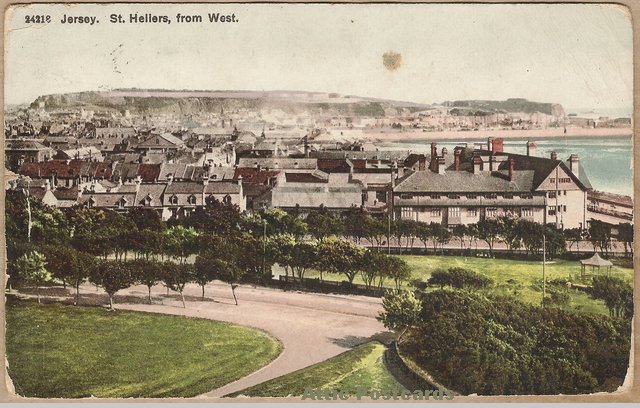
In the 1841 census of St. Peter Port, Guernsey, the Channel Islands, as Rosa Heissham, 4, of Guernsey. She was living with her mother, Francis. I know nothing more of her.
(23) Charlotte Augusta Heysham (1796) She was christened on 15 June 1796 in Saint Pauls Walden, Hertford, England. In the 1841 census of St. Mary, Marylebone, Middlesex as Charlotte Heysham, 34. She was a single woman, living at home with her parents. She was mentioned in her father's will of 1849, still living at home. I don't see her in the census of 1851. She had died by the time her father's will was probated in 1857 [or 1851].
She was christened on 15 June 1796 in Saint Pauls Walden, Hertford, England. In the 1841 census of St. Mary, Marylebone, Middlesex as Charlotte Heysham, 34. She was a single woman, living at home with her parents. She was mentioned in her father's will of 1849, still living at home. I don't see her in the census of 1851. She had died by the time her father's will was probated in 1857 [or 1851].
L "Heysham Charlotte Augusta. 24 February. Letters of Administration of the Personal estate and effects of Charlotte Augusta Heysham late of 2 Medina-road West Cowes in the Isle of Wight in the County of Southampton Spinster deceased who died 29 January 1856 at Medina-road aforesaid were granted at the Principal Registry to Frederick Heysham of the City of Winchester Esquire the Brother and one of the Next of Kin of the said Deceased he having been first sworn."She was 60 years old. West Cowes, on the north shore of the Isle of Wight, is normally called just Cowes, while the village on the other side of the Medina river is called East Cowes. (23) John-William Henry Heysham
Second son of Robert Thornton Heysham. Probably a confusion with William-Henry, below. Interestingly, however, I have a quote from a book I haven't been able to otherwise access on Google Books which says,
". . . now at Yale, to "Charlotte Augusta Heysham / The gift of her brother Fredrick". Fredrick Thornton Heysham was the fourth son, and Charlotte Augusta the . . ." - from "Studia Neophilogica" by Bengt. Hesselrot and Robert Eugen Zachrisson.The only way Frederick could be the fourth son would be to have some son in John's place. In another reference, the "Rugby School Register," Frederick was referred to as the third son. Had John died before Frederick graduated, therefore being ignored in later comments? (23) William Henry Heysham (1797)
The son of Robert Thornton Heysham, Esq, and Sarah, his wife, of Hinton-house. He was born on 31 December 1797 and baptized on 17 February 1798 at Stagenhoe Mansion House in St Paul's Walden, Hertford. Of St. George's Bloomsbury, Middlesex, gentleman.
Did William go to school to earn a degree?
On 19 January 1815 William Henry was apprenticed as a clerk for five years to George Bedford of Bedford Row, Middlesex, one of the attornies of the Court of Kings Bench, in the practice and profession of a solicitor and attorney, in an agreement with his father, Robert Thornton Heysham of Hinton House.
He married Esther Nunez, of Warnford, the daughter of Aaron-Fernandez Nunez, Esq., & Rachael, his wife, of Belmont Park, Hants. She had been baptized (she had been Jewish) at Kintbury, on 30 December 1805. They were wedded on 27 December 1822 at Warnford. Robert-Thornton Heysham, of Hinton House, Southampton, gent., bondsman. This latter was probably (22) Robert Thornton Heysham (1769), his father, rather than (23) Robert Thornton Heysham (1795), his older brother. This marriage would have been a good one, Esther's father was very wealthy.
| Aaron Fernandez Nunez
Of Old Alresford, Portugal. He was a refugee, via Brussels, from the Napoleonic Wars. He was present at the famous Brussels ball the night before the battle of Waterloo when the Duke of Wellington received news of Napoleon's advance. I believe this is Aaron Fernandez Nunez-Cardozo (1762-1834). Cardozo would be his mother's maiden name. A wealthy English merchant who settled in Gibraltar soon after the restriction on Jews was lifed. He was a leader of the Jewish community and simultaneously served as a consul to the beys of Tunis and Algiers. He uncovered a French conspiracy to betray the fortress of Gibraltar and was publicly recognized. During the Napoleonic Wars he was an intermediary with North African rulers, insuring that Gibraltar continued to receive food and water. His mansion became the city hall. Said to be buried in Winchester Cathedral. The family's descent, Joseph Fernandez Nunez [Nunes] (-a. 1788) of Amsterdam. His son was,- Aaron Fernandez Nunez ( -1920), of Amesterdam, Old Alresford, and Belmont Park, Southampton. His wife was Rachel de Castro ( - 1843). His daughters were, -- Harriet Nunez (1793- ), married the Reverend Charles Lyne (1802-1873) in 1829, he was the Rector of Tywardreath and Roche, Prebendary of Exeter, and J.P. for Cornwall -- Esther Nunez ( -1859), married William Henry Heysham (1797-1852) in 1822 -- Rebecca Nunez ( -1859) married Roger Robert Tichborne (1792-1849), 4th son of a baronet, in 1822 -- Louisa Nunez married LT George Colin Oliver, RN. He joined the Hampshire Hunt in 1829 -- Emma Nunez marred Andrew Crawford, MD, of Winchester From both this comment and his wife's baptism, I assume the Nunez' gave up their Jewish faith to fit into British society. |
William Henry's apprenticeship with George Bedford had ended in 1821, but he continued to serve with the old gentleman for three more years before deciding that the law was not for him.
"August 21.Since this dissolution came just two years after his very advantageous marriage, perhaps William was leaving the law because he didn't need to practice.
Partnerships Dissolved,
In and Near London.
. . .
Bedford, George, and William Henry Heysham, of Bedford-row, Middlesex, attorneys and solicitors . . . 19 Aug." - from "The Law Advertiser for the Year 1824"
Just before this time there was a match race for "50gs." set at the Woolwich Garrison Meeting of 25 June 1823 between Captain Price's horse, Waxy, and that of "Mr. Heysham's Lazarus," who came in second. "The winner won with considerable difficulty by half a length." - from the Sporting Magazine. I put this here based on William's racing, noted below.
William leased a home in Hampshire.
"1837. Mr. Wm. H. Heysham, Ropley Cottage" - from "Sporting Reminiscences in Hampshire" by Aesop
| Ropley Cottage
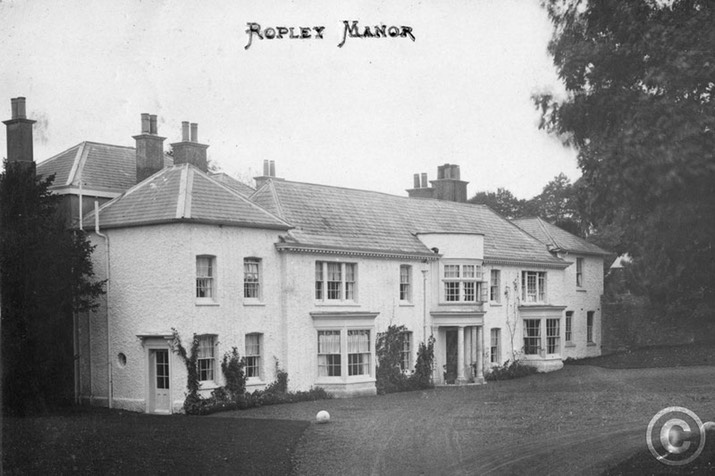 Ropley Manor c1920 |
In the 1841 census of Martyr Worthy, Hampshire as William Heysham, 40 or 46 or 48 [its not clear], a man of independent means. Living with him was his wife, Esther, 50. There were no children living with them, though William Nunez should have been 12, and Henry, 9. Perhaps they were off at school? There were five servants.
At about this time, circa 1841, Mr. William Heysham arranged a match race at Soverton Races with a "Fatty" Morant. It was noted that they both weighed 24 stone, "but illness on the part of the latter [Heysham] prevented its coming off." - from Bailys Magazine. 24 stone is 336 pounds [egad!].
In the 1851 census of Ropley, Hampshire as William Henry Hysham, a 52 year old annuitant, of St. Pauls Walden, residing on South street. Living with him were his wife, Esther, 60, of Amsterdam, and children, William Nunez, 22, an under graduate at Trinity College Oxford, of Farringdon, Hampshire, and Henry Nunez, 19, of Itchen Abbas, and William's brother, Frederick, 50, a man with no profession, of St. Pauls Walden. William also had four servants living in the house.
William was not mentioned in his father's will of 1849, though Frederick, who was living, and Robert Thornton, who was not, were. There isn't much question that William was the son of Robert Thornton Heysham, so why the oversight? Was there some bad blood about William's marriage into the Nunez family? Or was the Nunez marriage so advantageous that William's father figured he was already cared for?
William Henry Heysham died on 15 August 1852.
"At Ropley-cottage, Hants, aged 54, William Henry Heysham, esq." - from "The Gentleman's Magazine and Historical Review"Esther died in July-September 1859 at South Stoneham, Hampshire.
1 November 1859. "The Will with a Codicil of Esther Heysham late of Southbrook House Hill in the County of Southampton Widow deceased who died 15 August 1859 at Southbrook House Hill aforesaid was proved at the Principal Registry by the oaths of Mark Dewsnap of Lincoln's-inn-fields in the County of Middlesex Barrister-at-Law and Frederick Heysham of Southampton in the said county of Southampton Esquire the Executors." - from "National Probate Calendar."
Their children were,
(24) William Nunez Heysham (1826)
(24) Henry Nunez Heysham (1832)
The eldest son of William Henry Heysham, esq. and Esther Nunez, of Ropley, Alresford, Hants. He was born on 19 July 1826 in Marylebone, London. The year was 1828 per a Cricket Information web page, which may relate to the fact that William, under the name William . . .Ny Heysham, was not baptized until 23 July 1828, at Farringdon, Southhampton. Marylebone is in the West End, close to Regent's Park. Alternately he was born in Farrington, Hampshire per later census returns. These were probably his two homes while growing up, in-town and in the country.
According to a court case [the Tichborne case] in which he took part as a witness, William was educated in the village of Tichborne, "I was a pupil of the Reverend Alfred Bishop, who was then curate of Tichborne before I went to Oxford." Alfred Bishop was Catholic. Note that William's brother, Henry, was also Catholic, though I had assumed he converted on marrying his Irish-French wife.
The following reference of 1844 gives two addresses for William. One must be where he lived, that is his parent's house, and the other where he worked, perhaps as a law clerk previous to his matriculation from Oxford.
"Heysham William N. 13 King's bench walk, Temple EC13 King's Bench Walk is today the home to "an established set of chambers with some 55 members practising from premises in the Inner Temple of London . . ."
Heysham William Nunez, 26 Westbourne park road, Bayswater W"
- from the "Royal Blue Book" of 1844
William was sent to Trinity College, Oxford, pictured below.
"Heysham, William Nunez, 1s. William Henry, of Farringdon, Hants, arm. Trinity Coll., matric. 1 Dec. 1847, aged 19; B.A. 1851, M.A. 1854, bar.-at-law, Inner Temple, 1853." - from "Alumni Oxonienses: the Members of the University of Oxford, 1715-1886"
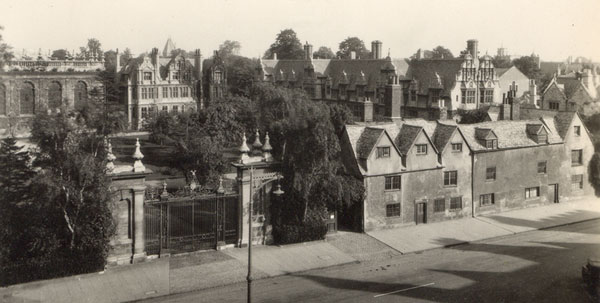
In the 1851 census of Ropley, Hampshire as William Nunez Hysham, 22, an under graduate at Trinity College Oxford, of Farringdon, Hampshire. He was living at home with his parents at the time. He received his M.A. and on 7 May 1850, then aged 21, he entered the Inner Temple as a student of law. He was called the bar in 1853. He later road the western circuit.
An amateur sports writer. His biography is contained in "British and American Sporting Authors: Their Writings and Biographies" by A. Henry Higginson. London: Hutchinson & Co., 1951. A noted cricket player, he played for the Surrey Cricket Club. His scores from the nineteenth century are on the English Cricket league web site - everything gets on the web!
Author of a memoir of the hunt scene, "Sporting Reminiscences of Hampshire from 1745 to 1862," London: Chapman & Hall, 1864. Published under the pseudonym "Aesop." There is a copy for sale on the internet that is interesting in that a lengthy contemporary obituary of W. Nunez Heysham is pasted on the title page verso and dated "Dec 16th 1905. Hampshire Chronicle." The author was for many years a correspondent for the Hampshire Chronicle, with his 'bachelor' headquarters at The Norfolk Hotel, Brighton. I assume the latter means he was married, but that he left his wife at home when he went on the road.
The following may fit here, but because I only have a snippet I cannot be sure. This could also refer to Frederick Heysham, who was a great sportsman.
". . . Lord Exeter's Ilex, Lord Exeter's Lens, Mr. Haysham's Domino, Mr. Hughes' Sophistry, Major Martyn's Lady Isabel, Lord Palmerston's Buckthorn, Mr. Payne's Glenluce, and Mr. Whieldon's Benta. 6 to 5 on Hobbie Noble, who won by a length." - from the "Sporting Magazine"Clearly a horse race. Was this an amateur or professional event? Lord Exeter was perhaps Brownlow Cecil, 2nd Marquess of Exeter (1795-1867), who had a stud farm at Burleigh. Lord Palmerston was Henry John Temple, Viscount Palmerston (1784-1865), Secretary of State for Foreign Affairs. After Lord Melbourne was replaced as Prime Ministter by Sir Robert Peel in 1841 he spent much of his time on the "favourite occupations of riding, hunting and racing." His horse Buckthorn was born in 1849. Hobbie Noble was born the same year [isn't it amazing what you can find on the internet?]. Horses normally race from about the age of 3 to 11, or so, so the date of this event was somewhere between 1852 and 1860.
William married Charlotte Bath. She was baptized on 28 March 1830, perhaps the daughter of James and Anne Bath. From all indications this was a poor match for William, the Bath's being from quite a low station in life. Charlotte's sister, Emma Jane Bath, was apparently a servant in William's Marylebone home. - all per Maxie. Perhaps this was a love match or the result of a tryst between master and servant.
At about this time William joined the Alpine club, who were genteel moutaineers.
"William Nunez Heysham (27 Nov. 1858, resigned 1859 or 60) Born 19 July 1828. Son of William Henry Heysham of Ropley, Alresford, Hants. Married. Educated Trinity College, Oxford. BA 1851. Barrister (Inner Temple), 1853. Western Circuit. Author of 'Reminiscences of Hampshire'. Died 12 Dec. . ." - from the "Alpine Club Register" by Arnold Louis Mumm"The Alpine Club, the world's first mountaineering club, is Britain's only national club for Alpinists. Since it was founded in 1857 its members have been at the leading edge of worldwide mountaineering development and exploration. We aim to be the club of choice for all mountaineers, providing a forum for sharing experiences and information." - from the club's website. Wikipedia notes that "For many years it had the characteristics of a London-based Gentlemen's club, including a certain imprecision in the qualification for membership (said to have been 'A reasonable number of respectable peaks')."
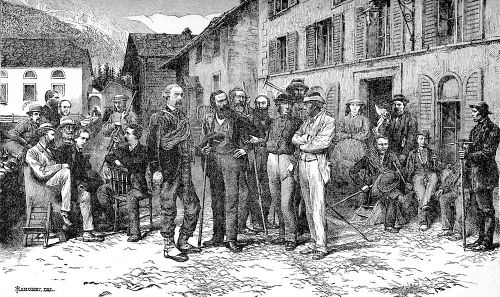
In the 1861 census of Paddington, Middlesex as William Heysham, a 32 year old gentleman residing at Number 12, Cumberland Terrace. His occupation was listed as "Independent." He was born in Farrington, Hertfordshire. Living with him was his wife, Charlotte, 28, of Andover, Hants.
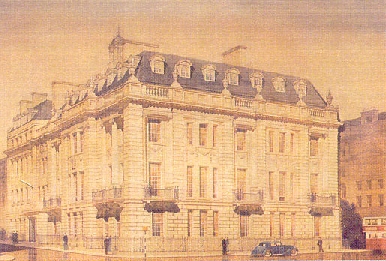 William was a member of the United University Club, left, which was located at 1 Suffolk street, Pall Mall, London. It was founded in 1821 and restricted to 1000 members, 500 each from Cambridge and Oxford. Lord Palmerston was a founding member. From a list of members: "1863. Heysham, William N., M.A., Trinity, Oxford." - from "Rules and Regulations of the United University Club" 1865. The Prince of Wales was the senior member. Eight years after its founding, the waiting list having become inconveniently long, the Oxford and Cambridge club was founded. A writer notes:
William was a member of the United University Club, left, which was located at 1 Suffolk street, Pall Mall, London. It was founded in 1821 and restricted to 1000 members, 500 each from Cambridge and Oxford. Lord Palmerston was a founding member. From a list of members: "1863. Heysham, William N., M.A., Trinity, Oxford." - from "Rules and Regulations of the United University Club" 1865. The Prince of Wales was the senior member. Eight years after its founding, the waiting list having become inconveniently long, the Oxford and Cambridge club was founded. A writer notes:
"Club-land was a comparatively small country, peopled by a most exclusive race. There were twenty-five clubs in all, and, as many men had more than one club, and the average membership was less than a thousand, there were not more than 20,000 men altogether who belonged to clubs . . . Speaking generally, no City men at all, nor any who were connected in any way with trade, were admitted into the clubs of London. A barrister, a physician, or a clergyman might be elected, and of course, all men in the Services; but a merchant, an attorney, a surgeon, an architect, might knock in vain . . . Thackeray describes the dullness of the club, the pride of belonging to it, the necessity of having at least one good club, the habitues of the cardroom, the talk, and the scandal." - from "Fifty Years Ago" by Walter BesantThe old clubs included the Alfred and Clarence, which were literary clubs, the Athenaeum, the Garrick, which was theatrical in orientation, the Oriental, which was famous for curry and Madeira, the Union, which had some City men, the United University, which was famous for its iced punch, the Windham, which actually allowed strangers to dine within its walls, and the Oxford and Cambridge.
In the 1871 census of Christchurch, St Marylebone, London as William Heysham, a 43 year old barrister-at-law. He was residing at Number 6 Alpha road [N.W.]. He had been born in Farrington, Hampshire, England. Hampshire is where (22) Robert Thornton Heysham moved after selling Stagenhoe, in Hertfordshire and where Robert's son, Barrington, was born. Living with him was his wife, Charlotte, 40. She was born in Andover, Hampshire, England. They had no children.
William Nunez Heysham, related through his aunt to the Tichborne family, was a witness in the famous Tichborne case.
| The Tichbourne Case, or the Heir who Disappeared
Sir Roger Charles Doughty Tichborne was born January 5 1829, in Paris as the eldest son of a baronet and heir to the Roman Catholic Hampshire family of Tichborne. King James I of England had made his ancestor Sir Benjamin Tichborne, sheriff of Southampton, a baronet in 1621. His father was James Francis Doughty-Tichborne and his mother French-born lady Henriette Felicite. Through the influence of his mother, who did not appreciate England very much, Sir Roger mainly spoke French. In fact, he lived with his mother in France until the age of 16. James Tichborne had to claim that the boy was going to a funeral in England before his mother would let him leave. In 1849 he went to Stonyhurst College and later that year joined the 6th Dragoon Guards in Dublin. Apparently his French accent caused ridicule, and he sold his commission in 1852. Next year he left for South America. From Valparaiso he crossed the Andes and arrived in Rio de Janeiro in 1854. In April, on his way back home, his ship was lost at sea with all hands, and he was pronounced dead the next year. The title and the estates passed to his younger brother Sir Alfred Joseph Doughty-Tichborne (who died 1866). On learning the news of her eldest son's death, Sir Roger's mother refused to admit that he was dead. She sent inquiries all over the world, and in November 1865, she received a letter from a Sydney lawyer who claimed that a man supposedly fitting the description of her son was living as a butcher in Wagga Wagga, Australia. The supposed Sir Roger was actually Arthur Orton, who at the time used the name Tom Castro. Aside from some facial resemblance to Tichborne, he did not fit the description at all. Instead of sharp features and black hair, he had round features and light brown hair. He was also overweight and did not speak a word of French. His first letter referred to facts Lady Tichborne did not recognise. However, Lady Tichborne was desperate enough to accept him as her son and sent him money to come to her. Orton was reluctant to go at first, presumably because he feared exposure, but his associates-one of whom was an old friend of Sir Roger's father-made him change his mind. Sir Roger's former servant Andrew Bogle accompanied him on his trip to Britain. He arrived in London on Christmas Day 1866 and visited the Tichborne estates. There he met the Tichborne family solicitor Edward Hopkins and Francis J. Baigent who became his supporters. When in January he travelled to the Paris hotel where Lady Tichborne was living, the desperate lady "recognised" him instantly as her son. She even handed him Sir Roger's letters from South America. The fact that Orton did not understand a word of French did not bother her, and she gave him an allowance of £1,000 a year. Orton researched Sir Roger's life to enforce his imposture. After Lady Tichborne's acceptance, various other acquaintances of Sir Roger accepted him as well. They included other officers of the 6th Dragoons, several county families and Hampshire villagers. He even hired a group of manservants who had served in the 6th Dragoons. Other members of the Tichborne family were not so gullible and promptly declared him an impostor. Their investigators found out that this Tom Castro was a butcher's son from Wapping and had jumped ship in Valparaiso, Chile, where he had taken the name Castro from a friendly family. Orton had even inquired about his family members in Wapping when he had come back from Australia. They also found many other discrepancies when Orton tried to fit his own South American experiences to those of Sir Roger. When Lady Tichborne died in March 1868, Orton lost his most prominent supporter. He would have probably stopped the charade had he not owed a significant amount of money to his creditors. (He sold "Tichborne Bonds" to pay the legal costs when he tried to claim his inheritance from the Tichborne family.) The rightful heir at the time, Sir Henry Alfred Joseph Doughty-Tichborne, was only two years old. The trial to establish his inheritance began on 11 May 1871 in the Court of Common Pleas before Sir Alexander Cockburn, 12th Baronet CJ, and lasted 102 days. Orton weathered the attacks against the discrepancies in his story and his outright ignorance of many key facts Sir Roger would have known, including how to speak French as the heir had spent most of his youth in France. Over 100 people vouched for his identity as Sir Roger-except Orton's brother who claimed otherwise. Eventually Sir John Coleridge (whose junior was Charles Bowen) revealed the whole case in a cross-examination that lasted 22 days, and the evidence of the Tichborne family eventually convinced the jury. The case was closed on 5 March 1872, when Orton's counsel William Ballantine gave up after witnesses described tattoos which Sir Roger had had but Orton did not, and Orton lost his upper-class supporters. Orton was convicted on two counts of perjury on 28 February 1874, and was sentenced to 14 years' hard labour. The legal costs amounted to £200,000 (at least ten million pounds sterling or twenty million US dollars adjusted currency) Orton served ten years in prison and was released in 1884, by which time the public had forgotten him. He alternately confessed and claimed he was innocent but aroused little interest. He died in poverty on 2 April 1898. His coffin still carries the name Sir Roger Charles Doughty Tichborne." - from Wikipedia |
William Nunez Heysham's evidence in the case was his remembrance that the rightful Tichborne, probably due to his French upbringing, was unable to pronounce the "th" sound.
"Mr. William Nunez Heysham, sworn.Note the "dropped H" spelling of Asham, above.
Examined by Mr. Serjeant Parry.Are you a barrister by profession?--I was called to the Bar in 1853, and went the Western circuit in 1859.
And you have left the Bar now, and where you do reside?--London during the summer, and Rugby during the winter, and traveling about.
Are you by marriage connected with the Tichborne family at all?--I am. Mr. Robert Tichborne married my mother's sister--my aunt, Miss Nunez.
The uncle of Roger?--The uncle of Roger.
From 1845 to 1849 did you reside in Ropley?--My father did.
Did you?--No--partly; I lived in the village of Tichborne.
How far is Ropley from Tichborne?--Well, you can ride it in about three miles.
Where did you reside in those years?--From 1844 to 1847 I lived in the village of Tichborne itself, as I was a pupil of the Reverend Alfred Bishop, who was then curate of Tichborne before I went to Oxford.
. . .Have you a brother resident in Paris?--He has been. I had a brother resident in Paris, in the Place de la Madeleine . . . He was there in 1867. I was living in Winchester then.
. . .You never had your name spelt Asham before?--Not by anybody who ever knew me. I might have had a parcel directed by a shopkeeper so."
- from "The Trial at Bar of Sir Roger C.D. Tichborne"
| The Tichborne Family
Sir Henry Tichborne (1756), 7th baronet of Tichborne, married Elizabeth, daughter of Edmund Powden, esq. Their children were, - Sir Henry Joseph Tichborne (1779), 8th baronet of Tichborne, married Anne, daughter of Sir Thomas Burke, baronet. He had no male heirs - Sir Edward Tichborne (1782), who assumed the surname Doughty upon inheriting the estates of Mrs. Doughty of Richmond, Surrey. He married Catherine, daughter of James Everard, 9th Baron Arundel of Wardour. Succeeded his brother as 9th baronet of Tichborne. He had no male heirs. - Sir James-Francis Doughty Tichborne (1784), 10th baronet of Tichborne, married Harriette-Felicite, daughter of Henry Seymour, esq., M.P. -- Sir Roger Charles Doughty Tichborne (1829), see below -- Sir Alfred Joseph Doughty-Tichborne, 11th baronet of Tichborne - Roger Robert Tichborne married Rebecca, daughter of A.F. Nunez, esq, of Belmont Park. Brother-in-law to the Heyshsams. Robert Tichborne was mentioned in the hunt news along with R.T., William Henry, Robert Jr., and Frederick Heysham. - Lucy-Mary Tichborne, married George Nangle, esq. |
An inveterate sportsman, the following lists five fox hunts from the 1877-8 season taken from the columns of the "Daily Telegraph" and "Bell's Life in London."
With The Pythchley. "Whilst the hounds were drawing the cover--which they did carefully, only finding a vixen, which, of course, was not followed--I had time to look over the field. Amongst the number who hailed from all quartes I found . . . Mr. Heysham, who managed to find time to canvas--successfully, too--for the "Hunt Servants' Benefit Society," adding thereby the names of several ladies to the already long, but no long enough, list of subscribers to this admirable institution . . ."
With the Warwickshire. "On the Thursday the Warwickshire Hounds met at Shuckberg . . . Amongst those present . . . Mr. Heysham . . . "
A Good Time as Rugby. "On looking over the list I found the names of . . . and Mr. Heysham, whose name is a pass-word to every hunt in the kingdom, by reason of his disinterested extertions on behalf of that admirable institution--which I especially commend to the notice of the sportswomen of the day--the Hunt Servants' Benefit Society. [Late identified as W. N. Heysham]"
The North Warwickshire. "Amongst those present . . . Mr. Heysham . . . Had it not been for the gloominess of the day, this would have been a most enjoyable run . . . but whither we ran it is impossible for me to say, as the atmosphere was denser than ever. I therefore pulled up, and, falling in with Mr. Fitt, who is so well known to all hunting in these parts, and Mr. Heysham, who appeared to know every stone in the road, I was enabled to find my way back to Rugby."
A Merry Time in the Midlands. ". . . a host of well known riders . . . with a large party hailing from the George [a hotel], consisting of the well-known and widely-esteemed Mr. W. N. Heysham . . ." - from "Tallyho, Sketches of Hunting, Coaching, etc." by Fred Field Whitehurst.
| Hunt Servants' Benefit Society
Hunt Servants' Benefit Society was established in 1872. It provides support to huntsmen in th event of illness or injury, or to their survivors in case of death. There is today a personal pension scheme for Hunt staff. The present Patron and Governor is The Prince of Wales. The name was changed to Hunt Staff Benefit Society on 1 January 2004. |
In the 1881 census I have a W.N. Heysham, a 52 year old barrister, who had been born in Faringdon [sic], Hampshire, England. He was living at 6 Alpha road. His wife was Charlotte, 50. They had no children living with them.
March 1889. ". . . and drove in a hansom to 4 Albert Street, to visit Mr. Heysham (honorary treasurer of the Hunt Benefit Soceity). A very nice old man, but suffers terribly from gout. He fed us sumptously on tea, cold chicken and tongue." - from "Eighty Years' Reminiscences" by Colonel John Anstruther-Thomson, 1904.
In the 1891 census of Brighton, Sussex as William N. Heysham [Herpham in Ancestry.com], a 62 year old barrister at law, of Farington. Oddly he was shown as single. He was staying at the New Ship hotel, on Ship street. On separate vacations I suppose, Charlotte Heysham [Heystam in Ancestry.com] was at home at 6 Alpha Street, in Marylebone, a 60 year old living on her own means, of Verham, Hants. This was probably the village of Vernham Dean, in Hampshire.
16-17 January 1896, "W. N. Heysham" was listed as a Commissioner for the Division of Godalming - from "Tax Cases Reported Under the Direction of the Board of Inland Revenue" of 1899.
In the 1901 census of Paddington, London as William Heysham [Hyesham in Ancestry.com], a 72 year old living on his own means, of Farringdon. Living with him were his wife, Charlotte, 70, of Vernham.
William died on 12 December 1905 in Paddington, London [this is near the West End], of Farringdon. Other addresses given for William are 7, Crown Office Row, Temple, E.C. [an office address, this was just off Middle Temple Lane, between Fleet Street and the Thames Embankment], and 4, Albert Street, Rugby. - from "Men-at-the-bar: a biographical hand-list of the members of the various Inns of court, including..." by Joseph Foster.
"Heysham William Nunez of 26 Westbourne Park-road Middlesex died 12 December 1905 Probate London 25 January to Charles Russell barrister-at-law and George Brodie and John Warren Davis esquires Effects L24117 8s. 3d." - from the National Probate CalendarThat's a considerable estate for the era. William's wife, Charlotte, died on 2 May 1907, leaving an estate of L1377.
"Heysham Charlotte of 26 Westbourne Park-road Middlesex spinster [?] died 4 May 1907 Probate London 4 June to John Warren Davis and George Brodie equires Effects L1297 15s. Resworn L1377 2s. 3d." - from the National Probate CalendarThere is no evidence of children. (24) Henry Nunez Heysham (1832)
I haven't been able to find a recond of Henry's birth.
In the 1851 census of Ropley, Hampshire as Henry Nunez Hysham, 19, of Hitchen Abbas. He was living at home with his parents, William and Esther. Henry Nunez [_Uney in Ancestry.com] Heysham married Anna Josephine Marcol in July-September 1860 in Southampton, Hampshire. Before the marriage Henry converted to Catholicism.
"Heysham, Henry Nunez, of Riverside, Waltham Cross ; formerly of Aylesford," was listed under "The Nobility and Gentry" in the book "Converts to Rome" by W.G. GormanAccording to a descendent, Guy Boocock, this was actually Anna Josephine Marcel, born in Cork, Ireland to Claude Marcel, the French consul, and Ann, who was born in Ireland.
In the 1861 census of Millbrook, Hampshire as Henry Nunez [Minez in Ancestry.com] Heysham, a 29 year old gentleman. He had been born at Itchen Abbas, Hampshire. Living with him was his wife, Anna J., 22, and his mother-in-law, Ann Marcol [sic], 50. They were from Ireland.
Henry and Anna's only child was born circa 1861.
"Heysham--April 12, at Ankerwyke house, Shirley, Southampton, wife of Henry Nunez Heysham, Esq, of a son." - from "The Monthly Record of Births, Deaths, . . ."It is hard to tell the year of publication, but I think the book covers the year 1861.
According to Henry's brother, "I had a brother resident in Paris, in the Place de la Madeleine . . . He was there in 1867."
Henry and Anna divorced in 1869.
"Divorce Court File: 1289. Appellant: Anna Josephine Heysham. Respondent: Henry Nunez Heysham. Type: Wife's petition [wx]. . Divorce Court File: 1289. Appellant: Anna Josephine Heysham. Respondent: Henry Nunez Heysham. Type: Wife's petition [wx]. Date: 1869." - from Court for Divorce and Matrimonial Causes
Anna may have gone to France where her parents retired to in 1863.
In the 1871 census . . .
In the 1881 census . . .
On 1 September 1888 Henry Nunez Heysham was a beneficiary of the will of his uncle, Frederick Heysham, who had died on 10 August 1888.
"Heysham, Frederick. 1 September. The Will of Frederick Heysham late of Belle Vue House City-road Winchester in the County of Southampton Esquire who died 10 August 1888 at Belle Vue House was proved at the Principal Registry by William Nunez Heysham of 6 Alpha-road Regent's Park in the County of Middlesex Esquire the Nephew the sole Executor." - from the National Probate Calendar
In the 1891 census . . .
In the UK Archives, from the East Sussex Record Office: Deeds deposited by the Official Receiver in Bankruptcy,
Conveyance, date 20 September 1893,Henry apparently held the original mortgage to this property.
"Consideration: £850
(a) Walter Francis Eldridge of Bedford Row, co. Middx
(b) Jane Charlotte w. of Richard Rudolf Paul Kreutzberger of Barretts Park Farm, Heathfield;
(c) Mary Jane Matilda Mouat of Argyll Lodge, Castelnau, Barnes, co. Surrey
Barretts Park Farm (21a.) in Heathfield. Plan
(b) Conveys to (c) subject to mortgage recited (i)
Recites (i) Mortgage dated 15 July 1891 by (b) to Henry Nunez Heysham of premises for £750
(ii) Mortgage dated 1 July 1893 by (b) to (a) of premises for £100"
In the 1901 census of Walcot, Bath, Somerset as Henry Nunez [Anny in Ancestry.com] Heysham, a 70 year old boarder living on his own means. He was residing at a boarding house at Number 7 Duke street and shown as married, not widowed. He was born at Itchen Abbas, Hampshire.
Anna J. [Josephine] Heysham died in December 1902 in Edmonton, Essex, Hertfordshire, Middlesex. Below is taken from the National Probate Calendar.
"Heysham Annie Josephine of "Riverside" Waltham-cross Hertfordshire (wife of Henry Nunez Heysham) died 22 November 1902 Probate London 16 January to Frederick Fernandez Nunez Heysham mercantile-clerk Effects L1593 8s 3d."I recently received the following,
Dear Steve,A futher email relates,I received today a copy of Annie Josephine Heysam's death certificate. I believe that she may have been living with or near her brother Justin James Marcel in either Le Havre, France or Ceylon. I'm not sure where abouts he actually lived but I would say most likely Le Havre. I say this was where she was living because the informant of her death was Justin James' wife Jeanne who was present at the death.
Annie died on 22nd November 1902 at "Riverside" Turkey Street, Enfield, Essex of Cerebral Haemorrhage - 11 days. She was 64. The cert states that she is the wife of Henry Nunez Heysham which makes me wonder whether their divorce was finalised. With her being a Catholic it may not have been and they may have had a judicial separation instead. I will be visiting the National Archives in London and getting a copy of the divorce proceedings from there so will forward on once I have them.
Regards,
Guy Boocock
Hello Steve,I have visited the National Archives and copied the divorce papers for Henry and Anna and was frankly shocked by the formers behaviour! Anna petitioned for Divorce on 30th September 1869. It states that they have had one child, Frederick Fernandez Nunez Heysham who is still living. (I found a Frederick N Heysham on your site that you can't identify. I think this maybe him).
Henry was accused of committing adultery on a number of occasions. In May 1867 at or in the neighbourhood of Paris with person unknown to Anna. In or about the month of May 1867 Henry wilfully communicated VD to Anna. In August 1867 at Genard, Switzerland adulterated with person unknown to Anna. In the years 1867 to 1869 at Naples and other places in Italy and elsewhere the said Henry Nunez Heysham constantly consorted with low characters indulging notoriously and frequently with them in acts of the grossest indecency and openly soliciting them to commit sodomy with him. In the years 1866-1869 at divers times and places in Italy and elsewhere the said HNH commited sodomy with divers persons. On several occasions between April 1869 and August 1869 at Naples, commited sodomy with Pasquale Pizzello di Luca.
Henry later denies all charges and after several court hearings and witnesses being called including Anna's brother Justin James Marcel and Pasquale Pizzello the petition is dismissed.
What happened to Frederick after all this I do not know but I assume he lived with his mother until of age, whether this be in France with her brother or elsewhere and that Henry continued to live in Naples with his "lover"? We will never know because the passenger records for England of that time were destroyed many years ago. They only start in 1888.
I hope this info is of use to you. It certainly shocked me when I read it. I will try and scan in the copies of originals I have but they are on A3 and the pages of the originals were larger than A4 so it could prove difficult.
Regards,
Guy
In the 1911 census of Brentford, Middlesex as Henry Nunez Heysham, 82.
Another email of May 2010 relates,
Yesterday I discovered, from a historian in Southampton that Annie Josephine is buried in Southampton Old Cemetery along with Henry Nunez. Today I went along and found the grave and attach the photos I took of it. The grave stone also confirms that the Frederick Nunez who married an Ada Beatrice Lovegrove is indeed the very same and their son. The side inscription of the stone is in memory of him and his wife.The photographs are fairly large, so I will transcribe the inscription.
I have decided that when Annie died her sister, Marie Henriette Dunlop brought her from Enfield to be buried close to her. Marie is buried in London though where she moved to in 1910. I have to say that after all the problems between Henry and Annie I find it strange he is buried with her. Still, I suppose no-one could have a say in where he would be interred as he died 5 weeks after his son and only one of Annie's siblings survived her.
Although there is no further line from this family, it is nice to have closure on the line.
It was also a bonus for me to find that an un-named sibling of Annie's is buried in the same cemetery which was great for me to discover and that I now know his name.
"Of your charity pray for the repose of the soul of
Annie Josephine,
Wife of Henry Nunez Heysham
Died 22nd November 1902 Aged _4 [obscured]
RIP"
Henry died on 5 March 1918.
"HENRY NUNEZ HEYSHAM, Deceased.His will was probated on 19 March 1918.
Pursuant to the Statute 22nd and 25rd Victoria, chapter 35.
NOTICE is hereby given, that all creditors and other persons having any debts, claims or demands against the estate of Henry Nunez Heysham of Moorcroft, Parkstone, in the county of Dorset, formerly of 37, The Avenue, Bedford Park, in the county of Middlesex, Gentleman (who died on the 5th day of February, 1918 and whose will, with one codicil thereto, was proved in the Principal Registry of the Probate Division of His Majesty's High Court of Justice, on the 19th day of March, 1918, by Arthur George Eldridge, of 10, Great James-street, Bedforde row, in the county of London, Solicitor, the survivor of the executors therein named), are hereby required to show particulars, in writing, of their debts, claims or demands to us, the undersigned, as Solicitors to the . . ." - from "The London Gazette"
"Heysham Henry Nunez of Moorcroft Parkstone Dorsetshire died 5 February 1918 Probate London 19 March to Arthur George Eldridge solicitor. Effects L60680 5s. 8d." - from the National Probate CalendarThat's a lot of money considering Henry had no heirs. His son, Frederick, died, one month before him.
The son of Henry Nunez Heysham and Anna Josephine Marcel. Anna's father was the French consul in Ireland. Frederick was probably named for Henry Nunez' uncle, I suppose, and his grandfather, Fernandez Nunez. Frederick was born on 12 April 1861 in Southampton, England. The following reference was, I think, for 1861.
"Heysham--April 12, at Ankerwyke house, Shirley, Southampton, wife of Henry Nunez Heysham, Esq, of a son." - from "The Monthly Record of Births, Deaths, . . ."Frederick's parents divorced in 1869, when he was only 7 years old. Apparently his mother took him with her to live in Le Havre, France.
If Frederick was, as an adult, an English merchant living in Le Havre, France that would explain the lack of census records.
24 January 1887. S.S. LA BOURGOGNE, sailing from Le Havre, France. Arrival in New York City: 24 January 1887. Name: Frederick Heysham, Age: 26, Place of Origin: England. Nationality: English.
In 1902 Frederick's mother died. In the probate he was called a mercantile-clerk and received her effects, worth almost £1,600.
The next implies that Frederick lived in Southampton, but I doubt this. I think this means no more than the last place he resided.
8 April 1905. S.S. LA SOVOIE, sailing from Havre. Arrival in New York City: 15 April 1905. Name: Heysham, Fred H., Age: 44, Sex: Male, Married, Occupation: Merchant, Nationality: England, Race: English, Last Permanent Residence: Southampton, Final Destination: New York, Address in New York: Hoffman HouseI also don't think he lived for any length of time in Veracruz.
2 June 1905, S.S. HAVANA, sailing from Vera Cruz. Arrival in New York City: 11 June 1905. Name: Heysham, Frederick N., Age: 44, Sex: Male, Married, Occupation: Merchant, Nationality: England, Race: English, Last Permanent Residence: Veracruz, Final Destination: London, Address in New York: Hoffman House
Frederick Heysham, 44, born in Southampton, England, the son of Henry [Heysham] and Annie Josephine Marcel, married Ada Beatrice Lovegrove, 32, born in London, England, the daughter of James [Lovegrove] and Martha Louisa Greaves, on 27 June 1905 in Manhatten - from New York City Marriage Records, 1829-1940.
"Married . . . On June 27, 1905, at 121 East 29th St., New York City, by the Rev. Dr. George C. Houghton, Miss A. B. [Ada Beatrice] Lovegrove to Fred N. Heysham, both of London."She was 8 years younger than he. Why were they married in America? Guy Boocock wrote:
"I found the marriage notice in the New York Times archives. I agree, very strange they married over there. They both seem to vanish after 1909 which makes me wonder whether they stayed in Buenos Aires which seemed to be a favourite destination for them. Ancestry.co.uk are in the process of transcribing all the death indexes for the UK. They have completed the births and marriages for 1837-2005 and are all free of charge to view. The death indexes should be complete by the end of the year. Then I can search for Frederick and see if he died in the UK. I still can't find a birth record for him though. Whether he was never registered we will never know."
22 June 1907. S.S. LA TOURAINE, sailing from Havre. Arrival in New York City: 1 July 1907. Name: Heysham, Fred. N., Sex: Male, Age: 46, Married, Occupation: Merchant, Nationality: England, Race: English, Last Permanent Residence: Argentina, Buenos Ayres, Address of nearest relative or friend in country whence alien came: Phoenicia Hotel, Buenos Ayres, Final Destination: Japan, Yokohama.
Date of departure: 24 March 1909, S.S. LA LORRAINE, sailing from Havre. Arrival in New York City: 4 April 1909. Name: Heysham, Mr. & Mrs., Frederick & Ada Beatrice, Age: 47/35, Married, Occupation: Merchant/Wife, Nationality: England, Race: English, Last Permanent Residence: Arg. Buenos Ayr., Address of nearest relative or friend in country whence alien came: None, Final Destination: blank - from Manifest of Alien Passengers.
Date of departure: ______, S.S. OCEANIC, sailing from New York. Arrival in Southampton: 21 April 1909. Name: Heysham, Mr. & Mrs. Frederick.
LA TOURAINE
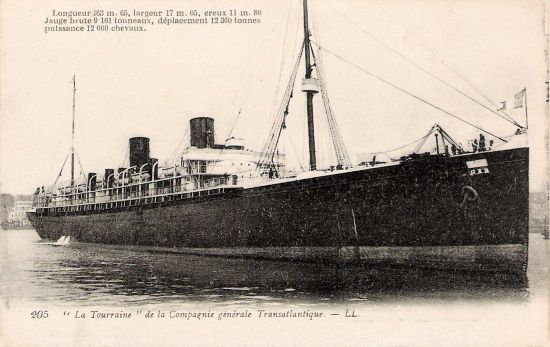 She was launched in 1890 and made Le Havre her home-port. LA LORRAINE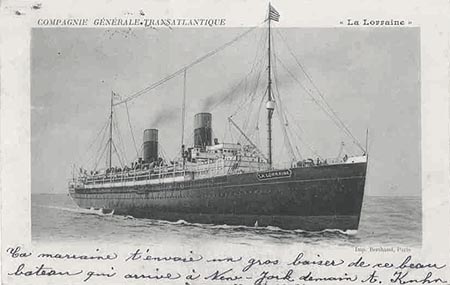
LA SOVOIE 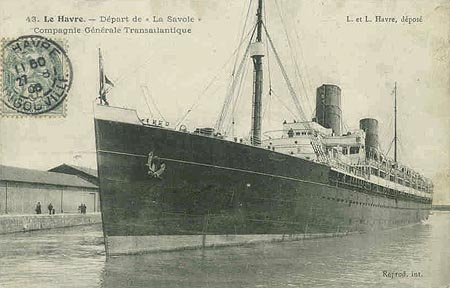
HAVANA 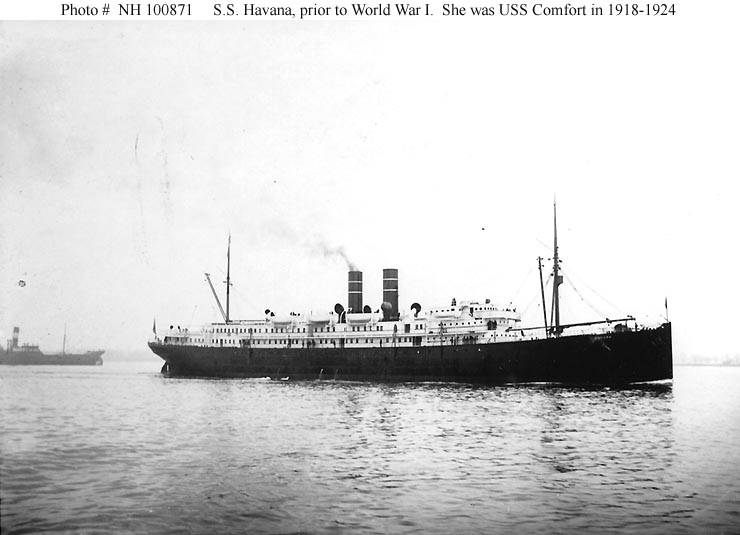
|
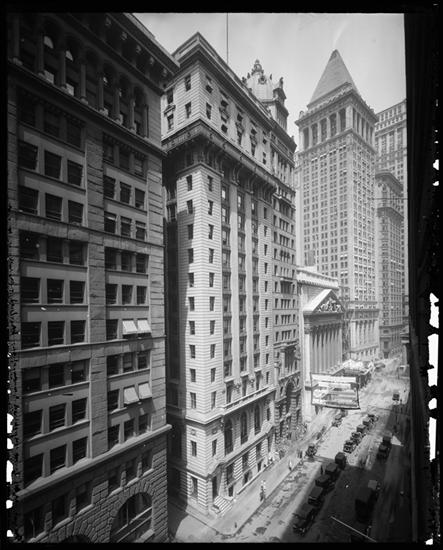 A fellow researcher emailed me the following,
A fellow researcher emailed me the following,
"I came across your genealogy website as I have recently been looking at photocopies of the the deeds for my parents house and wondered whether you might be interested in the following (I am also a genealogist).To the right is the Blair Building, 24-28 Broad Street at Exchange Place, NW Corner. It is the building in the center of the photograph. Lying in the Financial District, it was one of New York City's earliest skyscrapers. It was constructed in 1902-1903 at the corner of Broad and Wall streets, near the New York Stock Exchange building. Nice address.
The freehold to my parent's house and the one next door was sold on 28th June 1907 to Frederick Nunez Heysham whose address at the time was given as Blair Buildings, 24 Broad Street, New York,, USA.
On his death the freehold passed to his widow, and in 1929 was sold to the the owner of the property. The address of Ada Beatrice Heysham at that time was given as Linden Hall, Bournemouth. That transaction also refers to "Frederick Fernandez Nunez Heysham deceased late of 20 Broad Street House, New Broad Street, City of London"."
"In the mining boom of 1905 and 1906, the Curb market on Broad Street attracted negative publicity for the "wholesale use of the Curb for swindling". The curb brokers had been kicked out of the Mills Building front by 1907, and had moved to the pavement outside the Blair Building where cabbies lined up. The curb market operated starting at 10'clock in the morning, each day except Sundays, until a gong at 3 o'clock. Orders for the purchase and sale of securities were shouted down from the windows of nearby brokerages, with the execution of the sale then shouted back up to the brokerage."
Next is Linden Hall, Bournemouth. It was a Hydropathic Hotel. It included Turkish and Russian baths and a Sea Water plunge.
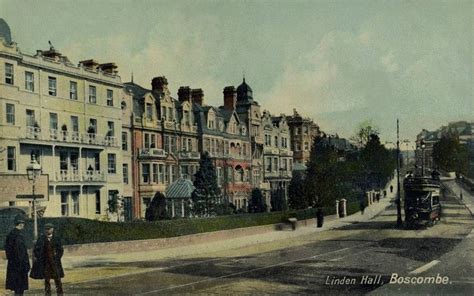
Broad Street House, New Broad Street, below, is also in the Financial District, this time of London. Again, a nice place.
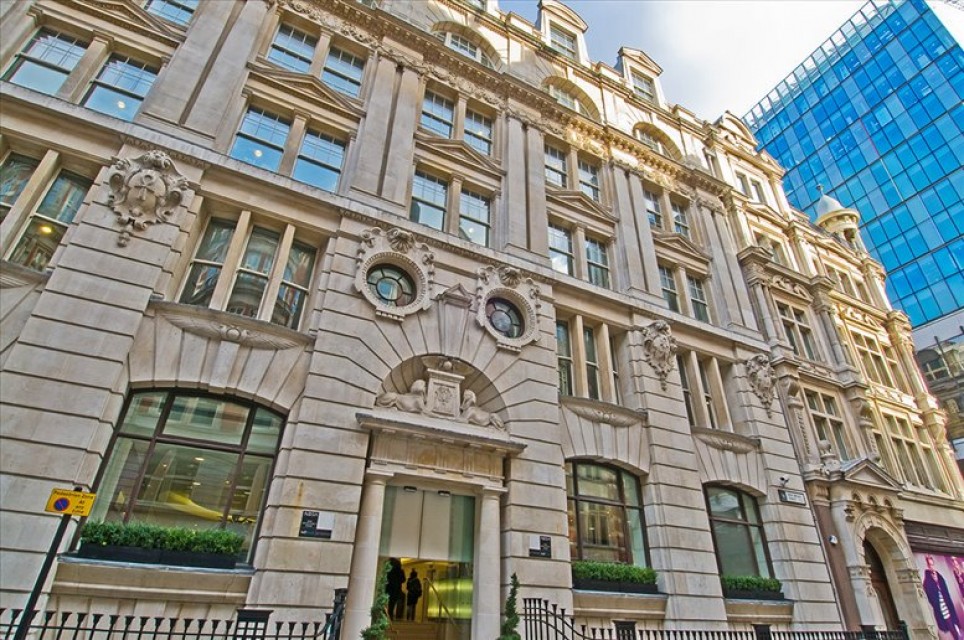
The documents referred to above are, first, a conveyance of two residences, No. 6 and 8 Chislehurst Avenue, North Finchley, in North London, from Robin Maurice Rands to Frederick Nunez Heysham dated 2 July 1907. Second, the sale of No. 6 Chiselhurst Avenue by Ada Beatrice Heysham on 21 January 1929. These are row houses, perhaps of the upper middle class sort. Were these income properties? Rands, who lived in Thornton Heath, the other side of London, was the son of William Brighty Rands and Hannah Rolls. William Rands was an author of some note, see his biography at The Victorian Web.
Circa 1914, "Mr. Frederic N. Heysham is a director of James Lyne Hancock, Limited, 266, Goswell-road, E.C." - from "The Directory of Directors for Joint Stock Companies of the United Kingdom" by Thomas Skinner & Company, 1914. Frederick was one of four directors in 1916 - from "The Stock Exchange Year-Book" of 1916. James Lyne Hancock were manufacturers of Vulcanized India Rubber goods, of 266 Goswell Road, London, EC. The firm was taken over in 1939 by British Tyre & Rubber.
Frederick died on 17 January 1918 according to his tombstone, predeceasing his father by one month. He was buried in the same plot with his mother and father. He was only 56 years old.
"Heysham Frederick Fernandez Nunez of Glengarry Stanley-road Teddington Middlesex died 17 January 1918 Probate London 16 March to Ada Beatric Heysham widow. Effects L17615 17s. 4d." - from the National Probate CalendarAda died on 18 August 1962 at Bury St. Edmunds.
Guy recently emailed me the following update,
"Frederick Fernandez Nunez Heysham and Ada Beatrice Lovegrove had a daughter, Elsie Kathleen Heysham, born 20 August 1907 at 63 Queensborough Terrace, London. Elsie, who at some point changed her name to Zita, married Wilfred Adams Irwin in July 1937. They appear on the 1939 Register. They appear to have had no children. Elsie/Zita died on 10 May 1979 at 53C Sloane Street, London.(26) Elsie Kathleen Heysham (1907)
Frederick was cremated at South Metropolitan Crematorium (West Norwood Cemetery) and his ashes scattered there. Ada was also cremated at Dry Drayton Crematorium and her ashes scattered there.
You may be interested to know that Elsie was a second cousin of Camille Doncieux, Claude Monet's first wife and mother of his children, through Anne Marcel's family. A recent exciting discovery.
I hope these are of interest to you.
Best wishes,
Guy Boocock"
Elsie K. Heysham married Wilfred A. Irwin in the 3rd Quarter 1937 in Marylebone, London, England - from the England and Wales Marriage Registration Index.
(23) Frederick Heysham (1800) He was christened on 23 November 1800 in Saint Pauls Walden, Hertfordshire, the youngest son of Robert Thornton Heysham. He attended Rugby school, right.
He was christened on 23 November 1800 in Saint Pauls Walden, Hertfordshire, the youngest son of Robert Thornton Heysham. He attended Rugby school, right.
January 1816. "Heysham, Frederick, third son of Robert Thornton Heysham, Esq., Hinton House, Alresford, aged 16, October 6. Townsend.
Pembroke College, Oxford, 1820" - from the "Rugby School Register"
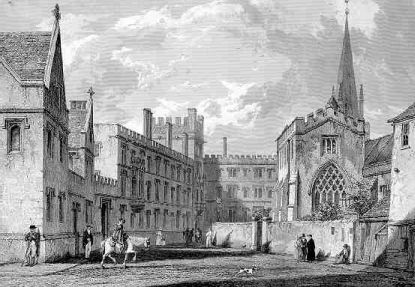 Townsend was a house at Rugby. Like his father and brothers, he attended Oxford, studying at Pembroke College, pictured to the left.
Townsend was a house at Rugby. Like his father and brothers, he attended Oxford, studying at Pembroke College, pictured to the left.
"Heysham, Frederick, 3s. Robert Thornton, of Walden, St. Paul's, Herts, arm. Pembroke Coll., matric. 23 March, 1820, aged 18." - from "Alumni Oxonienses: the Members of the University of Oxford, 1715-1886"Again, no suggestion that Frederick earned a degree.
After Oxford Frederick became something like a trust-fund kid, not working, but enjoying life. Like his nephew, William Nunez Heysham, he was a perennial member of the hunt.
20 December 1833. Brighton Hurdle Race. "A Hurdle Sweepstakes of five guineas each, with a bonus added from the Subscription Fund, for horses not thorough-bred, and tht have never won any plate, match, or sweepstakes, 12st. each, over the New Course, one mile and three quarters, heats: the owner of the second horse to receive back his stake: the horses to be bona fide the property of Gentlemen, and to be rode by Gentlemen; . . . Second Heat.--Moonlight (rode by T.Tourl, Esq.), Sailor, and Lalla Rookh (F. Heysham, Esq.) all fell at the return hurdles; . . . " - from the "Sporting Magazine" by AnonymousIn the Sporting Magazine of 1834 has F. Heysham riding horses Sailor and Lalla Rookh. It speaks rather kindly of Fred, saying that,
". . . here a genuine sportsman, in the person of Mr. F. Heysham;"
"Though there is a bruiser or two amongst them, I do not remember having seen much actual hard riding or determination to get to hounds with the Members of Mr. Craven's field. That merry and most gentlemanlike performer, Fred. Heysham, is much about the most forward of them . . ."There are many more specimens like this that do not need to be repeated.

I believe the following fits here:
1839. "George Swainston of Saundridge, labourer, for embezzling £5 13s., the property of his master, Frederick Heysham of Stagenhoe, esquire (transported for 7 years)." - from Hertford Co. Eng. Sessions Records in "Hertford County Records" by William John HardyThat's a tough punishment for such a minor crime. Another tough punishment is undated.
"James Game and William Wiles, both of Little Munden, labourers, for stealing a bushel of potatoes, value 2s., from Frederick Heysham, gentleman. [Three weeks in gaol and publicly whipped.]" - from "Hertford County Records" by Great Britain Court of Quarter Sessions of the Peace (Hertfordshire), Hertfordshire (England). County Council, William Henry Clement Le Hardy
In the 1841 census of St. Mary, Marylebone, Middlesex as Frederick Heysham, 35. He was living with his parents.
"Mr. Frederick Heysham, a Hampshire man, would go in any country, being a firm and good horseman, with pluck equal to any thing. I believe I once said of him that he had no objection to a newly white-painted gate, at any time of the day, and that is saying enough on the score of nerve." - from "Hunting Reminiscences" of 1843 by Nimrod.
Frederick was mentioned in his father's will of 1849 as an executor.
In the 1851 census of Ropley, Hampshire as Frederick Hysham [sic], a bachelor of 50, with no profession, of St. Pauls Walden. He was living with his elder brother, William Henry Heysham.
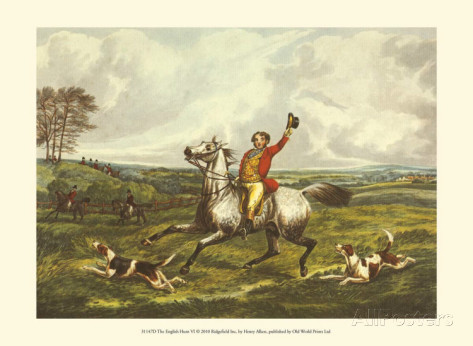 In the 1861 census of Winchester St Bartholomew Hyde, Hampshire as Frederic Heysham, a visitor at Highfield Lodge. He was an unmarried 60 year old with no profession, born in St Paul's Walden, Hertfordshire.
In the 1861 census of Winchester St Bartholomew Hyde, Hampshire as Frederic Heysham, a visitor at Highfield Lodge. He was an unmarried 60 year old with no profession, born in St Paul's Walden, Hertfordshire.
In the 1871 census of St Bartholomew Hyde, Hampshire as Frederick Heysham [Hoysham in Ancestry.com], a 70 year old unmarried man with no occupation. He was a visitor at the Highfield House of William Thomas Groome [?], the county magistrate. Of Hertfordshire.
Even at his advanced age Frederick continued to ride and to hunt.
"Mr. Frederick Heysham, an octogenarian, who can hold his own across country, notwithstanding he is so heavily handicapped with age;" - from "Hark Away: Sketches of Hunting, . . ." by Frederick Feild Whitehurst
In the 1881 census I have a Frederick Heysham, born in 1801 in St Paul's Walden, Hertford, who was 80 years old. Occupation: Esquire Independent. He was unmarried and living in the home of Ann Parsons as a boarder at 6 City road, Weeke, Hampshire, England.
Frederick Heysham died in July-September 1888 in Winchester, Hampshire, aged 87.
"Heysham, Frederick. 1 September. The Will of Frederick Heysham late of Belle Vue House City-road Winchester in the County of Southampton Esquire who died 10 August 1888 at Belle Vue House was proved at the Principal Registry by William Nunez Heysham of 6 Alpha-road Regent's Park in the County of Middlesex Esquire the Nephew the sole Executor." - from the National Probate Calendar
The youngest daughter of Robert Thornton and Sarah Heysham. She was born on 8 January 1803 in St Pauls Walden. In the 1841 census of St. Mary, Marylebone, Middlesex as Sarah Heysham, 25. She was a single woman, living at home with her parents. She was mentioned in a mortgage of her father's estates in 1843.
Sarah Heysham married James William Drake, esq., Royal Navy, on 29 January 1846 in Saint Nicholas church, Brighton, Sussex.
"At Brighton, James William Drake, esq. R.N. son of the Rev. John Drake, Northchurch, Herts, to Sarah, youngest dau. of Robt. T. Heysham, esq. late of Stagenhoe Park, and of Weston Lordship, Herts." - from "The Gentleman's Magazine" of 1846He was the son of the Reverend John Drake of Northchurch, Hertsfordshire and Margaret Frances. He was born on 31 October 1809 and christened on 1 December 1809 at Great Berkhamnpstead, Hertfordshire. He was admitted to the Westminster school on 30 May 1823. He later entered the Royal Navy and rose to the rank of Mate on 3 August 1831. The Mate was an officer under the direction of the master, i.e. Master's Mate. He was especially concerned with navigation and keeping the log. It was a rank between Midshipman and Lieutenant. Fletcher Christian, of HMS BOUNTY infamy, was Master's Mate and Acting Lieutenant. To make Lieutenant an examination was required, but passing it did not ensure advancement. First a place had to be found, then influence acquired, both of which could be difficult for the son of a country parson. James was listed as a Mate, on half-pay, that is on shore without a ship, in "The Navy List" of 1848, 1850 and 1853.
Sarah had died by the time her father's will was signed in 1849. James died on 28 June 1862.
(22) Edmund Heysham (1771)The LDS database claims, based on records of the church at Little Munden, that Robert Thornton Heysham and his wife, Hannah, had a second son, Edmund, christened on 15 February 1771 in Saint Pauls Walden, Hertford, England. However Robert's will of 1775 shows that Robert and Hannah had only two children living at that time, neither of them Edmund. Apparently young Edmund died before 1775.
(22) Elizabeth Thornton Heysham (1772)She was born in 1772. Elizabeth married the Reverend John Benn on 27 December 1790. He was born in 1765, the son of Anthony Benn, of Hensingham House, Cumberland, and Margaret Spedding. John was the Rector of All Saints church, Faringdon, Hants, from 1797 to 1857. They had 13 children.
The Benn's were particular friends with the family of the novelist, Jane Austin, and there was much visiting between them. One of the Benn daughters, Harriet, was mentioned repeatedly in the letters of Jane Austin. Harriet remained single, like Austen, and had to be supported by her relatives. John died on 6 May 1857. Elizabeth died in 1861.
There was a Frank Heysham Benn, the son of Edward Benn, Esq., born 6 August 1866. He attended Cheltenham College.
Entered January, 1879. "Benn, Frank Heysham, son of Edward Benn, Esq., 1 Lypiatt Terrace, Cheltenham; born 6th August, 1866." - from the "Cheltenham College Register"His brother, Harry Gordon Benn, born 2 November 1864, also attended this school. I suspect they were a grandsons of this couple.
| The Benn Family of Whitehaven, Cumberland
The Benn's were a large, extended family of merchants, ship-owners and ships-masters. A William Benn was an Alderman and Mayor of London in 1747. The Labor MP, Tony Benn, is apparently a descendent of this clan. (18) Ralph Benn (c1627)Of Scratgate, Hensingham, Cumberland. He married Isabella. He died in December 1667. (19) Anthony Benn (1657)(18) Ralph Benn (c1627) He was baptized on 6 April 1657 at St. Bees, Cumberland. He married Bridgett Patrickson on 4 February 1679. He died and was buried on 25 August 1728 at St. Bees, Cumberland. His will was dated 18 July 1728. (20) John Benn (1689)(18) Ralph Benn (c1627) (19) Anthony Benn (1657) He was christened on 25 October 1689 at St. Bees, Cumberland. He married Margaret. High Sheriff of Cumberland. He died and was buried on 5 September 1761 at Holy Trinity, Whitehaven. (21) Anthony Benn (c1743)(18) Ralph Benn (c1627) (19) Anthony Benn (1657) (20) John Benn (1689) He was christened on 4 June 1743 at St. Bees, Cumberland. A merchant and exporter of Cumberland. High Sheriff of Cumberland in 1775. In the latter 1770's Anthony acted as a Justice of the Peace, that is, he sent a woman to jail and read the "Riot Act" in the face of a mob. Anthony Benn married Margaret, the daughter of Lowther Spedding, on 3 December 1764 at St. James, Whitehaven, Cumberland. She was born in January 1742 and died in 1779. Anthony second married Mary, the daughter of Robert Watters [High Sheriff of Cumberland 1777], in 1781. He died in 1799. Their children were William, John, Anthony (5 February 1771), Peter, Mary, Christiana, and Margaret. (22) Reverend John Benn (1765)(18) Ralph Benn (c1627) (19) Anthony Benn (1657) (20) John Benn (1689) (21) Anthony Benn (c1730) He was born in Whitehaven, Cumberland and christened at St. James church on 3 December 1765. He married Elizabeth (Eliza) Thornton Heysham. He died on 6 May 1857. |
Anne Thornton Heysham married John Shipton on 29 August 1757 in St. Pauls Walden, Hertford, England.
1757. "On Monday last was married at Paul's Walden in Hertfordshire to Miss Heysham, Daughter of Giles Thornton Heysham, Esq, of Stainho." - from "The London Chronicle"Shipton was possibly a Doctor of Divinity. Her father died in 1768 and she would have inherited her share of the estate, probably about 2000l by that time. (21) Jane Heysham (c1730)
Jane's father died in 1768 and she would have inherited her share of the estate, probably about 2000l by that time. She apparently never married. There is a will for a Jane Heysham, spinster of Penn, Buckinghamshire dated 8 June 1796. In it she leaves all of her estate, real and personal, to her little brother, the Reverend Edmund Heysham of Little Munden who was also named the Executor. Note that her other brothers, Robert and Giles, had died by this time. The will was proved on 7 June 1798.
"This is the Last Will and Testabment of Miss Jane Heysham of [Pese] in the County of Burlingham Spinster.(21) Giles Thornton Heysham (1736)
I give devise and bequeth unto my beloved Brother Edmund Heysham of Little Munden in the County of Hertford Clerk all the property of which I shall be possessed and all my Estate and Effects both real and personal whether in possession Reversion or Remainder To hold the same to the said Edmund Heysham his heirs Executors Administrators and Assigned for ever according to the nature of the said Estates and
I do hereby constitute and appoint him my said Brother Edmund Heysham Executor of this my will.
I do most earnestly desire to be buried in the family Vault at Pauls Walden in the County of Hertford and in a Leaden Coffin.
I do hereby revoke all former Wills and declare this only to be my last Will in Witness wereof I have hereunto set my hand and Seal the Eighth day of June in the Year of Our Lord One Thousand seven hundred and ninety six.
Jane Heysham
Signed sealed published and declared by the above named Jane Heysham as and for her last Will and Testament in the presence of us who in her presence at her request and in the presence of each other have subscribed our Names as Witnesses the words "and in a Leaden Coffin" being first interlined.
Sarah Graverseyn T. Middleton Saml Deacon
This Will was proved at London the seventh day of June in the Year of Our Lord One thousand seven hundred and ninety Eight Before the Worshipful Charles Coote Doctor of Laws and Surrogate of The Righ Honourable Sir WIlliam Wynn Knight also Doctor of Laws Master Keeper or Commissary of the Prorogative Court of Caterbury lawfully constituted by the oath of The Reverend Edmund Heysham Clerk the Brother of the deceased and sole Exectuor named in the said Will to whom adminstration was granted fo all and singular Goods Chattels and Credits of the said deceased having been first sworn duly to administer."
He was christened on 4 April 1736 in Saint Pauls, Walden, Hertford, England. The son of Giles Thornton Heysham and Ann, his wife. He had an elder brother, also named Giles, who was born on 10 July 1732 at St Botolph Without Aldgate, London. This was before (20) Giles inherited and was still going by the name Giles Thornton. That child died on 20 September 1732.
Giles attended Winchester College, in Hampshire. Under the title "Inscriptiones Wiccamicae", Marbles, is
"W. Wall . . . 2nd line . . . Benjamin Wheeler, 1751 Giles Thornton Heysham, 1750 William Simonds, C.F., 1746 . . ." - from "Wykehamica: A History of Winchester College and Commoners, from the Foundation to the Present Day" by Henry Cadwallader AdamsI expect that 1750 was when Giles matriculated, or entered, Winchester College. Despite being called a College, Winchester was a prep school for the Universities. Today boys enter at the age of 13. By the way, the odd title of the reference derives from Winchester's founder, William of Wykeham.
Giles, aged 23, married Susanna Marshall on 22 December 1759.
"Giles Thornton Heysham of the Parish of St. Andrew Holborn, Bachelor, and Susannah Marshall of ths Parish, Spinster, married in this church [St. Botolph without Aldgate] by Licence this twenty second date of December in the year One Thousand Seven Hundred and Fifty Nine by me Mr. Disney, Curate
In the Presense of Ralph Hooten and Rt. Harvey" - from "London, England, Marriages and Banns, 1754-1921"
Giles' father died in January 1768 and Giles Jr. would have inherited his share of the estate, probably about 2000l by that time.
The following, relative to a land transaction, places Giles near St. Pauls Walden, his parent's home in Hertfordshire county.
9 July 1768. "(i) George Wharton of Sherington, yeoman, and Giles Thornton Heysham of Saint Tibbs in parish of St.Ippolitt, co.Herts., gent., and Susannah his wife.This is probably our Giles since St. Ippolitts is near Hitchen, where Giles' daughter was born in 1764.
(ii) Rev. Philip Barton of Sherington, clerk." - from the UK Archives, Duncombe and Barton family transactions in Great Brickhill, Buckinghamshire.
| St. Ippolitts
Ippolitts is a variant of St. Hippolytus, a martyr of the early church. His name meant "loose horse." In Greek myth Hippolytus, the son of Theseus, was drug to death. The martyr Hippolytus became the patron saint of horses. During the Middle Ages, sick horses were brought to St. Ippolitts, in Hertfordshire where a church was dedicated to him. The town is just south of Hitchin. The parish is just north of St Paul's Walden. I haven't found Saint Tibbs. |
A document on paper in the form of a letter being entitled "Instructions for Bill" which gives information regarding money owed on a bond and the events occurring between 1778 and 1785 approximately between P Driver and P Johnson reading as follows:
"On the 6th August 1778 Mr Driver received a letter from Johnson's nephew now an Atty. in this City who mentioned that he had received a letter from his uncle (Jas Johnson) inclosing a demand on him (Mr Driver) for £237 s16 d8 due on bond and notes and money paid for him and that he was desired to ask Driver for the money as he had then great occasion for it. Mr Driver being greatly astonished sent the said letter to Mr Parry his solicitor who transacted his business and devised him (who well knew every circumstance between Driver and Johnson) to answer it on the 30th of the same month. Mr Parry wrote to Driver that he would answer Johnson's letter and mentioned that he understood the contrary that he (Johnson) was in Driver's debt About the beginning of September following Driver wrote to Johnson expressing his surprise at his demand and informed him that he well knew that he owed him (Driver) 100l to which letter Driver received no answer until Johnson's arrival in Hereford which was in the course of a few days afterwards when Driver received a line from him to meet him in Hereford which Driver did about the 10th of the same month at the Swan and Falcon in Hereford and Driver being accompanied by one Giles Thornton Heysham Esq did in his presence demand of Johnson how he could write to him for money when he (Johnson) must know that he then stood indebted to him (Driver) in 100l upon which Johnson without coming to any explanation or taking any notice of his demand (although Driver met him for that purpose according to his letter) instantly turned himself around and left the room." - from Instructions for Bill Dated c.1785
Giles probably died before 1798 since he was not mentioned in the will of his elder sister, Jane. His children were,
(22) Susanna Heysham (1764)
She was born on 17 July 1764 at St. Mary, Hitchin, Hertfordshire, the daughter of Gyles Thornton and Susanna Heysham, per the LDS database. She probably died young.
(21) Sarah Heysham (1737)She was born on 6 October 1737 in Saint Pauls Walden, the daugher of Giles Thornton and Anne Heysham, per the LDS database. She probably died young. Unlike her sisters, above, she was not mentioned in "The Correspondence of Edward Young," the father-in-law of Elizabeth Heysham. Contrarily, there is a will for a Sarah Heysham, spinster of Hatfield, Hertfordshire dated 14 November 1795 which may be for her.
(21) Edmund Thornton Heysham (1740)This part of the family died out in the male line in the next generation. The son of Giles Thornton and Anne Heysham of Stagenhoe, Hertfordshire, per the LDS database and the records of Oxford University. He was christened on 19 January 1739/40 in Stagenhoe, Kings Walden, Hertfordshire, England. He may have been named for his grandfather, Edmund Thornton, from whom the estate of Little Munden descended. He attended Harrow.
"Heysham, Edmund. Son of Gile Thornton Heysham of Stagenhoe, Hertfordshire. School, Harrow (Dr Thackeray). Age 18. Pensioner, March 22, 1759. Tutor, Mr. Whisson. [Matriculated, 1759; Scholar, 1760; B.A. 1763.]" - from "Admissions to Trinity College, Cambridge"The Dr. Thackeray at Harrow was the father of the author, William Makepeace Thackeray. The latter was born at Harrow.
| Harrow
Dr. Thackeray became the headmaster of Harrow in 1746 and has been called the school's "second founder," bringing in an Etonian curriculum. |
Edmund entered Trinity College, Cambridge on 22 March 1759 at the age of 18. He got his B.A. in 1763.
"VENN
Adm. pens. (age 18) at TRINITY, Mar. 22, 1759. S. of Giles Thornton, of Stagenhoe, Herts. Matric. Michs. 1759; Scholar, 1760; B.A. 1763. R. of Little Munden, Herts., 1771-1819. Married Sarah, dau. of __ Smith, of Watford, Herts., and had issue (a son, Edmund, matric. from Exeter College, Oxford, 1796). Died Jan. 23, 1819, aged 79. M.I. at Little Munden. (Cussans, II. pt 2, 153; P. B. G. Binnall.)
Year Type Name as Recorded Location Office/Status VIEW
1763 Ordi(ordination) Heysham, Edmund / deacon
1766 Ordi(ordination) Heysham, Edmund / priest
1771 Appt(Institution) Heysham, Edmund Munden parva / Rector
1814 Appt(Licensing) Heysham, Edmund Great Munden / Stipendiary Curate
1819 Vac(Death) Heysham, Edmund Little Munden / Rector
- from www.theclergydatabase.org.uk
| Trinity College, Cambridge
|
Soon after being ordained a deacon Edmund became a chaplain with the East India company in Bombay.
"And your committee called for an account of the numbers of the several servants appointed by the East India Company, for their several settlements in India, since the year 1763; and the same is as follows; viz.This was very early in company rule. Bombay island had been leased by the company since 1668, but it controlled no other territory in the region; its far larger and more lucrative base was in Bengal.
. . .
1765
. . .
Bombay
. . .
1 Chaplain . . . Revd. Edmund Heysham" - from the "Further Report (being the Eighth) from the Committee of Secrecy to Enquire into the State of the East India Company," 1773
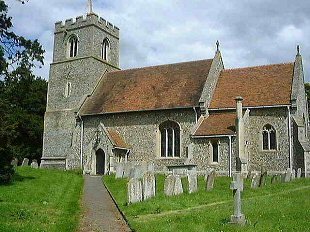 Edmund became a Priest on 23 February 1766 by letter from the Bishop of London, perhaps while still residing in India.
Edmund became a Priest on 23 February 1766 by letter from the Bishop of London, perhaps while still residing in India.
His father died in 1768 and Edmund would have inherited his share of the estate, probably about 2000l by that time. This would have allowed Edmund to return home, if he hadn't done so already. More importantly, his elder brother, Robert Thornton Heysham, in addition to inheriting the bulk of their father's estate, also inherited the patronage of the Anglican church at Little Munden. I believe that Edmund became the Rector of All Saints church, Little Munden, Hertfordshire due to that patronage. Edmund remained at Little Munden, right, from 1771 to 1819. Read the following as Parish - Population - County - Diocese - Archdeaconry - Incumbent - Value in the King's Books - Patron:
"Munden, Little R - 453 - Herts - Linen. - Hunts - Edm. Heysham - 15 0 0 - T. Heysham, Esq" - from "The Clerical Guide"
The Reverend Edmund Heysham, LL.D., married Miss Anne Maria Smith of Watford, Hertsfordshire, on 30 July 1772 in St. Marys, Watford, Hertfordshire, England - from "Hertfordshire 1731 to 1800: As Recorded in the Gentleman's Magazine" by Arthur Jones. The LDS database names her Sarah Smith. She was the daughter of Samuel Smith, esquire of Watford. Samuel was a brewer; obviously successful enough to become an equire. Edmund and Sarah had a large family, perhaps as many as six daughters and three sons.
Tim Brooks, another researcher found the following,
"You may or may not have found this reference in Samuel Smith's will (proved on 5th October 1782).
".....And unto the Reverend Mr Edmund Heysham Rector of Little Munden in the said County of Hartford who married my other Daughter Sarah the like sum one thousand of the money to be paid to him this said Edmund Heysham . . ."

Edmund died on 23 January 1819 at the age of 79, or,
"In his 78th year, the Rev. E. Heysham, 47 years rector of Little Munden, Herts." - from "The Gentleman's Magazine"There is a monumental inscription to him at Little Munden.
"Sacred
To the Memory of
The Rev. Edmund Heysham,
49 Years Rector of this Parish:
Died Jany. 23rd. 1819,
Aged 79 Years.
And Sarah, his wife, Died Jany. 26th. 1838,
Aged 80 Years
Also, Their Son Frederick,
Died Decr. 26th. 1816
Aged 29 Years.
Also Caroline,
Fourth Daughter of the Above
Who Died April 9th. 1841,
Aged 59 Years.
Likewise Sarah
Eldest Daughter of the Above;
Died July 19th. 1850,
Aged 76."
Sarah died on 26 January 1838.
1838. Obituary: "Jan. 26. At Hertford, aged 91, Sarah, widow of the Rev. Edmund Heysham, Rector of Little Munden." - from "The Gentleman's Magazine"
Edmund and Sarah's children were,
(22) Sarah Heysham (1773)
(22) Elizabeth Heysham (1775)
(22) Edmund Heysham (1777), he died in India
(22) Frances Heysham (1778)
(22) Henry Heysham (1780), he apparently died young
(22) Caroline Heysham (1782)
(22) Louisa Heysham (1783)
(22) Frederick Heysham (1786), he died at the age of 30, dsp
(22) Mary Heysham (1789)
She was born on 5 November 1773 at St. Marys, Watford, Hertford, England, the daughter of Edmund and Sarah Heysham. She died on died on 19 July 1850 in Hertfordshire.
1850. Obituary: "July 19. At Hertford, Sarah, eldest dau. of the late Rev. Edmund Heysham, Rector of Little Munden." - from "The Gentleman's Magazine"Apparently she never married. There is a will for a Sarah Heysham, spinster of Hertford, Hertfordshire dated 20 August 1850 which must be for her. (22) Elizabeth Heysham (1775)
She was born on 26 March 1775 and christened on 1 May 1775 in Little Munden, Hertford, England. She married Edward Green on 24 October 1797 in Little Munden. Edward was the son of Aaron Green (1735-1806), of Ware, Hertfordshire, and Susannah Fordham, Of Tundbrige. Edward was a partner in the banking firm of Dickinson & Green in Ware. Other partners included John and Thomas Green of Ware. The partnership was dissolved in 1813. Elizabeth's sister, Mary, married John Green in 1839, her second husband. He Was the brother of Edward Green.
Their children included Edward Heysham Green, who was baptized on 26 June 1802 in Tunbridge.
(22) Edmund Heysham (1777)Edmund, the son of Edmund and Sarah Heysham, was born on 10 April 1777 and christened 9 May 1777 in Little Munden, Hertfordshire, England - from the LDS database. This data was derived from transcripts from the Church of Little Munden, 1609-1812. I suspect his father, the Reverend, performed the baptism.
I have an Edmund Heysham who read a poem, written by a classmate, Henry Wardle, at a Public Day at Berkhamsted school, on 3 Ocotober 1793 - from "Muse Berkhamstedienses, or Poetical Prolusions by Some Young Gentlemen of Berkhamsted School." I don't know where else this might fit. Berkhamsted Grammar is an independent school in Hertfordshire, originally founded in 1541.
Young Edmund later attended Oxford.
"Heysham, Edmund, s. Edmund, of Little Munden, Herts., cler. Exeter Coll., matric. 11 May, 1796, aged 19." - from "Alumni Oxonienses: the Members of the University of Oxford, 1715-1886"I don't see any indication of a degree earned, though I suppose many didn't feel an obligation to do so. Rather, I think they looked down on those who did.
| Exeter College
In common with other colleges of the University, Exeter went through a period of general decline in the eighteenth century. Membership fell, and with it, intellectual enterprise and public standing. This By the way, J.R.R. Tolkien was a graduate of this school in 1911. |
Edmund joined the Company army of India. Note that his father, the Reverend Edmund Heysham, was a chaplain with the East India company circa 1765. Perhaps he helped his son find his way to India after leaving Exeter.
Per his date of rank to Cadet, Edmund entered the military service of the Honorable East India Company (HEIC) in 1799, when he was 22 years old.
"[Name] Heysham, Edmund . . . [Cadet] 1799" - from "Alphabetical List of the Officers of the Bengal Army"This was before the Company founded its own private military academy at Addiscombe. In 1798 the Company sent 10 cadets to the Royal Army's artillery and engineering school at Woolwich. The Royal Military Academy was established in 1741. It trained commissioned officers of the Royal Artillery and Royal Engineers. The institution was split into two parts. Younger cadets entered the Lower Academy where they were taught reading, writing, arithmetic, Latin, French and drawing. If they performed well in examinations they were allowed to proceed to the Upper Academy where they learned military skills and sciences, as well as fencing and dancing - from Wikipedia. Having attended Exeter college, I suspect Edmund entered the Upper Academy for his military training. The East India Company moved out of Woolwich in 1810.
The current Academy buildings at Woolwich date to no earlier than 1805. The buildings used before then were in the area on the map below marked as The Warren.
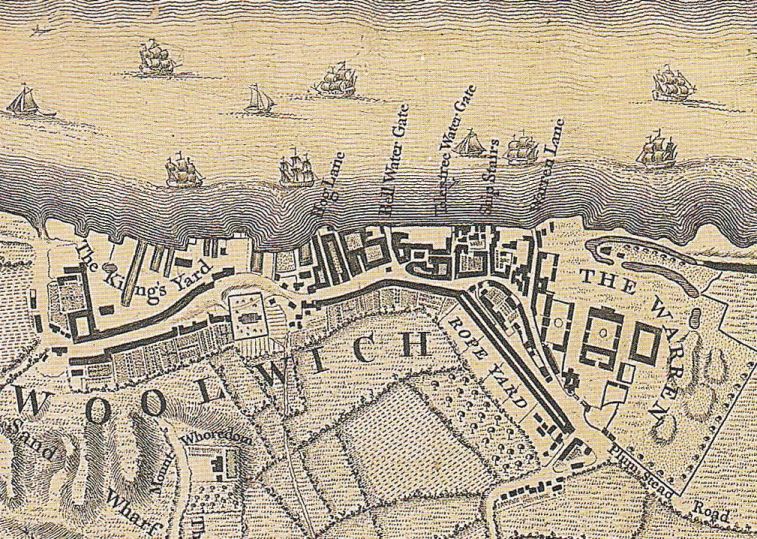
If Edmund was educated at Woolwich, he may have studied for as many as three years. But below you'll see that he was commissioned an Ensign in 1800, an act which I believe would have occurred only after the got to India - see the similar career of William Heysham on the John Heysham Family page. So I'm guessing that he remained for just one year.
UK Archives, India Office Records, East India Company:
- Cadet Register, 1775-1799: Heysham, Edmund
- Cadet Papers, 1799-1800: Heysham, Edmund
- Cadet Register, 1799-1802: Heysham, Edmund
Edmund was promoted to Ensign on 22 October 1800, probably soon after he arrived in India.
"[Name] Heysham, Edmund . . . [Cadet] 1799 . . . [Ensign] Oct. 22, 1800" - from "Alphabetical List of the Officers of the Bengal Army"By the way, at this time Lieutenat General Wellesley, later knwon as the Iron Duke, was the local commander.
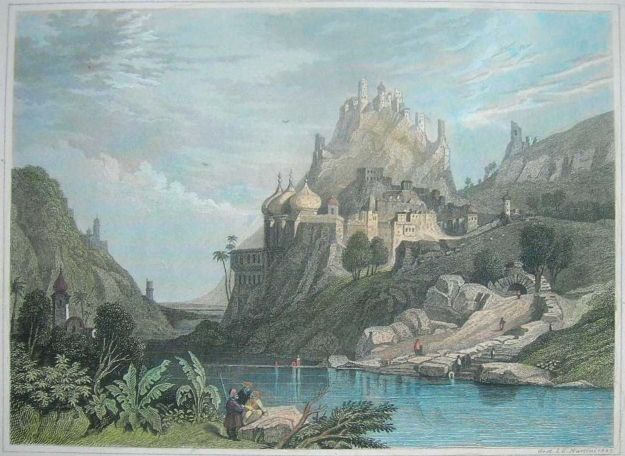 In "A New Oriental Register and East India Directory for 1802" Edmund was listed as an unassigned Ensign.
In "A New Oriental Register and East India Directory for 1802" Edmund was listed as an unassigned Ensign.
Edmund Heysham then joined the 1st Battalion of the 11th Bengal Regiment of Native Infantry, probably soon after the data was gathered for the register just mentioned above. The regiment was based in Etawah at this time, see to the painting to the right. This cantonment was on the banks of the Yamuna river in today's Uttar Pradesh. Etawah was one of the "ceded provinces" of 1801.
| The 11th Bengal Native Infantry
The 1st battalion was raised in 1764 and was renumbered as the 11th BNI in 1784. The "1st Bn, 11th BNI" became the "15th BNI" in the reorganization of 1824. The regiment, a part of the HEIC, served in the Second Marantha War in 1803 and the Gurkha War, from 1814 to 1816. The latter was an extremely hard fought war in which the Gurkha's earned their opponents respect, and have been a part of the British army ever since. The regiment also took part in the third Mahratha War, from 1817 to 1819. |
The 11th BNI would be engaged in the Hindustan campaign, beginning in 1802 and culminating in 1803. This was waged against the Marathas under the leadership of Daulat Rao Sindia. On 24 November 1802 five companies of the 1st battalion of the 11th Regiment from Etawah, under the command of Captain Drummond and including Ensign Heysham, occupied the cantonment at Shikoabad, relieving the 1st battalion of the 2nd Native Infantry. Lieutenant Colonel Daniel Coningham later took command of the detachment.
| Shikohabad
A small outpost on the Company's frontier in the Etawah district. |
John Pester, an officer in the 2nd N.I., wrote a memoir of this period.
"March from Shikoabad to Attack Sarssney (Sasni).The Mahratha were a people of India, known for their cavalry.
November 24th, 1802 December l0th, 1802.This afternoon orders were issued for us to march to-morrow morning, and in the course of the day Captain Drummond, with five companies of the 11th Regiment from Etawah, marched in to occupy the cantonments in our absence. Left my Mahratter [Mahratta] mare in care of Lieutenant Heysham, to whom also I gave the use of my bungalow whilst I should remain in the field." - from "War and Sport in India, 1802-1806" by John Pester
"They [their horses] are of a middling size and strong; but are, at the same time, a very handsome breed; generally of a dark bay, with black legs . . . Mares are commonly the dearest." - from the "Sporting Magazine"
"The Mahratta horses have much Arabian blood in them, and great care is bestowed by these people on their horses." - from "The Horse: Its History, Management and Treatment" by William Youatt
"The famous Mahratta horses are bred on the banks of these rivers [Narbaddah, Tapti, Godavari, Bimi, Kishtna]" - from "A Textbook of Indian History" by George Uglow Pope
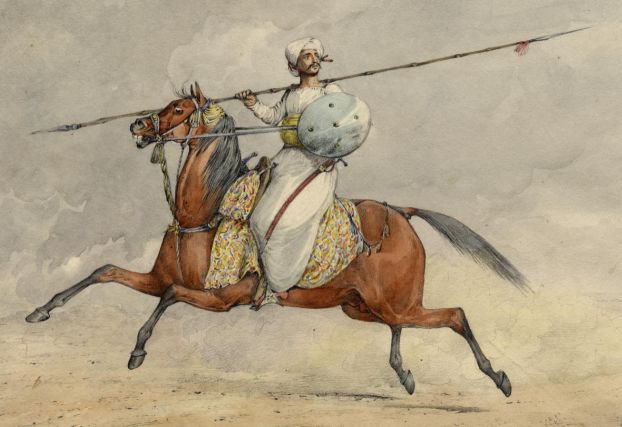
| John Pester
In 1800 this officer went to India as a Cadet and was appointed Ensign on his arrival. He joined the 1st battalion of the 2nd regiment in June 1801. In December he accompanied the regiment as they occupied an advanced position a Skekevabad [Shikohabad]. In August 1802 Lieutenant Pester and his company were detached against a rebel force assembled in the Skekevabad district. - from "The East India Military Calendar" by John Philippart |
Ensign Heysham spent the next year on duty at the remote outpost in Shikohabad.
Edmund was promoted to Lieutenant in 1803.
"[Name] Heysham, Edmund . . . [Cadet] 1799 . . . [Ensign] Oct. 22, 1800 . . . [Lieutenant] July 13, 1803" - from "Alphabetical List of the Officers of the Bengal Army"See also,
7 May 1803. "11th Native regiment. Captain Samuel Palmer, to be a Major from 7th May, 1803, . . . Ensign Edmund Heysham, to be a Lieut. do. [ditto, promoted] vice, Jones, ditto [promoted]."- from "The Asiatic Annual Register" of 1806.
During Lord Lake's campaign against the Mahrattas in September 1803 a detachment 5,000 Maratha horse, under a mercenary, Captain Fleury, came across the small British cantonment at Shikoabad held by five companies of the 1st Battalion 11th Native Infantry commanded by Lieutenant Colonel Cuningham [also as Conningham].
"Fort William, Sept. 21, 1803.John Pester writes again,On the 2nd instant, a body of predatory horse, commanded by a French officer, attacked the cantonment of Shekoabad on the frontier of the district of Etawah. The British forces at the post, consisting of five companies of the first battalion eleventh regiment native infantry, with one gun, under the command of lieutenant-colonel Coningham, continued to resist the attack of the enemy's cavalry during the greater part of the day, with great resolution and spirit, and at length succeeded in repulsing the enemey . . . On the 4th instant, lieutenant-colonel Coningham was again attacked by the enemy's troops, to whom he opposed a spirited resistance for some hours; but having reason to believe that their number was so considerable as to render further resistance ineffectual, he surrendered . . ." - from "Notes Relative to the Late Transactions in the Marhatta Empire" by Richard Wellesley
"Accounts arrived in camp that on the 5th the Mahrattas returned in force to Shikoabad. Colonel Cuningham and his small party, consisting only of three hundred men, had retired into a compound, there to defend themselves to the last extremity."After four days of very fierce resistance the outpost was forced to surrender. The only condition exacted was that the troops should not again be employed against Sindha during the campaign and the garrison marched out with all the honors of war. - from "A Particular Account of the European Military." Coningham's troops marched to Cawnpore.
"Lake sent reinforcements, but his inadequate supply system had left the garrison without sufficient ammunition to defend it . . . The attack on Shikohabad caused the judge and collector of Etawah province to flee to Fatehgarh." - from "The Second Maratha War" by E.M. FuhrCuningham and 4 of his officers were wounded. However, when the attack occurred John Pester, mentioned above, was on patrol in Alighar. He had left all of his furniture and possessions stored in his bungalow at Shikohabad. Pester heard from secondary accounts that he had lost everything - or almost - he had chosen not to store his European wine there. John wrote,
1803. "We heard the particulars of the affair at Shikoabad to-day, and a very severe business it seems to have been. Colonel Cuningham, Captain Wimbolt, Captain Lamborne, Lieutenants Heysham and Stoneham were wounded, and a great number of men killed and wounded. Colonel Clarke, with the 2nd Brigade of Infantry, expected to join us to-morrow. Colonel Macan, with one Brigade of Cavalry, marched last night in pursuit of the troops of the enemy, who, it was reported, were returning with reinforcements of men and guns to make another attack on the handful of men at Shikoabad." - from "War and Sport in India, 1802-1806" by John PesterThe following is from the index of Pester's memoirs.
"Heysham, Lieut., 11th N.I. (wounded at Shikoabad). 1802-Nov. 24. 1803-Aug. 14, Sept. 7" - from "War and Sport in India, 1802-1806: An Officer's Diary" by John PesterThis refers to the first mention of Edmund (taking care of Pester's mare), and the dates of the battle. From a dispatch filed at Fort William, Calcutta on 21 September 1803:
"The following are the names of the officers wounded in the attack on Shekoabad:
Lieutenant Colonel Conningham
Captain Lambourne
Captain Winbolt . . . Artillery
Ensign HeyshamThe number of Sepoys stated to be killed and wounded, is sixty three." - from "Notes Relative to the Late Transactions in the Marhatta Empire" by Richard Wellesley Wellesley
The cantonment was pillaged and burnt by the Marantha horse. Edmund and the other members of the Skikohabad detachment would have been ineligible for further service during the Marantha campaign; the British took this stuff seriously. They probably returned to Etawah to perform garrison duty.
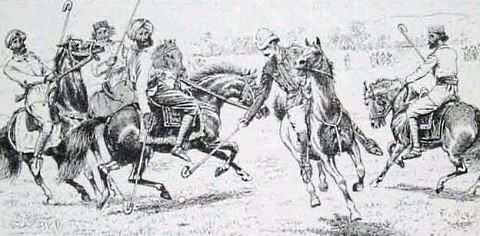 I don't know anything about the regiment or Edmund from 1804 to 1811.
I don't know anything about the regiment or Edmund from 1804 to 1811.
Unverified references: The 1st Battalion 11th Regiment formed the garrison, under Lieutenant Colonel Daniel Conyngham, at Gorakhpur from 104 to 1807. This was important in the execution of the Gurka War. Employed in dispersing dacoits [bandits] in Dinapore district Apr. 1809.
The Second Maratha war ended in 1805 and no major wars occurred again until 1814, when the Nepal, or Gurkha War broke out. I suspect this was a period of tedium, filled with the bureaucratic requirements of roll calls, exercises and inspections. Of course the officers would also hunt, play that new game called "polo," gamble and drink to fill the time.
In the relative quiet before the Nepal war Edmund was promoted to Captain on 12 May 1811.
"[Rank] Captain . . . [Name] Edmund Heysham . . . [Date of Rank] 12 May 1811" - from the "East-India Register and Directory" of 1819The following which we've referenced before, published in 1838, inexpicibly leaves out Edmund's last promotion, in 1811.
"[Name] Heysham, Edmund . . . [Cadet] 1799 . . . [Ensign] Oct. 22, 1800 . . . [Lieutenant] July 13, 1803" - from "Alphabetical List of the Officers of the Bengal Army"
Not long after Edmund Heysham was, shockingly, cashiered from the service.
"[Name] Heysham, Edmund . . . [Cadet] 1799 . . . [Ensign] Oct. 22, 1800 . . . [Lieutenant] July 13, 1803 . . . Cashiered Nov. 26, 1811." - from "Alphabetical List of the Officers of the Bengal Army"Cashiering was a degradation, a ritual dismissal from a position of responsibility for a breach of discipline. On the parade ground, in front of his peers, the officer's hat was knocked from his head, his emblems of rank torn from his tunic and his sword snapped in two; think of the old Chuck Conners TV show, "Branded." Kipling wrote of cashiering in India in the poem "Danny Deevers,"
"They've taken of his buttons off an' cut his stripes away,"To be cashiered, or discharged, from company service meant that Edmund had first undergone a court martial. By the way, apparently simple dismissal from the company was a lesser punishment, involving no degradation.
This was all pretty bad, but Edmund wasn't executed, as he would have been for desertion in the face of the enemy, or imprisoned and, as you'll read below, he was eventually restored to service so he was forgiven. I expect he did something that made it difficult for him to continue as an officer and a gentleman. I'll guess either excessive drinking or gambling, the great vices of the idle. If he gambled and wouldn't, or couldn't, pay off debts to his fellow officers that would mean he was not a gentleman. Some other things that could be grounds for dismissal of a company officer included,
- Any conviction in a civil court.
- False enlistment or false muster.
- Mutiny. In 1809 elements of the Madras army mutinied resulting in the court martial and cashiering or dismissal of 21 officers. However, 15 of them were later restored, perhaps indicating they were less at fault.
- Giving false testimony or keeping false records.
- Bribery. Because officer advancement was strictly by seniority it was not unknown for senior officers to be bribed to retire so that everyone else could move up. This was illegal unless done with Company approval and the officers concerned were liable to be cashiered.
- Embezzlement.
What would Edmund have done after this? Because he had been cashiered he was no longer allowed to hold any civil or military office in the Company. It seems that first, on 2 April 1812, Edmund executed a bond for 6,517 rupees to Messrs. Bush and Co. They were indigo merchants and planters in Bengal and may have acted as bankers as well. Then he went home to England for a while.
"Regiment HEIC 11th NISaugor Roads is in the mouth of the Hooghly river, south of Calcutta. I also have the following,
Year 1812
M/D 11-Jun
Ship Baring (2)
From Saugor Roads
To Gravesend
Rank Lt (Late)
Officers Heysham, E.
Total in party 1" - from HM Regt Embarkation Lists 1800-1848
"Date Jun 1812There was another passenger who was also a "late Lieut."
Ship Baring
Type HC Ship
Captain Henry Templar
Passenger Mr. Edmund Heysham
Occupation late Lieut. 11th N.I.
Origin Calcutta"
- from "Calcutta Directory" of 1813
| BARING
The Baring was built in London in 1801. Three-decked, with a length of 146ft 1 in (44.5 metres), she was launched at Deptford for Robert Charnock and taken up for the East India Company. She made six voyages for the Company between 1802 and 1814. In 1814 she left the East India service and was hired out as a convict ship. She brought convicts to New South Wales in 1815 and 1819. However, her voyages as recorded in the National Archives do not line up with being in Saugor Roads in June 1812. |
Edmund appears to have returned to India where I suspect he tried his hand at commerce; unable to serve in either the military or the civil service, there wasn't much else for him to do. I suspect that Edmund took a job with Messrs. Bush and Co. as a plantation overseer or a foreman at one of their dye factories. He was well qualified for the job; he undoubtedly knew the local language and had experience directing native labor.
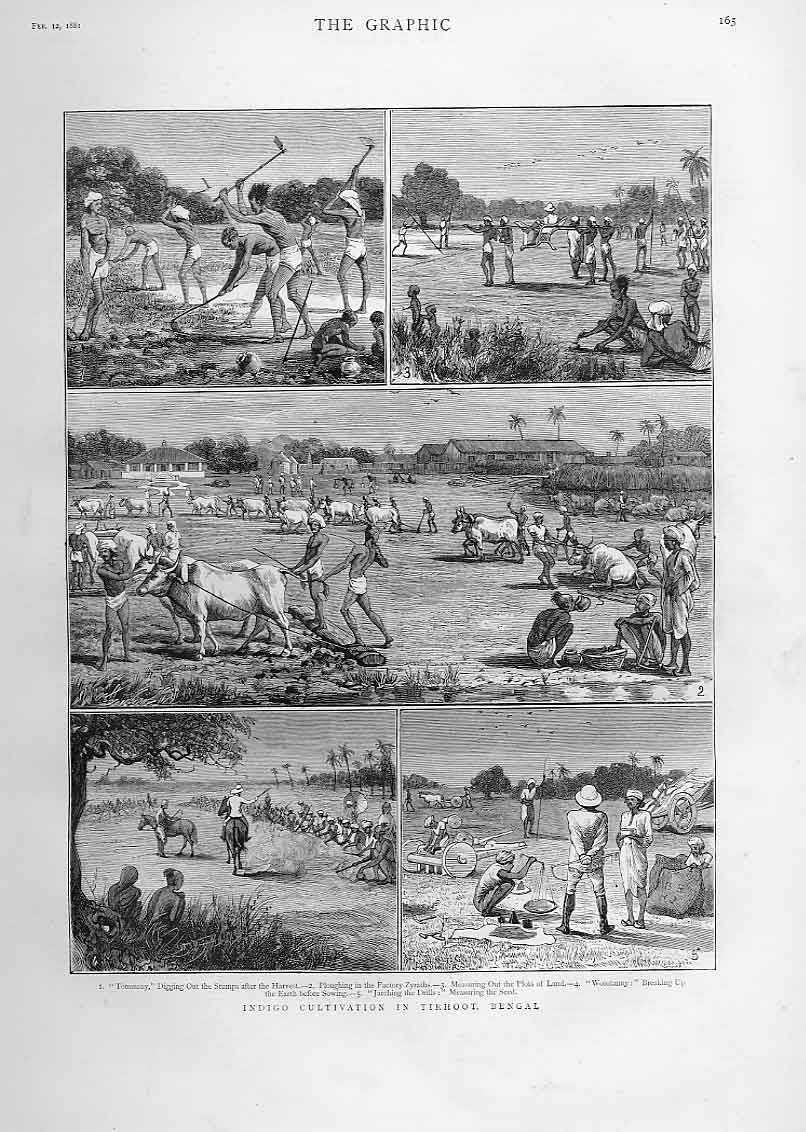
The following is interesting. I concerns the Agent's bungalow, that is the home of the Collector for the district, in Fatehgarh, Uttar Pradesh, northern India. It was, according to the following, bought from a Mr. Heysham in 1816. I only have two Heyshams in India in 1816. One was Ensign William Heysham who was in Calcutta in the first year of his military service. That doesn't sound like the right man. The other was "Mr." Edmund Heysham, a cashiered Lieutenant who might have been working for Bush & Company, indigo planters, at this time.
A serai was originally a resting place for caravan traders on the old silk route; an inn. If that definition is accurate, was Edmund an innkeeper? I note another citation from the reference above,". . . The M. E. Godown by the Fort was built by him [Nawab Hakim Mehdi Ali Khan] in 1824, the suspension bridge at Khudaganj, a well and a mosque in the Heysbam Serai behind the Company garden, the present Collector's residence and this large house for his own use following with a year or two." [pg 49]
. . ."This portion of the Civil Lines was inhabited before 1816. The Agent's bungalow, and the one behind Mrs. Collin's, were in that year bought by Sheikh Madari from a Mr. Heysham, the old serai being known also as Heysham's Serai. The Agent at first rented their house from Sheikh Madari. In 1841, however, the Agent, Major Simmonds, bought it outright for Rs. 2,400." [pg 70]
- from "Fatehgarh Camp, 1777-1857" by Charles Lindsay Wallace
"In 1835, no less than eighteen indigo planters can be identified at Fatehgarh . . ."One of those indigo planters at Fatehgarh was Messrs. Bush and Co. So could Edmund have owned a serai as part of his duties with Bush and Co?
| Fatehgarh
The town of Fatehgarh was taken by the British in 1802 and was set up as a headquarters for one of the Governor-General's agents. Civil LinesA characteristic British colonial creation that existed in most towns and cities. It was a demarcation line between the old, Indian, part of the town and the new, British, zone. These were cantonments for British army forces and residential areas for administrative officers. Think of the British housing district in David Lean's movie, "A Passage to India." In Fatehgarh the name was applied t the row of houses on the Ganges bank, reaching from Bargadia Ghat to the golf links. |
Below is a watercolor of the "Bungalow and House in a Park at Fatehgarh [of Mr. Donnithorne] with Lord Hasting's party approaching," circa 1815. James Donnithorne was the Collector and Mint-Master at Fatehgarh from 1808-1817, so he was the "Agent" who lived in the old Heysham serai. He was later Collector of Land Revenue in the 24 Pergunnahs in 1835. He retired to Sydney, Australia on an annuity in November 1837. By the way, the aborted marriage of his daughter, Eliza, was thought to have inspired Dicken's tragic character, Miss Haversham, in "Great Expectations." This may be William's bungalow in the drawing below.
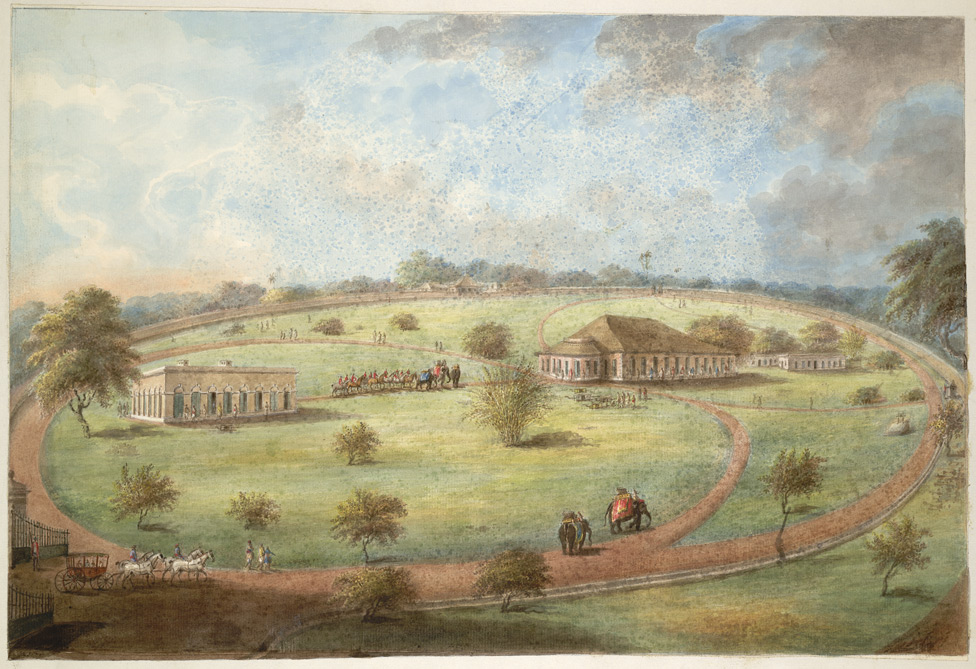
Five and a half year later Edmund was restored to duty.
"[Name] Heysham, Edmund . . . [Cadet] 1799 . . . [Ensign] Oct. 22, 1800 . . . [Lieutenant] July 13, 1803 . . . Cashiered Nov. 26, 1811. Restored Mar. - 1817." - from "Alphabetical List of the Officers of the Bengal Army"What caused the company to restore him to service? Since a court martial was needed to cashier him, would it take a court martial to restore him? Afterwards Edmund was given a pension.
"Pensions, 1st May 1817.And finally,
. . .
Heysham, Mr. E., late Lieutenant, Bengal Establishment . . . L40" - from "Minutes of Evidence Taken Before the Select Committe on the Affairs of the East India Company"
August 1817. "East-India House . . . Lieutenant Heysham, late of the Bengal Establishment, has been restored to the service." - from "The Asiatic Journal and Monthly Miscellany," Wm. H. Allen & Co.
Edmund apparently took ill around 1819, if not before. Especially in this early era, the sub-continent was a graveyard for Europeans who died from "fevers" at an alarming rate. His life out of the service may have caused this debilitation. However, he was on the list of Pensioners, not the list of Invalids.
"[Name] Heysham, Edmund . . . [Cadet] 1799 . . . [Ensign] Oct. 22, 1800 . . . [Lieutenant] July 13, 1803 . . . Cashiered Nov. 26, 1811. Restored Mar. - 1817. Pensioned in India 1819." - from "Alphabetical List of the Officers of the Bengal Army"I thought he was already on a pension as of 1817, per the above. Maybe it was just a change in type.
1819: "Aug. 28.--Mr. Heysham, formerly a lieut. 11th NI is admitted to the pension establishment, and will draw the allowances of a capt. of inf." - from "The Asiatic Journal and Monthly Miscellany" of March 1820A soldier placed on the Invalid Pension Establishment would be due a pension payment for his service related illness or injury.
"Bengal Military Establishment, continued
Bengal Casualties Since Last Publication
[Corps] 11th nat. Inf . . . [Rank] Captain . . . [Name] Edmund Heysham (Pensioned) . . . [When] 1819 . . . [Where] India" - from the "East-India Register and Directory" of 1819
Then, just months later:
1819: "Deaths . . . [Dec] 20, at Kishnaghur, Capt. E. Heysham, Bengal army . . ." - from "The Asiatic Journal and Monthly Miscellany" of June 1820Kishuaghur [Krishnagar], on the banks of the Jalangi river, was the administrative headquarters of the Nuddea (Nadia) district of British India, in the Presidency of Bengal. It was just north of Calcutta. It was the home of the Rajahs of Nadia. The battle of Plassey was fought nearby in 1757. See also,
"[Name] Heysham, Edmund . . . [Cadet] 1799 . . . [Ensign] Oct. 22, 1800 . . . [Lieutenant] July 13, 1803 . . . Cashiered Nov. 26, 1811. Restored Mar. - 1817. Pensioned in India 1819. Died Dec. 20, 1819, at Kishuagor" - from "Alphabetical List of the Officers of the Bengal Army"
The adminstration of Edmund's estate:
"Supreme Court of Judicature at Fort William, in Bengal(22) Frances Heysham (1778)A true and perfect schedule of all Estates, the Administration of which was committed to the Registrar of this Court . . . since the last Report on the 1st day of March 1821.
[Intestate Names] Captain E. Heysham - [Amount of each Estate in Cash] 210 Rs. - [To whom paid] Paid over to James Morris, assignee of a bond executed by the said Captain E. Heysham, to Messrs. Bush and Co. in part satisfaction of the principal, viz. sicca rupees 6517, secured by the said bond of the deceased, bearing date the 2d April 1812." - from "The London Gazette" of 1822
She was born on 11 June 1778 and christened on 8 July 1778 in Little Munden, Hertford, England. Frances Heysham of Little Munden, Herts, married John G. Wood in 1800 in St. Peter le Poer, the isle of Guernsey - from "Pallots Marriage Index for England 1780-1837."
Frances died on 17 July 1858.
1858. Obituary: "July 17. At Woodford, Essex, aged 80, Frances, relict of John Wood, esq., of Walthamstow, and dau. of the late Rev. Edmund Heysham, Rector of Little Munden, Herts." - from "The Gentleman's Magazine"They had at least two children,
Edmund Heysham Wood, "eld. s. of J. Wood, of Elm House, Walthamstow . . . ", married Sophia, the third daughter of the late John Branton Esq. of Higham-hill, Waltahmstow on 25 October 1828. Edmund Heysham Wood, citizen and clothworker, was the Master of the Clothworker's Company of London in 1870. Was he in that trade, or was this, at this late date, more like the Rotarians?
Edmund had broad interests. In advertisements in "The Law Times" of 1871, "The Athenaeum" of 1874, and in "The Navy List" of 1887, Edmund H. Wood, Esq. or E. Heysham Wood, was listed as a Director of the Union Assurance Company. On 12 April 1889 "Stephen Soames, Esq., Edmund Heysham Wood, Esq., Sir John Whittaker Ellis, Bart., M.P., and John Mews, Esq." were chosen as Directors of the Union Society, a fire insurance company. Edmund's term was to expire in 1892, but in 1890, he died.
"Mr Edmund Heysham Wood-Besly Formerly Wood late of the Stock Exchange and of 37 Kensington Gardens Square" died - from "The Illustrated Londown News" of Christmas, 1890I suspect he took the Besly name for inheritance purposes. An E. H. Wood changed their name to Wood-Besly on 23 August 1890. (23) Lieutenant Colonel Herbert W. Wood (1809)
Of the Indian Army. In the 1861 census of Cheltenham, Gloucesteshire as Herbert W. Wood, 52, Lieut-Colonel Indian Army. Living with him was his wife, Maria L., 41, and children Sophia E., 19, Reginald W., 13, and Frederick A., 6.
(24) Reginald Walter Heysham Wood (1847)I have a Reginald Walter Heysham Wood, son of LCOL H. W. Wood, Lansdown Terrace, Cheltenham, who was born in July 1847. In the 1871 census of Hammersmith, London, as Reginald W. H. Wood, 23 [1848], a Government clerk, of Cheltenham, the son of Herbert W. Wood, 62 [1809], Lieut-Colonel late Indian Army, of Middlesex, London.
I also have a German text of 1908 that refers to,
"Reklamant: Die Filiale der Firma Jardine Matheson & Co., Hauptagentur der China Sugar Refining Company, vertreten durch ihren Prokuristen, den englischen Staatsangeherigen Reginald Walter Heysham Wood." - from "Das Japanische Prisenrecht in Seiner Anwendung im Japanisch-Russischen."
[Claimant: The branch of the firm Jardine Matheson & Co., head agency of the China Sugar Refining company, represented by its authorized signatory, the English citizen Reginald Walter Heysham Wood.]
Reginald died on 19 March 1906. A notice was put into the London Gazette by the firm of Crosse and Sons, Solicitors, attempting to locate a Herbert William Wood, a nephew of Reginald. While it's not quite clear, Herbert appears to be his heir.
"Pursuant to an Order of the Chancery Division of the High Court of Justice, made in the Matter of the estate of Reginald Walter Heysham Wood, deceased . . . - from The London Gazette of 3 November 1914
I received the following email from Liz Gray.
"Hi Steve,(22) Henry Heysham (1780)Firstly, can I congratulate you on one of the most amazing things I have ever seen on the internet. I can not even imagine how much time it must have taken to create such a thing.
I don`t know if you are interested in any further information on a minor branch, but I am a descendant of the Frances Heysham-John Wood line. Their son Herbert William Wood married Maria Louisa Conwell (see a publication "The Conwells of Ballymilligan and Ballyriff). Their son Frederick Arthur Wood married Clara Emma Waterhouse and they migrated to Queensland, Australia. Their daughter Maria Louisa Wood was the only one to have descendants and she married George Thomas Gray. Their only child Dr George Lionel Gray A.O died this week leaving my brother and I, and three grandchildren.
I am on ancestry. com and my tree is "Wood" if you are interested.
Our family is now medical-starting from my father. I am a General Practitioner, one of my sons is doing medicine (and the other on wants to do it too). Our daughter wants to be an author.
The only other interesting relative is through the Lefroy line and Jane Austin. The movie "Becoming Jane" is about her romance with Thomas Langlois Lefroy who went on to become an Irish Chief Justice. We are descended from his sister Sarah.
Anything else you are interested in just ask.
Thank you again for your generosity in sharing such a wonderful work.
Regards, Liz Gray"
The son of Thos. Edwd. and Sarah Heysham of Little Munden, Hertfordshire. I suspect his father was actually Edmund; who else would it be in Little Munden? I have never found a Thomas Heysham in Little Munden. Henry Heysham was christened on 29 February 1780 in Little Munden, Hertford, England - from the LDS database. He probably died young.
(22) Caroline Heysham (1782)She was born on 1 February 1782 and christened on 27 May 1782 in Little Munden, Hertford, England. She died in April-June 1841 in Hertfordshire.
March-April 1841. Obituary: "Lately. At Hertford, Caroline, fourth dau. of the late Rev. Edmund Heysham, Rector of Little Munden." - from "The Gentleman's Magazine"I presume this means she never married. (22) Louisa Heysham (1783)
Louisa Heysham, the daughter of Edmd. and Sarah Heysham, was born on 26 April 1783 and baptized on 19 July 1783 in Little Munden.
(22) Frederick Heysham (1786)Frederick Heysham, the son of Edw. and Sarah Heysham, was born on 10 August 1786 and christened on 30 September 1786 in Little Munden, Hertford, England - per the LDS database.
I don't know what Frederick did with his short life, if he went to school, got married, or had children.
Frederick died in 1816, at the age of 30.
Heysham, Frederick - 1816 - UMS/ADMIN/41q - Probate of the will of Frederick Heysham, late of Little Munden Co. Herts., gent, proved by the executor, Rev Edmund Heysham, clerk, 6th April 1816." - from Manuscripts at the Norris MuseumFrederick's executor was his father. (22) Mary Heysham (1789)
She was baptized on 25 January 1789. She first married John Brown on 20 April 1811 in Little Munden. Second, she married John Green on 4 December 1839 at St. Andrews, Herforforshire. He was the brother of Edward Green, above, the husband of her elder sister, Elizabeth Heysham.
(20) Robert Thornton (1700)Robert Thornton was the third son of Edmund Thornton and Elizabeth Heysham, baptized in November 1700. The cousin and co-heir of (20) Robert Heysham (1713), and brother of John Thornton and Giles Thornton Heysham. His mother, Elizabeth, died when he was 4 years old. When his father, Edmund, died Robert would have been only 8. I suspect he and his brothers were subsequently raised by their uncles, Robert Heysham, who died in 1723, and William Heysham, who died in 1716.
In 1727 Robert Thornton inherited £500 from his cousin, William Heysham Jr., upon the latter's death.
Before his great inheritance Robert Thornton was, according to his cousin's will, a brewer, of London. This may mean that he brewed the beer for his own pub, or that he ran one of the early commercial breweries. A book of the period says,
"Four kinds of beer are brewed in London, stout, common butt-beer, ale, and small beer. Stout is the strongest beer, brewed from brown malt; and is sold for forty shillings the barrel, or six pound the butt, from the wholesale cellar." - from "A Compleat Body Of Husbandry" by Thomas Hale, 1758Pale ale, for the aristocracy, and Porter, for the common man [Hey! I like a Porter], became popular about this time. Small beer was a low strength brew drunk throughout the day.
The will of Robert Heysham Jr., our Robert's cousin, dated 6 July 1734, gave Stagenhoe, in Hertfordshire, with other estates, which included those at Little Munden, to Giles Thornton of St. Botolph's, Aldgate, for life, with the remainder to his son, Robert Thornton the younger, for life, remainder to the first and other sons of the last named Robert successively intail male, upon their taking the additional name of Heysham, remainder to Robert Thornton the elder, Giles's brother. While it sounds like Robert Thornton was short-changed, he also inherited, via Robert Heysham, from the cousin of both, William Heysham. Note that in 1716 William Heysham had inherited an estate worth £17,000. From Robert Heysham's will,
"I do hereby Give and Bequeth unto my Dear Kinsman Robert Thornton the Elder late of London Brewer but now residing with me All the Estate whatsoever both Reall and Personall heretofore the Estate of my Kinsman William Heysham Esquire late of East Greenwich in the County of Kent deceased, Subject nevertheless to the payment and Satisfaction of such and so much of the Debts of him the said William Heysham as now remain and are yet unpaid and unsatisfied.Note that Robert Thornton had been the heir to William Heysham's estate if Robert Heysham failed of heirs, as he did. From William Heysham's will,
An I do hereby for my Self and my Executors Release [Exouerate] and Discharge him the said Robert Thornton and the said Estate late of the said William Heysham of and from all [Rummus] of money which have been any ways advanced and paid out of my own Estate or account of the Debts Legacys and ffunerall Expenses of the said William Heysham."
"Item. The rest and residue of my Estate in case I shall leave issue male . . . for want of such Issue unto the heirs of the bodye of my said Couzen Robert Heysham and for want of such Issue unto my Cosen Robert Thornton for and during the terme of his naturall life and from and after his decease unto the first Son of the bodye of the said Robert Thornton lawfully to be begotten and the heirs male of such first Son and for want of such issue to all every other the son and sons of the bodye of the said Robert Thornton lawfully to be begotten and the heirs male of their respective body and [garbled] the Elder of such Son and the heirs male of his bodye to [garbled] before the younger as they shall be in prioritye of birth . . ."Returning to Robert Heysham's will, if Giles Thornton and his son should fail of issue, the estate went to Robert Thornton.
. . .
And for default of such Issue [of Giles Thornton and his son Robert Thornton the younger] To the use of behoofe of the said Robert Thornton the elder for and during the Term of his natural life without Impeachment of or for any manner of [Wast].
And from and his decease To the use of behoofe of the first son of the said Robert Thornton the elder lawfully to be begotten and the heirs male of the body of such ffirst son lawfully issuing."
I believe that Robert Thornton did not assume the Heysham name, as his brother did, because that requirement only applied to the intailed portion of the estate, which he never inherited. An intail did not apply to the William Heysham estate that came to Robert Thornton via Robert Heysham. Note that William Heysham's wife, the already wealthy Sarah Perry, then living, did not receive his estate because she had been taken care of in their marriage settlement.
According to the citation below, Robert had retired from London and moved in to the Stagenhoe estate with his cousin, Robert Heysham Jr., before the latter's death in 1734. This may reflect Robert Heysham's realization that he was failing.
The following describes the inheritance [or sale] of The Grange, a home of the William Hooker family, to William Heysham, the husband of Diana Hooker. The home was willed to his cousin, Robert Heysham Jr., upon his death. In 1735 the house passed to Robert Thornton [Heysham]. The house is located just west of the Royal Observatory at Greenwich. It is sited to take advantage of views over the park. Sounds like a nice neighborhood. According to the citation below, Robert had a son, John Bigge Thornton.
"The Grange is so called from the supposition that it occupies the site of the grange or farm of the monastic convent in Greenwich originally governed by Ghent Abbey in Flanders, but latterly a sub-house of Sheen Abbey, near Richmond, Surrey.5 After alienation to the crown under the Reformation the houses seems to have been turned over to use by officials serving the court at Greenwich Palace and was then known as Paternoster Croft.6 With some twelfth-century fabric retained, it was first substantially rebuilt, altered or enlarged in 1562 by Edmund Chapman, who from 1568 was Elizabeth I's Chief Joiner.7
By the time of the mid eighteenth-century works that are the subject of the article, The Grange had been in the same extended family's ownership for just over 100 years. In the process it regressed from a principal to a subsidiary out-of-London house, and then a let one. This had ushered in a period of decline, advancing an eventual process of development on part of the site. That in turn proved a catalyst to arrest the decline of the old house, as it was updated in the same building campaign, plausibly in preparation for its sale in 1774.
THE PREVIOUS HISTORY OF THE PROPERTYThe freehold had been bought in 1673 by Sir William Hooker [Lord Mayor of London], who had already been tenant since 1662, according to the rate books.8 Hooker's holdings in the area also comprised a group of 15 houses in London Street and Gang Lane (later called Stockwell and Heathgate Street), all of which were regarded as part and parcel with the Croom's Hill property, as they remained interlinked in many of the subsequent deeds.9
In his will Hooker had left the associated Greenwich properties to his eponymous son, who in 1713 sold them to William Heysham, MP, evidently a connection, as his wife Diana had formerly been a Mrs. Hooker.10 The Grange then descended to William Heysham's first cousin, Robert Heysham [his uncle Robert's son],11 and from him to a mutual cousin, Robert Thornton the elder, late of London, brewer," in 1735.12 In the later 1760s, during the tenure of his son, John Bigge Thornton, the plot for May's Buildings was leased out and The Grange itself was updated.13
At the time of Robert Thornton the elders inheritance he had retired from London and was already living with his cousin Robert Heysham at the Thornton-cum-Heysham . . ." [pg 262]
. . .
THE JOINT CAMPAIGNAs will be shown below, the development of May's Buildings must have been well in train by the time of the surrender of the lease on The Grange, even though Articles of Agreement concerning the scheme were not signed between John Bigge Thornton and Henry May, a distiller, until the following December.22 For a peppercorn May leased for one year from the ensuing Lady Day a parcel of ground slightly up the hill to the south of The Grange, on which May was 'to build one or more ... dwelling houses ... provided that one be fifty feet in front or two of half that dimension thereon in manner.' In return, provided the house or houses 'be raised and covered in' before the expiry of the year's lease, Thornton undertook to grant May thereafter 'a good lease of the whole said piece ... of ground and the said house or houses so intended to be built' for a term of 82 years at £30 10s. per annum." [pg 264]
. . ."The chronology of the Wiggens family's involvement is as follows. First, a Thomas Wiggens occupied The Grange in 1771-77 (with a part-year break in 1776) as the first long-term resident following the presumed building campaign there (see Appendix B). In August 1774 it was probably the same man who bought the freehold from John Bigge Thornton,27 and so became the ground landlord of May's Buildings, which was then nearing completion on part of The Grange grounds. One and a half years after purchasing the freehold, in January 1776, Thomas Wiggens mortgaged in sums of £1,800 and £700 from two different parties in one indenture and the sealing of the document was witnessed on the reverse by one . . ." [PG 276]
Notes1 Nikolaus Pevsner, The Buildings of England, London volume Two, except the Cities of London and Westminster, Harmondsworth, 1952, 154.
2 But the interiors of May's Buildings have suffered from the effects of lateral conversion into flats, entailing the destruction of its original interiors and plasterwork. I have latterly gained access to the common parts and discovered Gothick detailing in cornices and half-landing soffits. Apparendy one bedroom retains its decorative plaster ceiling, but I have not seen it.
3 Pevsner, loc.cit..
4 Nikolaus Pevsner and Bridget Cherry, The Buildings of England, London 2: South, Harmondsworth, 1983, 267. The initials MK in the gazetteer entry denote a contribution from Michael Kerney.
5 Beryl Platts, 'The oldest road in London? Crooms Hill, Greenwich-1', Country Life, CXL, November 17 1966, 1262. However, Platts also considers the alternative possibility that The Grange might be the property occupied by a 'messuage or barn' of Paternoster Croft, bought from the Crown by Jerome Lanier in 1611.
6 Idem; but London, Woolwich Arsenal, Greenwich Heritage Cener [hereafter GHC], Crooms Hill (anonymous and undated typescript note), argues that Paternoster Croft was the adjoining property to the north.
7 Platts, loc. cit.. According to information from Mr. Nicholas Elliott (owner of The Grange until 2002), Chapman was the son of a ship master of Deptford, a rich shipbuilder, a friend of Drake, and, as Chief Joiner from 1568, in charge of naval shipbuilding under Elizabeth I.
8 GHC, rate books, parish of East Greenwich [hereafter GHC, rate books]; ex. inf. Neil Rhind (see Appendix B, above).
9 Mr Howard Slight, privately owned property deeds relating to The Grange [hereafter Slight, and using the lawyers' sequencing numbers later-annotated in red crayon], doc.3-4 (1734) and doc.8 (1774).
10 The inheritance and subsequent sale both cited in Slight, doc.8. The indenture of this sale has not survived but it is recited in the subsequent deeds [idem]. At first it might appear that Hooker was selling out of the family, as The History of Parliament, which notes Heysham's second marriage, records no connection between Hooker and Heysham [Romney Sedgwick, The History of Parliament, The House of Commons 1715-54, London, 1970, II, 136-37). Indeed Heysham's will, made in 1727, makes it clear that the maiden name of his then wife Sarah (whom he married in 1719) was Perry [Slight, doc.2; the date of marriage is given in Sedgwick, loc.cit.]. But he was first married to a Mrs. Diana Hooker, at St. Luke's, Old Charlton, Kent, on 26 February 1712, by special license from the Bishop of Rochester [ex.inf. Neil Rhind, extracted from GHC, Old Charlton parish registers]. So at the time of purchase he was buying from the family of his earlier wife's first husband."
11 Slight, doc.4 (1734).
12 Slight, doc.5: "Attested copy of Robert the son's will' of 1734. Robert Heysham was still alive on 3 July 1735, the date in an attested copy of a 'Recovery with double voc'[Slight, doc.6]."
13 GHC, uncalendared deeds collection, Croom's Hill [hereafter GHC deeds, and using the lawyers' sequencing numbers later-annotated in red crayon], doc.14: 'Articles of Agreement' of 1766.
14 Robert Thornton the elder's retirement from London to Stagenhoe occurred between 13 May 1734 when he is described as 'of London' and 6 July of the same year when he is described in Robert Heysham's will as 'late of London but now residing with me."
15 Robert Thornton is thus found to have inherited Stagenhoe from the Heyshams, but they in turn had inherited it by marrying the heiress daughters of an earlier Edmund Thornton [sic]. The two families repeatedly intermarried, both having originated from the environs of Lancaster (see Appendix C, above). Nikolaus Pevsner and Bridget Cherry, The Buildings of England, Hertfordshire, Harmondsworth, 1977, 330, lists Stagenhoe, in the parish of St Paul's Walden, as rebuilt after a fire of 1737."
16 GHC, rate books, ex. inf. Neil Rhind.
17 The date when Falkingham took tenure [see Appendix B, above].
18 Slight, doc.y: the indenture cites the already existing tenures as 'one part in the occupation of the said Edward Falkingham. . . the other part now in the tenure of Major Otway with the yards and garden thereto belonging together also with the coach houses and stables ...',
19 Idem., endorsed on verso, 'This lease delivered up to Mr. Thornton 2 October 1766 and the rent due from Michaelmas 1765 from Charles Brett esqr'.
20 Slight, doc. 8.
21 So called to distinguish him from his nephew, 'only son' of his brother Giles Thornton, of St Botolph, Aldgate, London [Slight, doc.5].
22 GHC, deeds, Croom's Hill, doc. 14.
23 At some later date windows have been inserted in the north end wall, lighting an inserted stair at this end of the terrace.
24 Donald J. Olsen, Town Planning in London, the Eighteenth and Nineteenth Centuries, New Haven and London, 1964 and 1982, 46; Richard Gamier, 'Two 'Crystalline' Villas of the 1760s', Georgian Group Journal, VII, 1997, 16.
25 E.g., as at Beaver Hall, Enfield and Dover House, Putney Heath, both of which were also built in the 1760s [Gamier, op. cif., 9-25].
26 In the possession of Mr Howard Slight.
27 Geoffrey Beard and Christopher Gilbert (eds.), Dictionary of English Furniture Makers 1660-1840, [Leeds], 1986, 842." [PG 281-282]
- from "The Georgian Group Journal" volume 14.
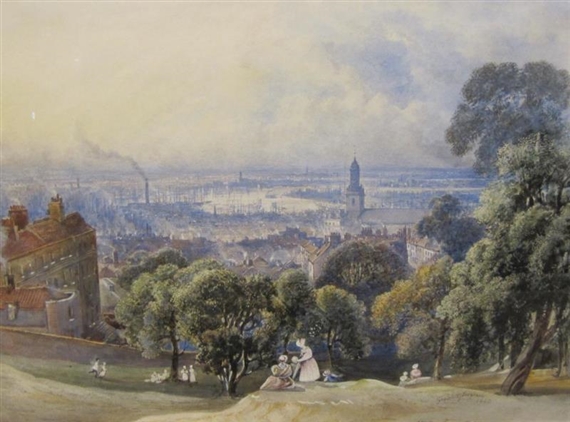 The Grange, in Croom's Hill, Greenwich, was acquired from Sir Lancelot Lake by Sir William Hooker (1612-1697) in 1662. He was a member of the Grocer's Company, Sheriff during the Great Plague of 1665 and fire of 1666, and Mayor of London in 1674. Pepys said of him, "a plain ordinary silly man I think he is, but rich." Sir William had a son, William Hooker esquire, who married Elizabeth, the daugher of John Turner, Sergeant of Law, was probably Diana's father. At left is a view of the Thames from Croom's Hill. The Royal Observatory, designed by Christopher Wren and built in 1676, is also on the hill. Croom's Hill road forms the southwestern perimeter of Greenwich Park.
The Grange, in Croom's Hill, Greenwich, was acquired from Sir Lancelot Lake by Sir William Hooker (1612-1697) in 1662. He was a member of the Grocer's Company, Sheriff during the Great Plague of 1665 and fire of 1666, and Mayor of London in 1674. Pepys said of him, "a plain ordinary silly man I think he is, but rich." Sir William had a son, William Hooker esquire, who married Elizabeth, the daugher of John Turner, Sergeant of Law, was probably Diana's father. At left is a view of the Thames from Croom's Hill. The Royal Observatory, designed by Christopher Wren and built in 1676, is also on the hill. Croom's Hill road forms the southwestern perimeter of Greenwich Park.
In 1736 Robert had been named an executor of his brother's will.
The Grange, Greenwich
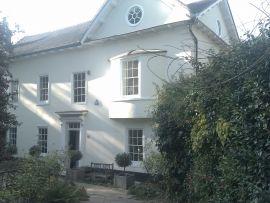 "A Grade II Listed Building Listing Text 1. 4412 CROOMS HILL SE10 (West Side) No 52 (The Grange) TQ 3877 26/G31 19.10.51. 2. Formerly known as "Paternoster Croft" and later "Grove House". House of mainly mid C17 appearance, with C18 alterations, concealing a much older core. Recent investigations have shown timber work possibly of C12. House was mentioned in a schedule of Ghent Abbey (to which the manor of Greenwich then belonged) in 1281, and was then said to have been restored in 1268. Edmund Chapman, chief joiner to Queen Elizabeth leased it from 1561-1568, It then became the residence of the Lanier family of musicians. In 1665 it was bought by Sir William Hooker, Sherriff and later Lord Mayor of London, who caused the gazebo (qv) to be built. Main block has South front of 2 storeys and attic, 4 windows. Moderately low pitched, tiled roof has pediment-like gable end at right with projecting eaves supported on purlin ends; and deep eaves soffit resting on ends of ceiling joists. Circular window in pediment. Stuccoed with rusticated quoins. Sash windows with glazing bars in near-flush moulded wood architraves. Right 1st floor window under gable in oriel bow. Door of 8 fielded panels, with cornice head and 3-pane rectangular fanlight, in 2nd bay from right. Doorcase of moulded architrave, sunk panel pilasters, pulvinated frieze and cornice hood on curved consoles. Right return, of 1 window, under gable end similar to front. windows in canted bay through 2 floors. On 1st floor 3 sash windows with glazing bars, the centre one long and opening to wrought iron balcony. On ground floor bay completely glazed. Mid-late C18 West wing projecting in front and running on behind main block. In front 2 storeys, 2 recessed sash windows. Stucco. Roof of moderately high pitch renewed in machine tiles." 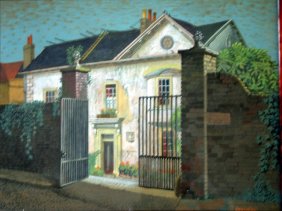
A painting of The Grange, circa 1900, left. Sir William Hooker
William Hooker came to Greenwich from London in 1665 to escape the plague. The house he bought at Greenwich had been one of the chief properties of St Peter's Abbey at Ghent. It was The Grange, in Crooms Hill, and he lived there in considerable style with his wife, son and three daughters. He lived at The Grange, Crooms Hill, until his death in 1697, after which, his son, William Hooker M.P., continued residence until 1713. The house found its way to William Heysham via his first wife, Diana Hooker, and thence to his cousin, Robert Thornton. |
From the UK Archives are the records of Houghton, Craven and Co., Solicitors of Preston, Lancashire:
24 September 1738 - "Release of 140 pounds: (i) Giles Thornton Heysham of Stagenhoe in the parish of St. Paul's Walden, co. Hertford, esq., cousin and heir of Charles Richard Thornton, late of Preston, gent., decd., who was the only son and heir of John Thornton late of Preston, esq., decd., Anne his wife and Robert Thornton of Stagenhoe, gent., his brother, (ii) Charles Gibson of Preston, gent., (iii) John Walshman of Preston, innkeeper -- 2 closes called the Marfield or Narfield and further field, 6ac., in Preston, on the north side of a lane leading to a place called the two yates formerly in the possession of Anges Patten, widow, William P., her son and John Melling, late in the possession of John Thornton -- "
Since we know that Robert had a wife, Elizabeth, and a son born in 1744, I've looked for marriages for him circa 1740-1743. Bridget Maier writes,
"Their [Elizabeth, Sarah and John Bigge Thornton] father, Robert Thornton, had married their mother, Elizabeth Bigge, on 5th June 1740 at Edworth, Bedfordshire. Typically of the London merchant class he was almost twenty years older than his bride who was born between 1715 and 1719 when her mother died. I am very interested to find his background from your site. He is described as "of Breachwood Green Hertfordshire" in 1749 in one of a series of documents listed at the National Archives. He died in 1751 and was buried at Kimpton."Rob Thornton married Eliz Bigg on 5 June 1740 in Edworth, Bedford - from "England Marriages, 1538-1973" at familysearch.org.
"Elizabeth Thornton of Lawrence End died in 1774 giving her portion of £2000 to her unmarried daughter, Sarah, Elizabeth having already had hers, and, after gifts of personal items to Sarah and legacies of £25 each for mourning to Elizabeth and her daughter Elizabeth then aged 13, all the rest of her property to John Bigge Thornton.
. . .
The National Archives Discovery Site, recites that Elizabeth Thornton, the daughter of Thomas Bigge and of Elizabeth Cotton, one of two daughters of William Cotton of Turner's Hall Harpenden Hertfordshire, inherited property in Hertfordshire from her mother, Elizabeth Cotton, who had died leaving only one daughter. Thomas Bigge seems to to have been from Lawrence End, in the parish of Kimpton. Many of the Kimpton parish registers can be seen on the Findmypast website and show other, slightly less prosperous, Bigges in the parish."
In 1768, when his brother Giles died, Robert was noted to have already died.
Robert's chidren were probably,
(21) Elizabeth Thornton (1741)
(21) Sarah Thornton (1742)
(21) John Bigge Thornton (1744)
Bridget Maier writes,
"Mrs Cumyns was born Elizabeth Thornton and I believe she was the Elizabeth Thornton baptised at St Alfege in Greenwich in 1741. She had a sister, Sarah, born in 1742 and baptised in the same church and was also the sister of John Bigge Thornton who was baptised of course in Kings Walden in 1744.The children of George Cumyns and Elizabeth Thornton of Kensington Square, London included,
. . .
John Bigge Thornton [her brother], by his PCC Will, left his books and papers and his property in Kent, which I was interested to see detailed on your site, to his sister Elizabeth Cumyns, subject to a bond of £1000 to William Hayley. She promptly appears to have sold the property at Royal Hill and Royal Place, Kent, see National Archives Discovery Site (searching under Cumyns).
She is also referred to in the "Memoir of the Life and Letters of William Hayley" by John Johnson (1823) as having a bad husband. She had married George Cumyns, a linen draper of High Holborn, at St Andrew Holborn, his parish church in 1760 with her mother and grandfather witnessing the marriage. She then had eight children in the 1760s all christened at St Andrew's Holborn, and it does appear from the cessation of the childbearing from 1770 that they did indeed separate and that she moved to Kensington. The burials of four of her children, the first John Thornton, and her daughter Sarah within a month of one another in 1766 as infants, her son the second John Thornton Cumyns at age 8 in 1774 and her eldest daughter, Miss Elizabeth Cumyns from Kensington, at age 21 in 1782 at are shown in the Kimpton Register, as is that of her husband in 1780. He had died very much at the same time as her brother, as Hayley's correspondence also notes.
There are a few children so far missing from any future records, the second Sarah born 1770 but dead before her sister Elizabeth in 1782, and her two sons George and Thomas. They may have been buried in Kensington. The only surviving child of whom any adult trace can be found was Robert Heysham Cumyns who went to Rugby school and on to All Souls College Oxford in 1786. He went into the church and had a succession of parishes and appointments in Portsmouth, which was a very rough naval town but expanding into more genteel Southsea during his time there. He was also head of Portsmouth Grammar School. His former pupils appear to have arranged his funeral in 1838 and advertised for his relations suggesting that none were known to them (British Newspaper Archive website). He does not seem to have left a Will.
Robert married in 1807 at Barton in the Clay, Bedfordshire (register calls him Robert Heysham) to Maria Greenstreet, a niece by marriage of his aunt, Sarah I believe, but the marriage was annulled in 1809 within three years because of his inability to consummate it. (Greenstreet vs Cumyns 1809).
His obituary mentions that he was a good son and I would hazard that he may only have married following his mother's death. Mrs Thrale mentions Mrs Cumyns showing her a lump in her breast in 1779 and Mrs Thrale's expectation of her death; the change subsequently in the arrangements for the Thrale daughters has led many to think that Mrs Cumyns died shortly afterwards although Mrs Thrale does not note that she did. But I can't see a record of any burial; in particular, I would have expected her to have been buried at Kimpton at that time with her husband, brother, mother and children. An Elizabeth Cumyns married in Kensington in 1787 although I have not yet seen the register. She may have ceased to take in pupils because she had the proceeds of the remaining Greenwich lands, even if John had disposed of some and given leases of others. She may have retained some part of the property and lived on the rents, but, whatever her assets were, on her remarriage any remaining assets will have passed under her coverture to her husband, unless they were then settled on her children.
The Rugby school register refers to the late George Cumyns and to Mrs Cumyns as parents of Robert which also suggests that she was alive when Robert went there after his father's death, and I would suggest that she also lived to be known by Robert's friends in Portsmouth. Unfortunately, her new husband was called William Thomson and I can't yet trace either of them after the marriage. "
Bridget Maier writes,
"Elizabeth Thornton of Lawrence End died in 1774 giving her portion of £2000 to her unmarried daughter, Sarah . . .(21) John Bigge Thornton (1744)
. . .
John Bigge Thornton's other sister, Sarah, was unmarried and aged 37 at the time of his death. She, like John, had had a legacy from their mother's cousin Mary Tombes (living by then in Shrewsbury) in 1779 (John got £800, Sarah got £300), and also was bequeathed Mary's common clothes, excluding her two best dresses and laces, which may suggest some dependent status. It was she who inherited the land in Hertfordshire including Lawrence End from her brother John Bigge Thornton as part of his residuary estate. I note that a Revd. John Hawkins was "of Lawrence End" at the time of his death in 1820. I believe that Sarah married him at St Martin's in the Fields church in 1792 and that she was the Sarah Hawkins, wife of Rev, age 52, Lawrence End, buried at Kimpton in 1795.
Revd. John Hawkins (St Paul's school and Peterhouse, Cambridge) was from a Bedfordshire/Hertfordshire family, his father (Revd. Francis Hawkins), and grandfather having, like him, having been Vicar of Hinton Gobiot, but he also had various, apparently small livings. He was not the vicar of Kimpton. He, described as of Lawrence End, left his estate to his niece, Maria Greenstreet on his death in 1820 She, by then "of Lawrence End", died in 1835 age 56, and left her estate to her brother Colonel John Greenstreet, later General, of the Bengal army. Clearly her marriage, put forward by the family for Robert, after his mother's death perhaps, to an impoverished relation, then age 28, had promptly failed and she was provided for by her uncle instead. Her sister Frances Greenstreet did not benefit under Revd John's Will and so was left all her own property by her mother Anna Maria Greenstreet on the basis that Maria, like her brother John, was well provided for (PCC Will proved 1828 dated 1822). Anna Maria Greenstreet nee Hawkins (the sister of Revd. John Hawkins) was a clergyman's daughter who had been widowed with three surviving children to bring up since 1787. It is possible that an agreement to leave Revd. John's property to Maria was part of Maria Greenstreet's marriage or annulment settlement.
There were various other members of the Hawkins family baptised at Kimpton in the late 1790s onward. They were the younger members of the family of Major Henry Hawkins of the Madras army, the younger brother of Revd. John. I wonder if Major Henry moved to Lawrence End with his family after Revd. John was widowed, as his older children were baptised elsewhere in England, and if he and his family lived with his widowed Revd. John or in his property. Revd. John himself may have moved somewhere more convenient; it is only his Will that refers to him as being of Lawrence End.
Major Henry does not make reference to ownership of Lawrence End in his Will (PCC 1813) although he is described as "of Lawrence End," but to the property in his wives' marriage settlements."
Poet, lawyer and Cambridge Don. John Bigge Thornton, the son of Robert and Elizabeth Thornton, was christened on 8 August 1744 at Kings Walden, Hertfordshire, England - from "England Births and Christenings, 1538-1975" at familysearch.org. Known as the son of Robert Thornton "the elder" to differentiate the latter from his nephew who inherited Stagenhoe manor.
John attended Eton college circa 1757. Was he a published poet while there? The following is from an anonymous review of Musae Etonenses Seu Carminum Delectus by William Herbert (1778-1847). The collection was the work of the 17-year-old William Herbert -- his first book, in three volumes, edited while a student at Eton, was written in Latin and Greek. One of the poems seems to be by our Thornton.
"As we read through these volumes, we marked down as eminently good, where all were above mediocity, the poems beginnning at pages 1, 26, 52 . . . 266, 271, 276, of the second volume; and pages 14, 20, 38, of volume the third*; and then, and not till then, turned to the Indexes to acquaint ourselves with the names of the authors, when we were agreeably surprised with finding among the titles, those of Fox, lord North, Harris, sir James Macdonald, Thornton, Joddrell, George Heath, and Lambton.2 We shall present our readers, led rather by the merit of the compositions than by the greatness of the names, (although as curiosity would be necessarily gratified, this too must be allowed to have some weight) two exercises, the first by lord North, the second by Mr. Fox; the first distinguished by wit and fluency of versification truly Ovidian, the second by the manly and natural tenderness of Tibullus . . . "
. . .
2 . . . Rome, and was lamented by Hume; "Thornton" is perhaps John Bigge Thornton (c 1746-80);" - from "The Collected Works: Shorter Works and Fragments", volume 11, pg 43
While the following seems to say that John was the son of Laurence Erich, I think this actually is a typo for Laurence End [Lawrence End], a farm or locale in King's Walden, Hertfordshire.
"THORNTON, JOHN BIGGE. Adm. pens, at Trinity Hall, July 31, 1762. [S. of Laurence Erich, of Herts. School, Eton.] Matric. Michs. 1763; Scholar, 1764; LL.B. 1780. Fellow, 1779-80. Adm. at Lincoln's Inn, Mar. 4, 1764. Died Jan. 1780. 6, [Eton Coll. Reg.; Inns of Court.)" - from "Universtiy of Cambridge Alumni"I recently found a reference to a letter from a John B. Thornton, the friend of the poet William Hayley, dated "Laurence End, 30th of May 1779 . . ." - from the "Memoirs of the Life and Writings of William Hayley." See more about Hayley and John Bigge Thornton below.
1764 "May 4 John Bigge Thornton, of Laurence Ench [sic], Herts, Esq." - from the Lincoln's Inn Admission RegisterI have not been able to find a man named Laurence Erich, Ench or End.
|
Admitted Pensioner (adm. pens). An undergraduate student without financial support from his or her college, being neither a scholar nor a sizar. Sizar (siz.). An undergraduate member admitted under this designation and receiving an allowance from the college to enable him to study. Matriculated (matric.). Be enrolled at a college or univesity. Scholar. LL.B. A diploma in law. Fellow. An honor distinguishing an old member of the college. For Oxford, Cambridge and Dublin universities, a member of the governing body of a college. |
John was called to the Bar in 1769. This was five years after being admitted to Lincoln's Inn, but eleven years before earning his LL.B.
"Council held on November 6th, 1769.
Six Benchers present.
Call to the Bar:
Alexander Thomson, Jeremy Bentham, and John Bigge Thornton." - from "The Records of the Honorable Society of Lincoln's Inn: 1660-1775"
John inherited The Grange, in Greenwich, sometime before 1768, when his father was noted to be dead.
In August 1774 John sold the freehold of The Grange."In his will [Sir William] Hooker [Lord Mayor of London] had left the associated Greenwich properties to his eponymous son, who in 1713 sold them to William Heysham, MP, evidently a connection, as his wife Diana had formerly been a Mrs. Hooker. The Grange then descended to William Heysham's first cousin, Robert Heysham [his uncle Robert's son], and from him to a mutual cousin, Robert Thornton the elder, late of London, brewer," in 1735. In the later 1760s, during the tenure of his son, John Bigge Thornton, the plot for May's Buildings was leased out and The Grange itself was updated."
". . . As will be shown below, the development of May's Buildings must have been well in train by the time of the surrender of the lease on The Grange, even though Articles of Agreement concerning the scheme were not signed between John Bigge Thornton and Henry May, a distiller, until the following December." - from "The Georgian Journal"
Bridge Maier writes of John's mother, Elizabeth Thornton,
"Elizabeth Thornton of Lawrence End died in 1774 giving her portion of £2000 to her unmarried daughter, Sarah, Elizabeth having already had hers, and, after gifts of personal items to Sarah and legacies of £25 each for mourning to Elizabeth and her daughter Elizabeth then aged 13, all the rest of her property to John Bigge Thornton. I had noted that he had been at Eton and Trinity Hall and was close friends with William Hayley who was also educated at both. Hayley's correspondence published in 1823 gives some of their joint history and correspondence up to the time of Thornton's death. It is interesting to note that they shared an interest in learning languages and in poetry. Hayley mentions Thornton's relationship to Edward Young and Frederick Young gave the affidavit to the Prerogative Court of Canterbury as to Elizabeth Thornton's writing of her Will in 1774 on the basis that he knew her well and could identify her writing and signature.
Trinity Hall was the college which tended to produce most of the "civilians", the advocates of Doctors' Commons, the court which dealt with Ecclesiastical and Admiralty matters under civil law. A few of the advocates, like the preeminent Lord Stowell, were also, like Thornton called to the Bar, qualifying them to appear as barristers in the common law courts. It is interesting to see that Thornton appears to have revived his interest in the law shortly before his death, when he appears already to have been in ill health. He must have applied to become a fellow of Trinity Hall, perhaps so he could go back into residence there , actually or technically, depending on the college's requirements, and so qualify to obtain his LLB."
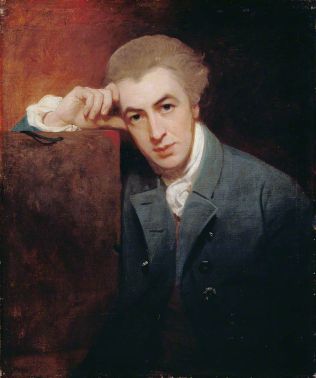 The British National Archives hold, at the Bodleian Library, 109 items of correspondence from John Bigge Thornton dated 1774-1777. The poet William Hayley, left, who was a schoolmate of John, was one of his closest friends and kept up a correspondence throughout his life. William and John went to Eton together in 1757 and to Trinity Hall, Cambridge in 1762. Hayley is best known as the friend and correspondent of William Cowper. See Making HayleyWorld: A New Form of Biography.
The British National Archives hold, at the Bodleian Library, 109 items of correspondence from John Bigge Thornton dated 1774-1777. The poet William Hayley, left, who was a schoolmate of John, was one of his closest friends and kept up a correspondence throughout his life. William and John went to Eton together in 1757 and to Trinity Hall, Cambridge in 1762. Hayley is best known as the friend and correspondent of William Cowper. See Making HayleyWorld: A New Form of Biography.
John was variously listed as of Welwyn, Hertfordshire and of Lincoln's Inn, London in 1774.
On 30 January 1779 John Bigge Thornton was appointed a Fellow of Trinity Hall, Cambridge and upon his death replaced by Henry Gaily,
"Fellows of the College [Cambridge]Fellows at the ancient universities, Oxford, Cambridge and Dublin, formed the governing body of their college. By the way, Peter Calvert was a Fellow of Trinity Hall from 1753 to 1777, resigning in that year, and Dean of the Court of Arches - from "Trinity Hall" by Henry Elliot Malden.
. . .
18. Johannes Bigge Thornton de Lawrence End, Herts., electus et admissus fuit Socius Jan: 30. 1779, in locum [in place of] Petri Calvert 1779
19. Henricus Gaily, LL.B., de Lincolns Inn, London, electus et admissus Socius 3 tio die Feb rii 1780 in locum Johannis Bigge Thornton 1780" - from "Warren's book [Collectanea ad collegium sive aulam sanctae Trinitatis in universitate Cantabrigiensi praecipue spectantia]"
John died of unknown causes on 6 January 1780, at the age of 36. William Hayley, a popluar poet of the day, wrote an elegy upon the death of his friend, John B. Thornton, Esq.J., "Verses to Thornton." - from "The Monthly Repository and Review of Theology and General Literature" of 1829.
The will of John Bigge Thornton, Barrister at Law of Lincolns Inn, Middlesex, was dated 16 February 1780. Bridget Maier writes,
"John Bigge Thornton, by his PCC Will, left his books and papers and his property in Kent, which I was interested to see detailed on your site, to his sister Elizabeth Cumyns, subject to a bond of £1000 to William Hayley. She promptly appears to have sold the property at Royal Hill and Royal Place, Kent, see National Archives Discovery Site (searching under Cumyns)."
I've found no indication of a wife or children for John.
I believe that both the Giles Heysham line, of the Merchants of Lancaster page, and the Thornton-Heyshams related here died out completely in the male line. All of the true Heyshams in England today are descendents of Giles' brother, John Heysham. They are of the Heyshams of India, the descendents of Lt. William Heysham of the East India Company army. The Mounsey-Heyshams of Cumbria are actually part of the Gubbins family, having assumed the surnames Mounsey and Heysham through the female line. There may be some Hayshams of Dorset and Somerset that spell their name Heysham, but they are not related. The only remaining Heyshams in America are actually the descendants of John Heesom, of Crofton, Yorkshire, whose relationship to the true Heyshams is unclear.